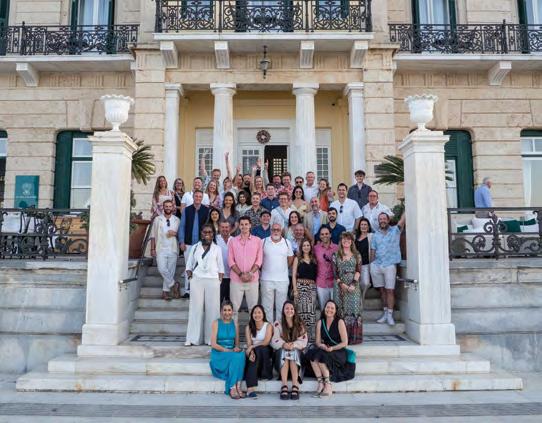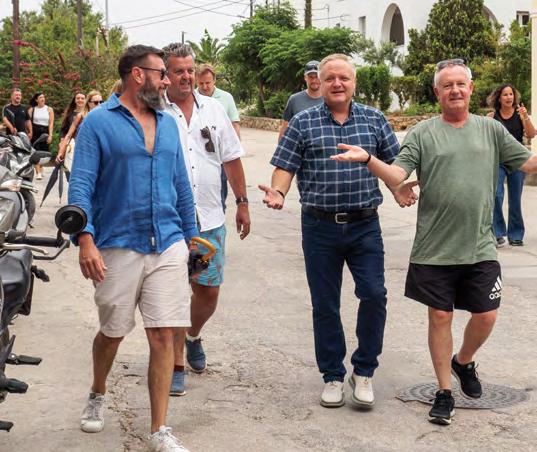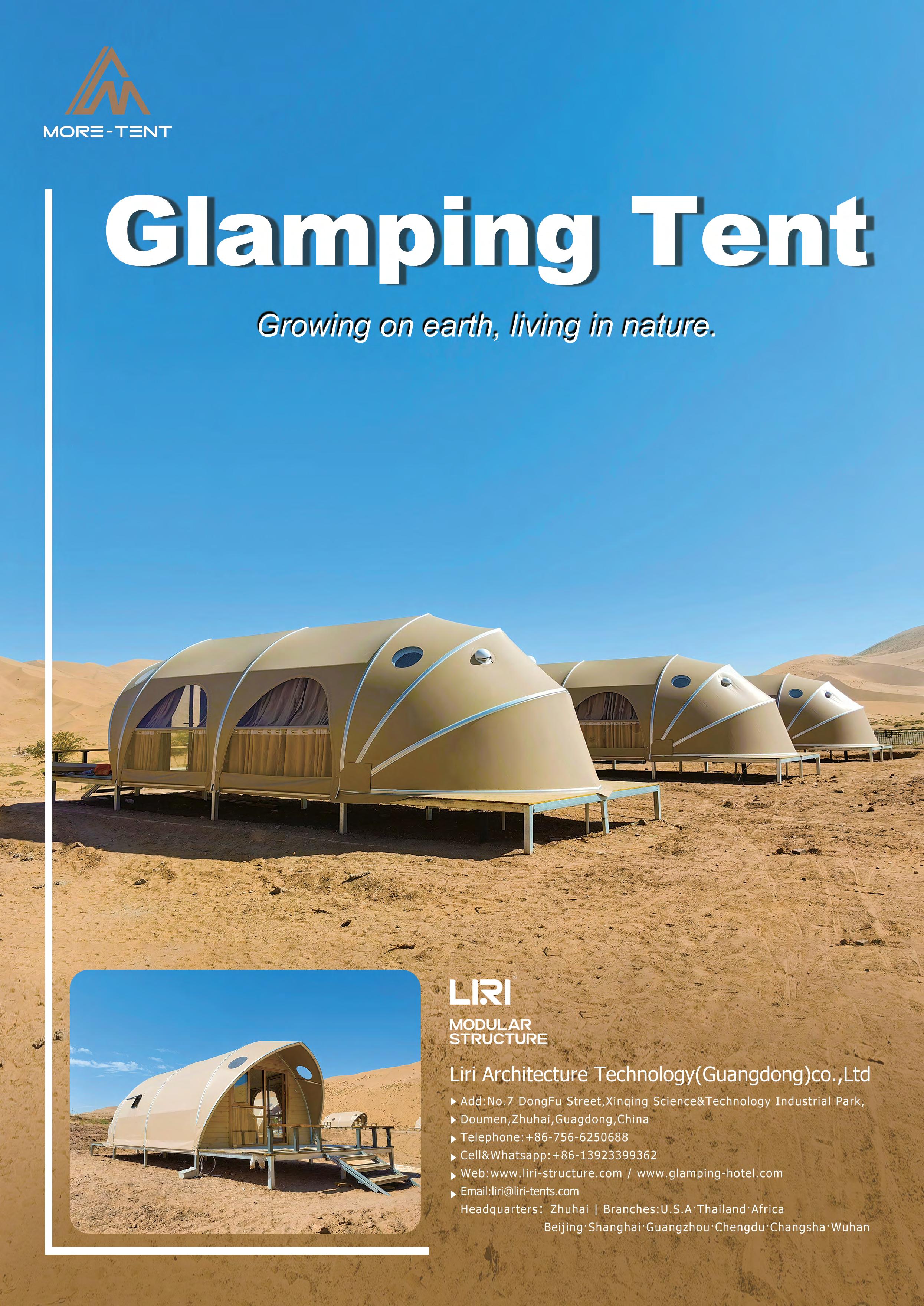

GlBUSINESSmping

Welcome to GlBUSINESSmping

Welcome to our July 2025 issue! There’s a little something for everyone in this edition, whether you’re running an established site or just starting to shape your vision.
First up, we’re looking ahead to The Glamping Show 2025. As the official publication of the show, I caught up with Dan Wiseman, the show’s exhibitions manager, to find out what’s in store. We’ve also included a preview of the seminar programme, which is curated this year by our own Steph Curtis-Raleigh. Expect practical tips, real-world experience, and conversations that reflect where the industry is headed.
We chat with the team at Kip and Nook, who share how they’ve built a strong sense of community through thoughtful design and a close connection to nature, and Vicki Jones reports from South Africa, where the glamping scene is having a real moment – there’s a lot to learn from how operators there are blending local landscapes with creative hospitality.
Crown and Canopy explore how rewilding isn’t just good for the land, it can also boost your bottom line. It’s a smart, sustainable approach that’s gaining traction. And if you’re working with smaller spaces, Charlotte Dawson shares her best interior tips for designing a shepherd’s hut that’s cosy, stylish, and guest ready. We’ve also pulled together a DIY moodboard for anyone in the early design stages that’s full of flexible ideas to help you define your look, whatever your brand style.
One year after his last article with us, Nick Purslow tells us how things are going at Posh Outdoors, from vision to reality, and all the work in between. We also speak to the team at Koto about their new floating houseboats and how they’re bringing calm, clever design to the water.
Finally, we have a round-up of some standout tent suppliers, with real case studies from global sites. And if you missed it, we’ve got a full review of the Eco Resort Network 2025 event in Spetses last month – a beautiful setting for a gathering full of fresh ideas.
Here’s to a successful season ahead – on land, water, or wherever your glamping journey takes you.
Annie
Editor, International Glamping Business 05 09 10 11 12 14 18 22 24 27 28 31 35 39
INDUSTRY NEWS
LETTER FROM GITA (UK)
THE GLAMPING SHOW PREVIEW
MEET THE NEWCOMERS
SEMINAR PREVIEW
KIP AND NOOK: BUILDING COMMUNITY
SOUTH AFRICA’S GLAMPING MOMENT
WHY WILD WORKS: BOOSTING ROI
INTERIOR DESIGN: ASK THE EXPERT
DIY INTERIOR DESIGN MOODBOARD
POSH OUTDOORS: THE GREAT HUSTLE
KOTO: HOUSEBOAT HOSPITALITY
TENT SUPPLIERS
ECO RESORT NETWORK REVIEW
International Glamping Business is published by: Upgrade Publishing. Registered address: 47 Oliver Close, London W4 3RL
Publisher: Upgrade Publishing, Steph Curtis-Raleigh. e: steph@upgradepublishing.com
Design: Dean Coulter, Design on Tap. www.designontap.co.uk www.glampingbusiness.com Instagram @thisisglamping Facebook @thisisglamping
Other Events:
The Glamping Show w: www.glampingshow.com e: dan.w@swanevents.co.uk
Glamping Show Americas w: www.glampingshow.us e: david@glampingshow.us Eco Resort Network w: www.ecoresort.network e: steph@ecoresort.network
published
permitted. No warranty is implied in respect of any product or trader mentioned herewith.
year.
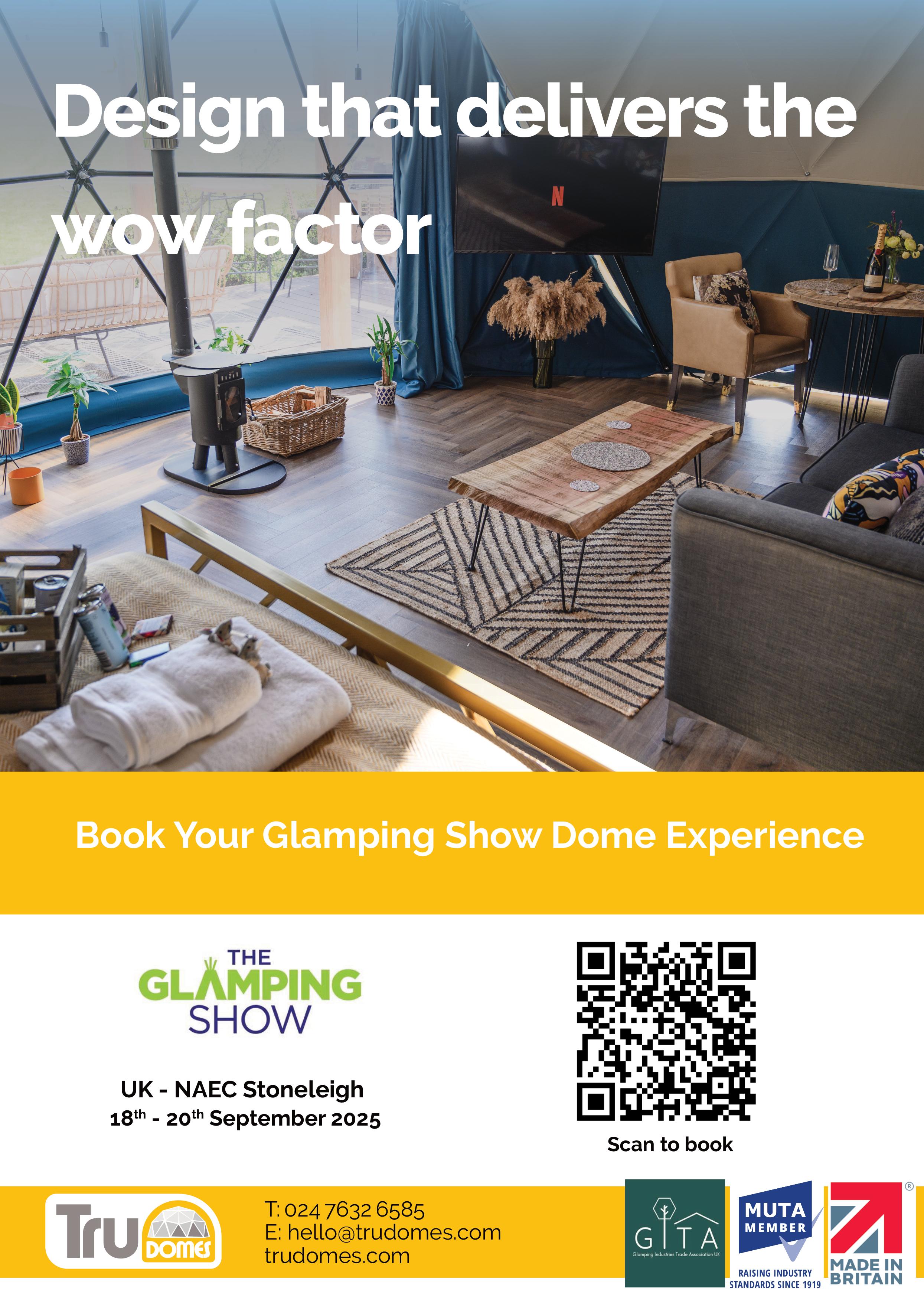

TREE TENTS UNVEILS THE BIRDHOUSE MODULAR
Tree Tents, creators of innovative outdoor spaces, proudly announce the launch of its latest creation: the Birdhouse Modular. This revolutionary new design redefines outdoor living, offering unparalleled flexibility, alongside serious ecocredentials.
Built with regenerative design principles at its core, and handcrafted in Tree Tents’ Sussex workshop, it offers a limitless range of customisation options that empower users to create spaces as unique as the landscapes they inhabit.
Whether for eco-tourism destinations, green retreats, or private sanctuaries, the Birdhouse Modular sets a new benchmark in adaptable, low-impact accommodation.
The Welsh Farm has been named the winner of the 2025/26 Wales Prestige Award for Best Glamping Experience.
Located in a remote part of the Welsh countryside, The Welsh Farm is known for offering dog-friendly, off-grid glamping stays with a focus on comfort, privacy, and nature.
The award recognises small and independent businesses that consistently deliver highquality service and receive strong customer feedback. The winner is ultimately deliberated by a panel of judges, but a lot of the decision is based on positive guest reviews.
Co-owner Beth Robinson said: “We’ve always put our hearts and souls into our glamping escapes. It matters to us that everyone has a wild, stress-free adventure here – with all the sprinkles of luxury and fencing needed for a memorable, safe and dog-friendly getaway.
“So, to win a Prestige Award for ‘Best Welsh Glamping Experience’ based on our guest reviews was the icing on the cake. We would
The Birdhouse Modular was born as a result of a request from eco-tourism pioneers WildComfort, based in the UK, who sought a long-lasting, stylish new offering for their guests, complete with en-suite. WildComfort are long-time hosts of the original Tree Tents Birdhouse, Outhouse and Airspace models. Last summer, they achieved an incredible 98% occupancy rate across all three of their Tree Tent accommodations.
The Birdhouse Modular redefines what it means to design an outdoor space. Modules are available in a wide range of sizes, functions and finishes, making it easy to create anything from a compact cabin to a full-scale retreat. Whether it’s a single-bedroom hideaway or a multi-room eco-lodge, users can design a structure that mirrors their vision.
Though handcrafted in the UK, each Birdhouse Modular is designed for flatpack delivery and simple assembly. A small team can install the entire structure in just one day, keeping build times and costs low. The lightweight yet durable frame is suited to flat decking or raised stilted platforms, ensuring minimal ground impact across varied terrain.
Crafted from responsibly sourced cedar, marine-grade plywood, aluminium and glass, the Birdhouse Modular is weatherresistant, low-maintenance and built to last – regenerative design in action. It’s thoughtfully made, easy to relocate, and engineered for a lifetime of sustainable use. The made-to-order, in-house approach reduces waste and overproduction, ensures the use of responsibly sourced materials and adapts as needs change. A modular plumbing system ensures simple, scalable water and waste management, without requiring disassembly of the structure. High-performance insulation and passive design principles improve energy efficiency across climates.
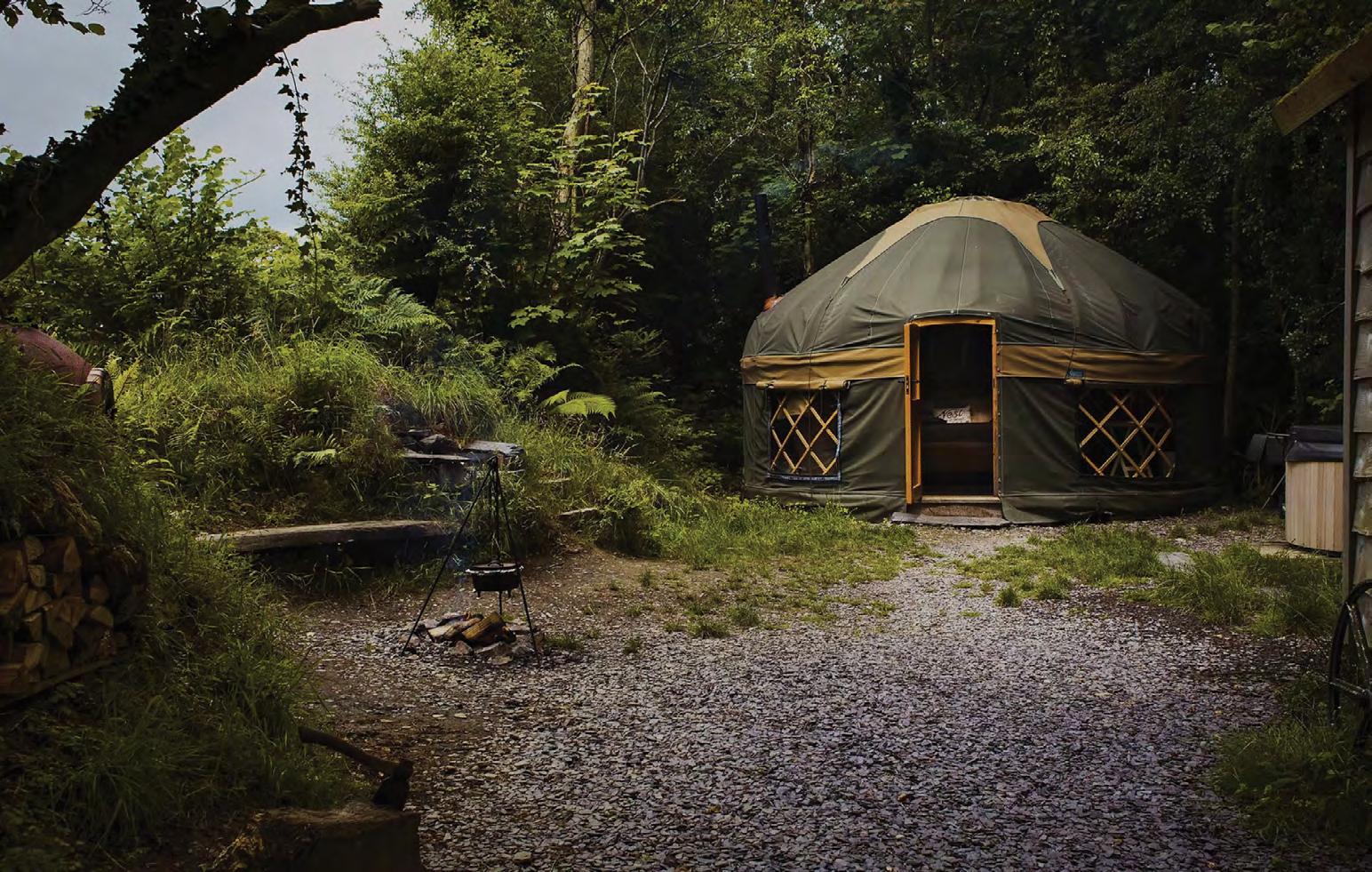
THE WELSH FARM WINS BEST GLAMPING EXPERIENCE IN WALES 2025
like to thank our incredible community who come back and stay, share, post, and shout about us.”
“Feedback like this makes every repair, every linen wash, every pizza oven re-build, every wheelbarrow full of wood loaded and stacked ready, a complete joy!”
The Welsh Farm continues to attract visitors from across the UK looking for peaceful, dog-welcoming stays surrounded by nature.
Beth Robinson will also be sharing her expertise in the seminar programme for The Glamping Show 2025.
Indian luxury glamping specialist LuxeGlamp has launched its first international outpost: LuxeGlamp UAQ, located within the pristine Umm Al Quwain Mangrove Reserve. This marks the UAE’s first eco-luxury glamping resort, and a significant step for the country’s growing sustainable tourism sector.
The retreat features ten glass-domed suites, each approximately 1,000 square feet, positioned on elevated wooden platforms over a 50-acre mangrove reserve. Every suite includes a private terrace, plunge pool, sauna, hammock, and sweeping views ideal for stargazing. Interiors use tempered glass, aluminium, and bamboo, blending recyclable materials with local design elements to create an atmosphere of understated luxury.
LuxeGlamp UAQ was designed to minimise ecological impact, featuring solar power, greywater management systems, and a strict no-single-use-plastics policy. With no permanent foundations, the resort prioritises preserving the delicate mangrove ecosystem it inhabits.
LUXEGLAMP MAKES INTERNATIONAL DEBUT IN UAE’S UMM AL QUWAIN
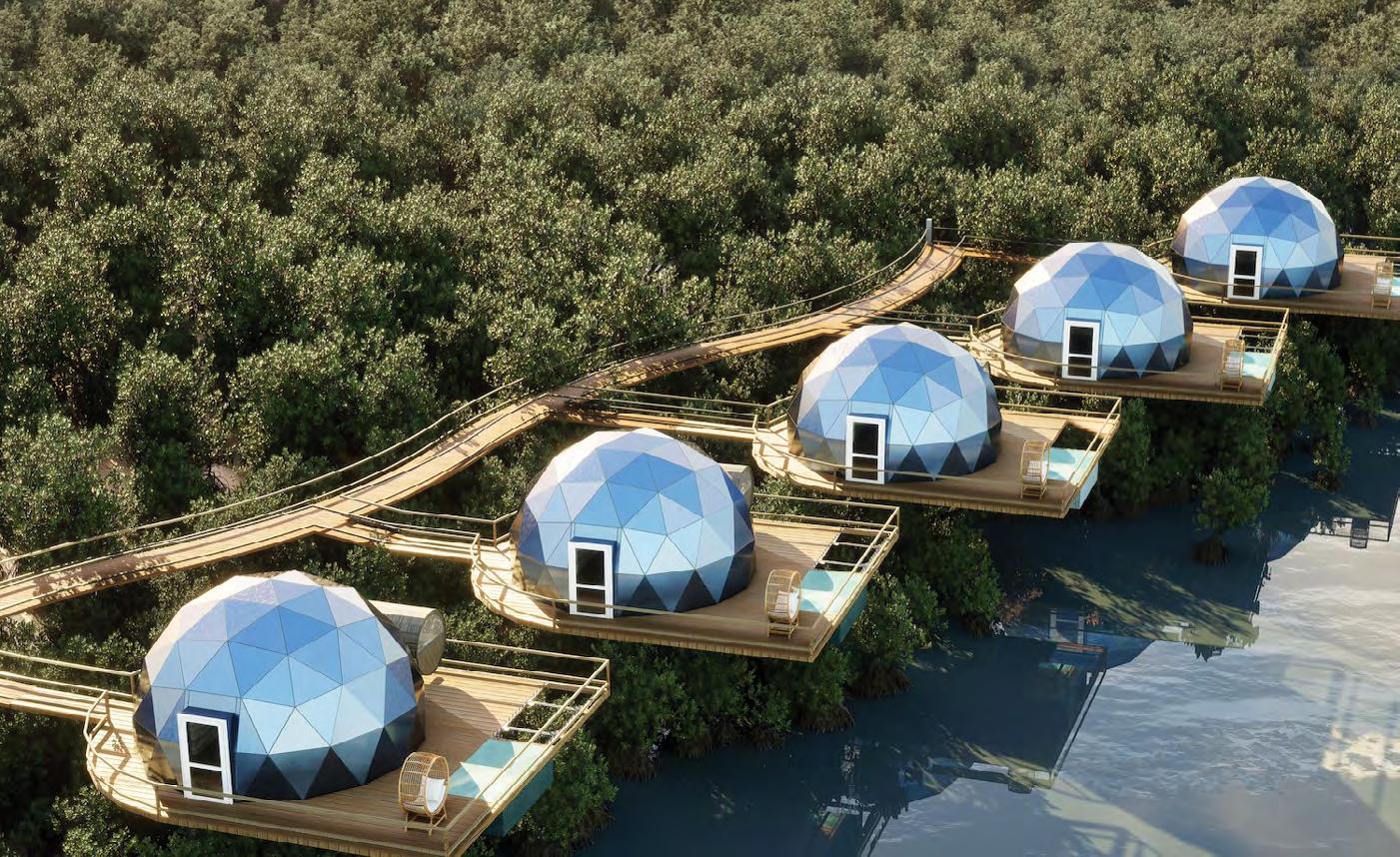
At the heart of the property is Luxe Bistro, a dramatic glass-domed finedining restaurant serving an innovative menu fusing Indian, Middle Eastern, and Mediterranean cuisine. Sourcing local and seasonal ingredients wherever possible, the restaurant reflects LuxeGlamp’s broader commitment to sustainability and community partnership.
The foundation stone was laid by Sheikh Majid bin Saud bin Rashid Al Mualla, Chairman of Umm Al Quwain’s Department of Tourism and Antiquities, underscoring the emirate’s official support for eco-tourism development. The resort complements the UAE’s established large-scale hospitality sector by offering a boutique, nature-focused alternative.
Operators and developers seeking to balance luxury with environmental stewardship should take note: LuxeGlamp UAQ demonstrates how high-end glamping can succeed within sensitive ecosystems. From paddleboarding through mangrove channels by day to soaking in a private plunge pool under the stars by night, guests experience a seamless blend of comfort and nature.
As the UAE shifts towards more boutique, eco-conscious travel experiences, LuxeGlamp UAQ stands as a model of what responsible, design-driven glamping can achieve on the global stage, and how India’s eco-luxury expertise is expanding beyond its borders.
MINIMISE EMISSIONS AND MAXIMISE UPTIME WITH THE ZE MOWER RANGE FROM KUBOTA
The ZE Electric Zero-Turn range from Kubota has proven its credentials with operators looking to reduce their environmental footprint, all without detriment to productivity or cut performance. Verifying that sustainability does not have to result in a compromise in turfcare standards, the fully-electric ZE-421 and ZE-481 mowers from Kubota’s Zero Turn collection are exceeding expectations too on operator comfort – reducing the noise, odours and vibrations associated with ICE-powered equipment.
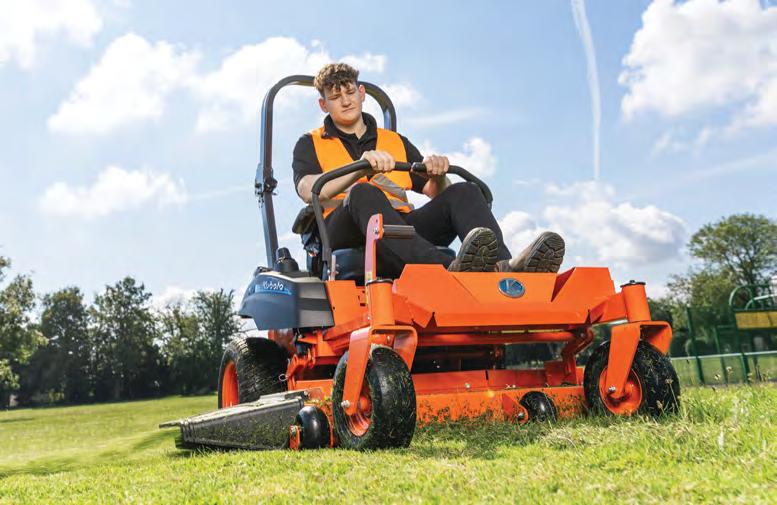
With no internal combustion engine, the ZE produces no CO2 or particulates during operation, supporting the UK air quality and net-zero commitments of local authorities and other green space managers. Instead, the ZE range is powered by a durable 48V, 10kWh lithium-ion battery which allows the mower to cover up to 15,000m2 on a single charge. Depending on site conditions, the operator can choose between Eco, Standard or Boost mode deck settings to further optimise battery life whilst choosing between two transport speeds, when exhausted, the battery module can be removed and exchanged in minutes.
The advanced K-Sense auto-adjustment system also actively monitors deck load in real time to automatically balance mowing and travel speed to preserve cut quality on varying grass types and densities.
The ZE-421 and ZE-481 models come with a 42” or 48” side-discharge deck,
ideal for professional contractors and landscaping applications, with an optional mulching kit available. Smooth and quiet in operation, additional comfort is provided by the adjustable seat and ergonomic deck controls designed to reduce fatigue and improve operator wellbeing.
In addition, the ongoing maintenance of the ZE range is significantly simplified, making it ideal for busy grounds teams. With no engine oil, spark plugs, fuel filters or exhaust systems to service, the routine upkeep is reduced to essential checks such as blade sharpening, tyre inspection and periodic battery monitoring. The electric drivetrain also results in fewer moving parts and less wear and tear, lowering the risk of breakdowns and maximising uptime.
The ZE range forms part of Kubota’s ongoing declaration to support a carbon neutral environment by 2050.

HOW CERTAINLY WOOD REIGNITED ITS FIREWOOD FUTURE
Over the past year, we have done a lot of soul-searching at Certainly Wood. Going from being a pioneer of kiln-dried logs to experiencing a devastating fire in August 2024, we have had to think hard about how to cater to the market’s firewood needs. In true Certainly Wood style, we’ve turned the heat into fuel for innovation.
Instead of dwelling on the past, we’ve used this time to grow, reimagine, and expand. The result? A bigger, better Certainly Wood – with an extended product range and exciting new launches, ideal for glamping and camping sites.
Bigger Volumes, Better Value
The Kindling Mega Box is the perfect solution for campsites and glamping sites that need larger, eco-friendlier volumes of our premium kiln-dried kindling. With less packaging and more product, it’s ideal for those who love creating their own firestarting bundles.
n 10kg of premium kiln-dried softwood
n Dried to below 12% moisture content
n One box starts up to 72 fires
Brilliant Birch
Introducing our new kiln-dried birch firewood – kiln-dried hardwood logs at an attractive price point. Easy to light, hotburning and producing minimal smoke, birch is the perfect choice for campsites and outdoor burning.
n Clean, hot, and easy to light – perfect for firepits, campfires, stoves and all woodfired appliances
n Available in convenient carry bags or bulk crates for versatile site needs
Fire Up the Flavour
Outdoor cooking has become an
experience, and we’re here for it! Our new cooking lines include smoking chunks and chips, designed to add rich flavour to BBQ dishes in a range of mouth-watering flavours.
Our Grill & Chill thinner-cut logs for wood-fired ovens and grills are produced from specially selected species for minimal spitting and maximum fire control.
Light your larger ovens or fuel smaller portable ones with our Little Oak Logs –the 100% oak logs prevent any damage to your ovens, unlike traditional pine kindling. These pair perfectly with our Flamers natural firelighters too.
Woodfired Wellness in the Wild
With the continued rise of wood-fired saunas, hot tubs, and retreats, we have launched our firewood in new formats for this season – perfect for those needing larger volumes for wood-fired wellness
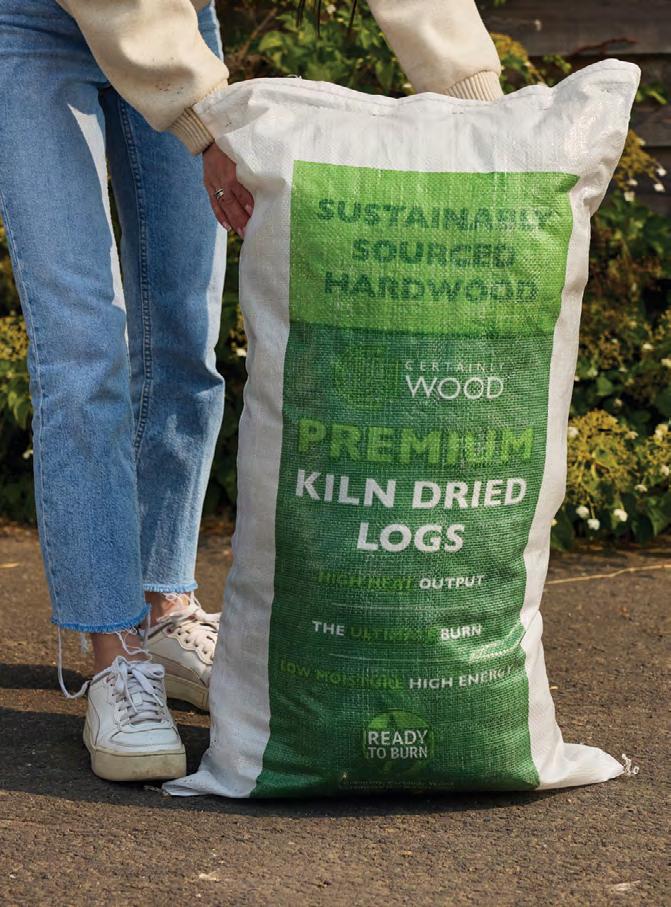
appliances. Our clean, uniform crates provide a tidy, ready-made wood store that keeps firewood easily accessible for guests while minimising mess and effort for hosts. Our new Boot Bags of Logs are easy to handle and store for simple restocking, ensuring hot tubs and saunas are always well supplied for guests’ comfort and relaxation.
Transforming How You Manage Your Firewood Supply
We’re also excited to launch our brandnew trade portal, built to make managing your firewood supply easier than ever. Streamlining supply for our customers, you can now enjoy fast ordering, account management, exclusive pricing, and access to the full product lineup at certainlywoodtrade.co.uk.
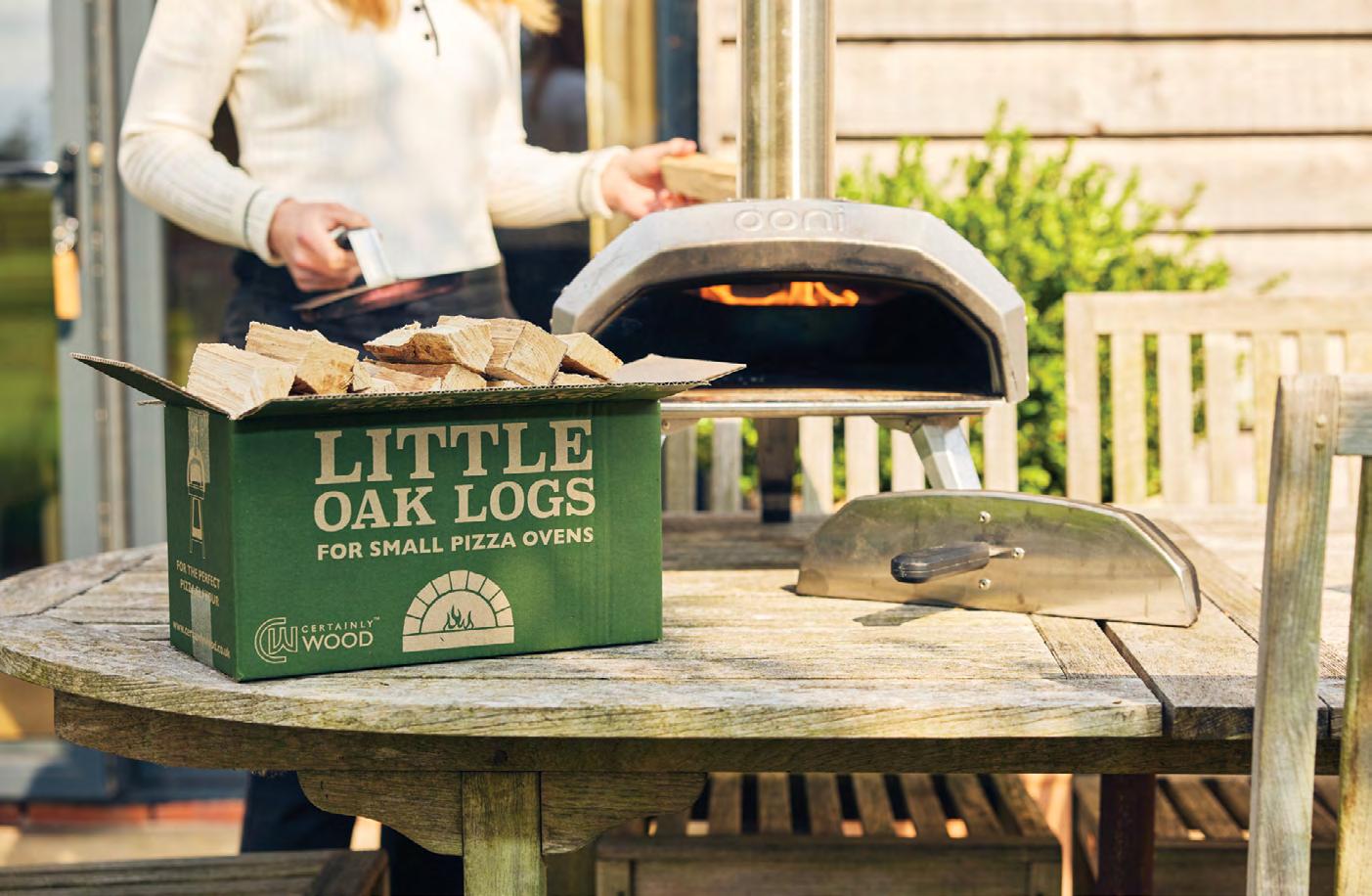
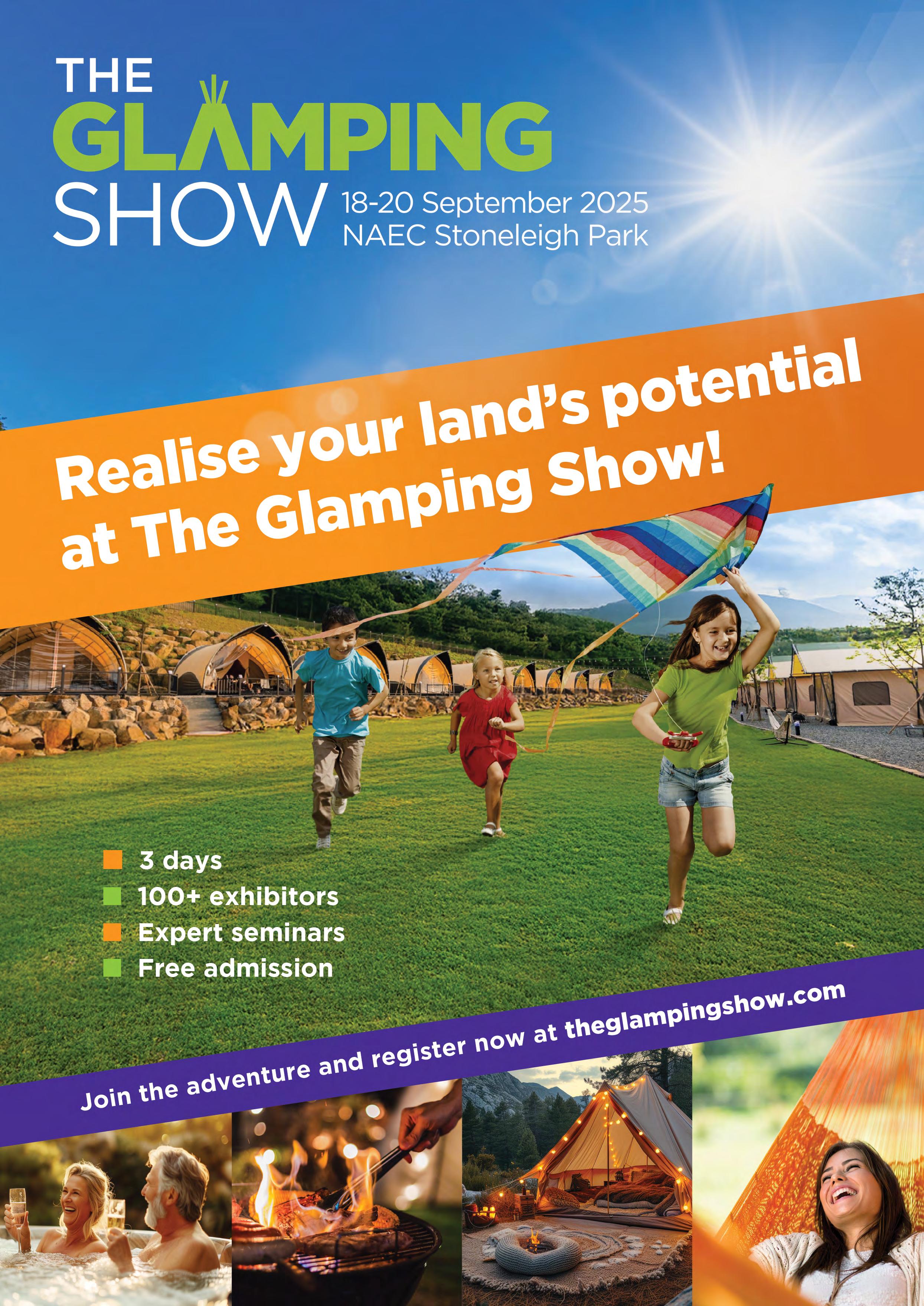

GITA(UK) A letter from
By John White, Executive Manager
Wi th the recent spell of fine weather, it really does feel as if the summer season has started – even if the school holidays haven’t. This can only be good for bookings, guest experience, and hopefully repeat business.
That guest experience is everything, and it’s been great to see so many of you attending the GITA webinars exploring this topic. I particularly enjoyed VisitEngland’s Ross Calladine discussing how simple changes can make a huge difference to disabled guests. From the ease of booking on your website to knowing what is and isn’t available on site;
accessibility can be the difference between securing a booking or not. Ross shared loads of practical tips based on years of experience.
With GITA membership now just under 80 and growing, we’re making the webinars member-only. They’re a clear and valuable member benefit, and we hope they’ll encourage more of you to join. With membership starting at £90 for most sites (that’s just 25p a day) and over £3k worth of benefits instantly available, it’s not only the right thing to do to support the industry’s voice – it’s a business no-brainer. You also won’t miss any of the autumn webinars, which kick off in September with a look at
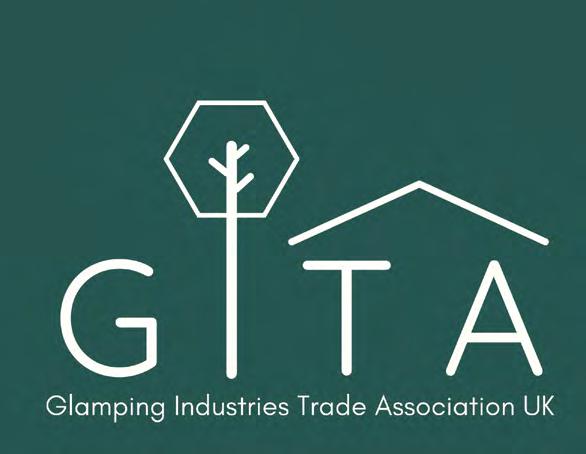
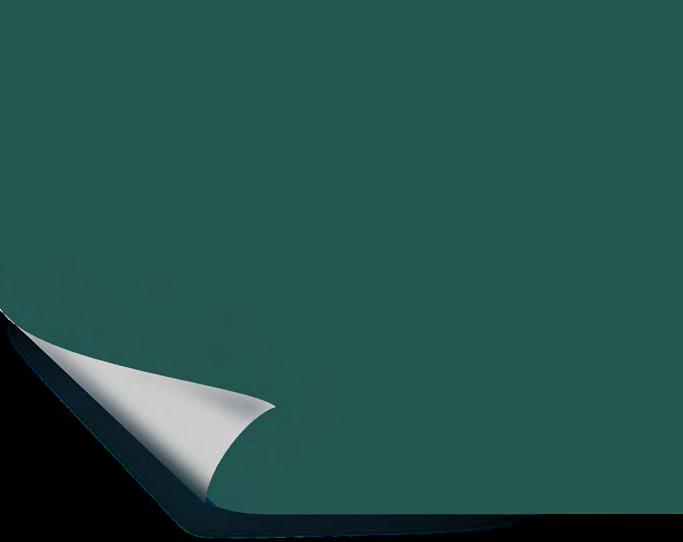
how you can take guests to the stars with a Dark Skies experience. We’ll also be covering off-grid glamping, electrical safety, decking, tent buying, and more.
We’re also turning our thoughts to The Glamping Show in September. We softlaunched GITA at last year’s event, and it’s incredible how far we’ve come in such a short time. This year, our stand will be next to the seminar tent – do come and say ‘Hi’, member or not. It really is great to talk glamping and learn from every conversation. We’ll also be hosting our AGM and Summit on the Friday, ending with a drink on site with Show exhibitors and fellow GITA members. A big thanks to The Glamping Show team for hosting us again.
On the subject of learning, please take five minutes to complete our online questionnaire (link). Your responses will shape what GITA focuses on in the coming years. As our strapline says: Supporting your Business. Growing our Industry. We need your input to do that – so thank you for filling it in.
Our policy work also continues, with plans for the statutory registration of tourism accommodation moving forward. We’re working with DCMS to help design something that works – particularly for the glamping sector. Tourism levies have also resurfaced, with the Scottish Tourism Alliance calling for proper engagement on their introduction. While there are no plans yet in England, you never know. We’ve supported the STA on behalf of our Scottish members and want to ensure this doesn’t become just another unnecessary burden on already hardpressed businesses.
forms.gle/mDNCpFdr1J3jtPsg7 gitauk.org
John White
THE MAN BEHIND THE SHOW Dan Wiseman on the Business of Glamping

Wi th The Glamping Show fast approaching, International Glamping Business – the event’s official publication – invited Exhibitions Manager Dan Wiseman to share what’s in store for this September, how he approaches bringing the show to life, and what continues to inspire him after more than a decade in the industry.
The Vision for 2025
As we head into our second decade, The Glamping Show 2025 is shaping up to be more dynamic and future-focused than ever. Over the years, we’ve seen categories like hot tubs, fire pits, saunas, and plunge pools grow from niche to essential. But what really stands out to me now is the continued evolution of structure innovation – how form and function are blending beautifully with natural surroundings.
I’m particularly excited about the increased emphasis on sustainability and off-grid living this year; these aren’t just trends, they’re now critical components of the glamping experience. Wellness is also rising fast on the priority list, becoming a key factor in how destinations attract and retain bookings.
State of the Industry
It’s been quite a ride since we launched the
show. Manufacturers and service providers have weathered many changes, but the resilience and creativity in this industry never cease to impress me. The sheer number of new sites opening over the past decade has been phenomenal. While that’s brought great success for many exhibitors, it’s also created intense competition for destinations.
The sites that truly thrive are those offering not just great accommodation, but a memorable guest experience – whether that’s high-end service, thoughtful entertainment, family-friendly touches, or a dash of luxury. The space is almost secondary to the story you’re telling.
What Visitors Can Expect
This year, we’ve curated a powerful mix of returning favourites and exciting new exhibitors. Expect to see some structures making their public debut, plus a few surprises along the way. I’m particularly proud of the new Seminar Programme we’re developing in collaboration with International Glamping Business. It’s packed with fresh content, panel discussions, and vital guides aimed at helping destinations grow, adapt, and succeed in this competitive space.
A Day in the Life Exhibitions are in my blood. For me, the planning starts the moment we’ve packed
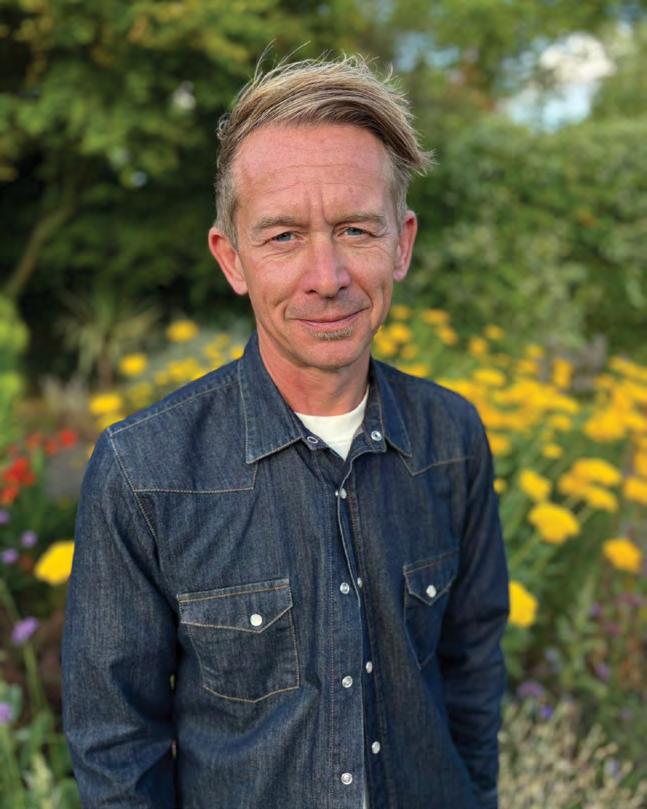
down the previous show. Every detail follows a precise timeline, from logistics to layout to communication. But it’s during build-up week that everything comes alive. Watching the empty ground transform into a vibrant space full of opportunity – there’s nothing quite like it. On opening day, seeing the buzz of exhibitors and visitors connecting makes all the effort worthwhile.
Memorable Moments
One standout memory for me was our 10th anniversary celebration in 2024. We introduced a Friday evening gathering for exhibitors, and the atmosphere was fantastic. Seeing everyone networking, sharing stories, and enjoying the community we’ve built was a perfect reminder of why I love doing what I do.
MEET THE NEWCOMERS
These new exhibitors are ready to make their mark. Whether you’re a site owner, budding entrepreneur, or curious first-timer, these are the must-visit brands making their debut at The Glamping Show 2025.
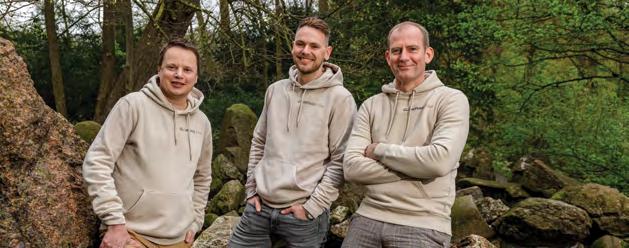
Glampings.com helps glamping owners generate more bookings. Stand 1020


Manufacturer of high quality performance foam products. Stand 1024


The ultimate welcome gifts for your VIP (Very Important Pooch) guests. Stand 312

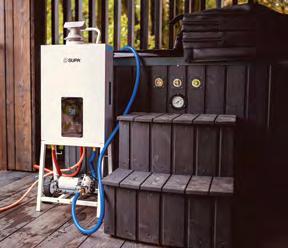

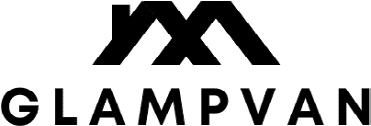
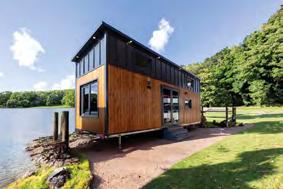
Glamping holidays across the UK, handpicked for quality. Stand 1028

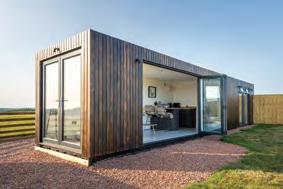
Iron & Pine is a leading supplier of luxury modular construction solutions. Stand 336

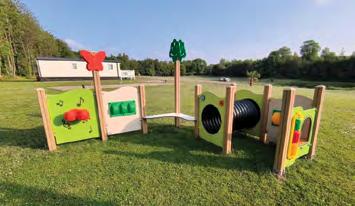
Creating safe and imaginative play worlds for the next generation. Stand 254

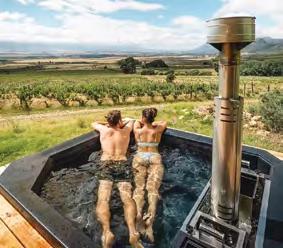
and


Bespoke Garden Studios. Sanctuaries Designed for You. Stand 256

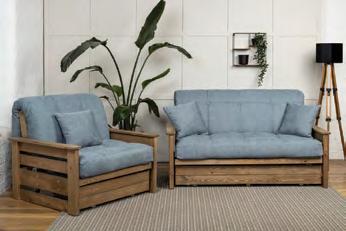
Manufacturers of simple and stylish spacesaving seating and sleeping solutions. Stand 1003

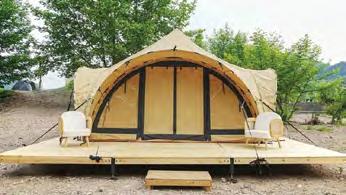
Blending timeless design, sustainable materials, and masterful craftsmanship.
SUPA Heater is the fastest and cheapest way to heat your hot tubs. Stand 222
A sophisticated
portable hot tub made out of recyclable plastic. Stand 304
Stand 248
Live large in a tiny home. Stand 209
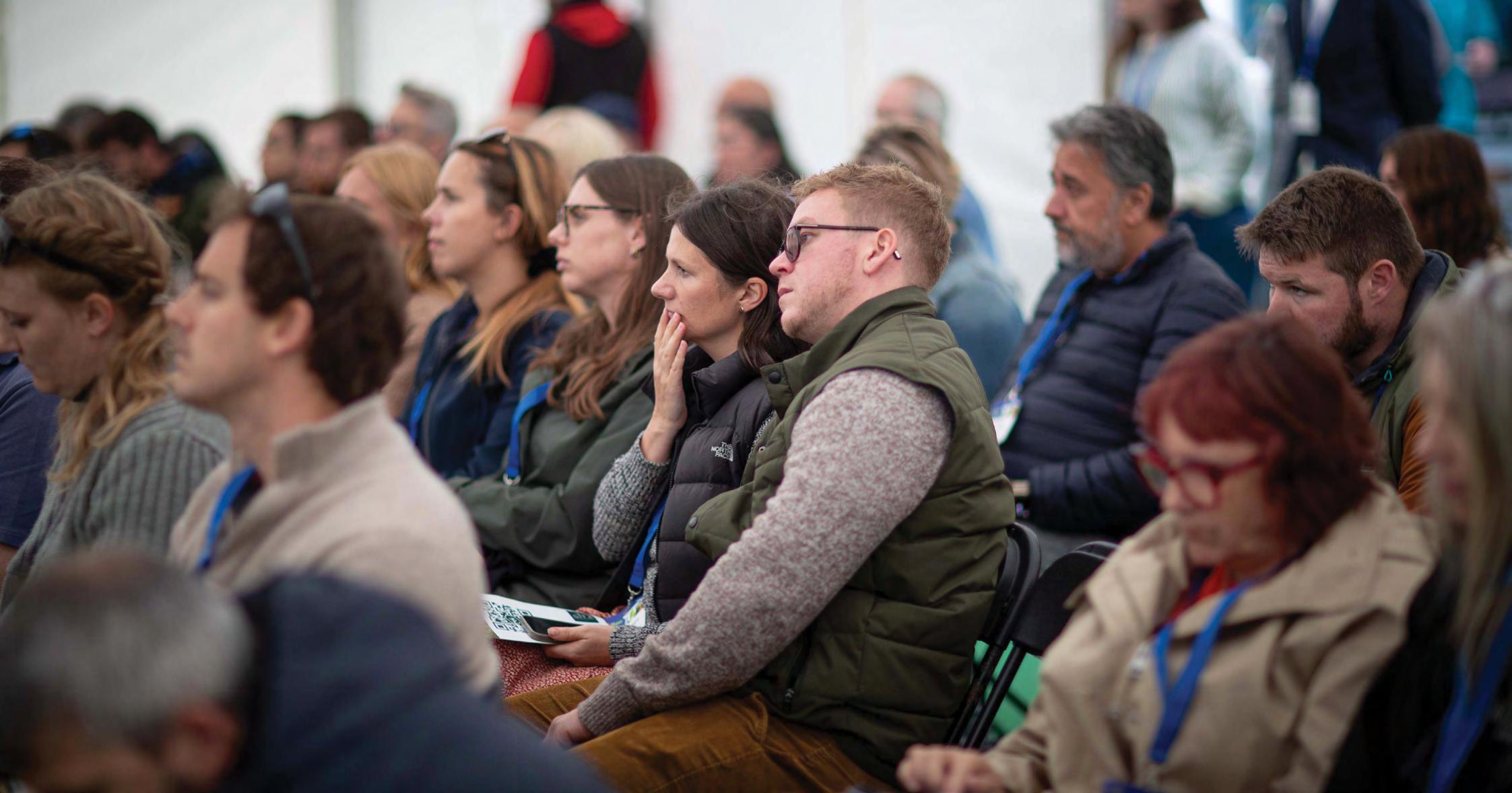
SEMINAR PREVIEW
Expert Voices at The Glamping Show 2025
Steph Curtis-Raleigh, International Glamping Business’ Publisher, is curating this year’s seminar programme in collaboration with The Glamping Show – with a speaker line-up promising real-world takeaways, fresh thinking, and seminars spanning business strategy, marketing, and guest insights.
When asked about the collaboration, Steph Curtis Raleigh said, “We’re absolutely thrilled to be curating this year’s seminar programme at The Glamping Show, which we believe features one of the strongest speaker line-ups to date.”
She continued, “The sessions will be packed with real-world insight from glamping operators and industry thought leaders, covering everything from planning and marketing on a budget to technology, AI, boosting occupancy and driving direct bookings. We’re also honoured to welcome the CLA once again to share their invaluable expertise. It’s set to be an inspiring and practical series of talks for anyone in the outdoor hospitality sector.”
In this seminar preview, we’ve highlighted just a few of the speakers and sessions you’ll hear from this September as a small taste of what’s to come.
Beth Robinson
The Welsh Farm
The One Thing Most Hosts Don’t Do (That Changes Everything)

This seminar will focus on knowing your guest through and through, and from there, creating an experience they’ll eagerly jump at – through connection and conversion.
Barry Davies
Davies & Co
Planning Masterclass

Barry Davies will offer expert advice on all aspects of glamping sites – new and old – including funding, planning permission, and more.
Eamon Heggarty Coorie Retreats
My Founder Story

Eamon Heggarty will talk us through his journey of co-founding Coorie Retreats, an awardwinning Scottish glamping destination.
Sarah Orchard Get Fully Booked
“If Only I Had Known That!”: Real Life Lessons from Glamping Hosts

Learn from the real-world highs, lows and lightbulb moments of successful glamping owners running two very different sites.
Joby Mussell
The Travel Chapter
Maximising Bookings in 2026 & Beyond: Trends, Guest Insights and Profit Tips

As Chief Commercial Officer at The Travel Chapter, Joby Mussell will provide datadriven industry insights for the glamping and holiday let sector.
Vicki Jones Tractors and Cream
The Tech You Didn’t Know You Needed
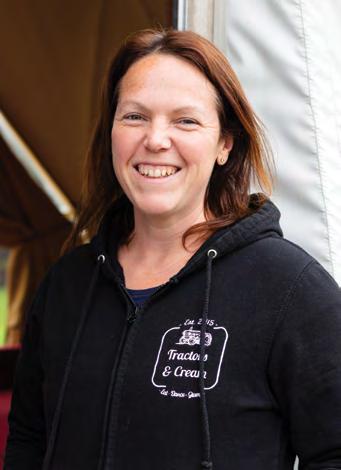
Vicki will explore what tech features make a great guest experience when booking, tools to save you time and money, and other useful tech including websites, social media and Google ads.
Siana Vesselinova PriceLabs
Smart Minimum Stay Rules: The Hidden Lever to Boost Glamping Occupancy

John Greenshields The CLA
Don’t Overlook These Glamping Essentials

This talk will cover an array of items that must be considered when setting up your glamping business. Making the unglamorous glamorous – including health and safety, insurance, business rates and access.
John White GITA (UK)
The Political Landscape for Glamping
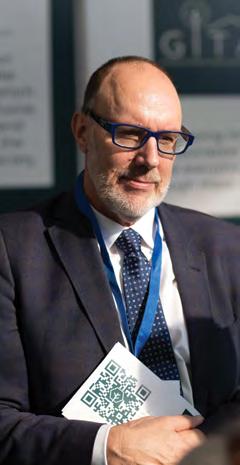
Kate Morel
Creative Hosts: The Competitive Advantage of Thinking Differently
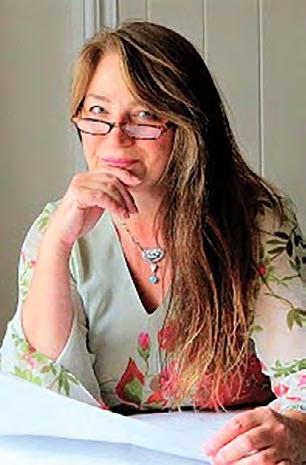
Kate understands exactly what works, what doesn’t, what guests look for, and how to deliver an exceptional experience. Her business and design expertise has guided many successful glamping ventures.
Michelle Marriott Haigh Group
Going with the Flow: Smart Wastewater Solutions for Glamping Sites
Siana will talk you through how to optimise your operational strategies through data-driven solutions.

Throughout her career, Michelle has championed new and innovative approaches to tackling some of the most pervasive challenges impacting the wastewater sector in the UK, embracing new technology and sustainable solutions.
John White is Executive Manager and Company Secretary for the Glamping Industries Trade Association (GITA) UK, which has been established by leading industry operators to provide a unified voice for the experiential outdoor living market.
Sarah Riley Inspired Courses
Marketing Masterclass: Turning Limited Resources into Unlimited Success
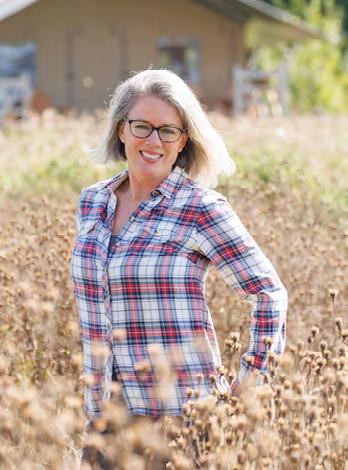
Sarah Riley has garnered years of experience operating in the hospitality sector and more recently working with hundreds of start ups and successful operators in the glamping sector.
Thursday 18 September Friday 19 September Saturday 20 September
Thurs-Fri - 09:30-17:00 Saturday - 09:30-15:30
KIP AND NOOK Building Community Through Design and Nature
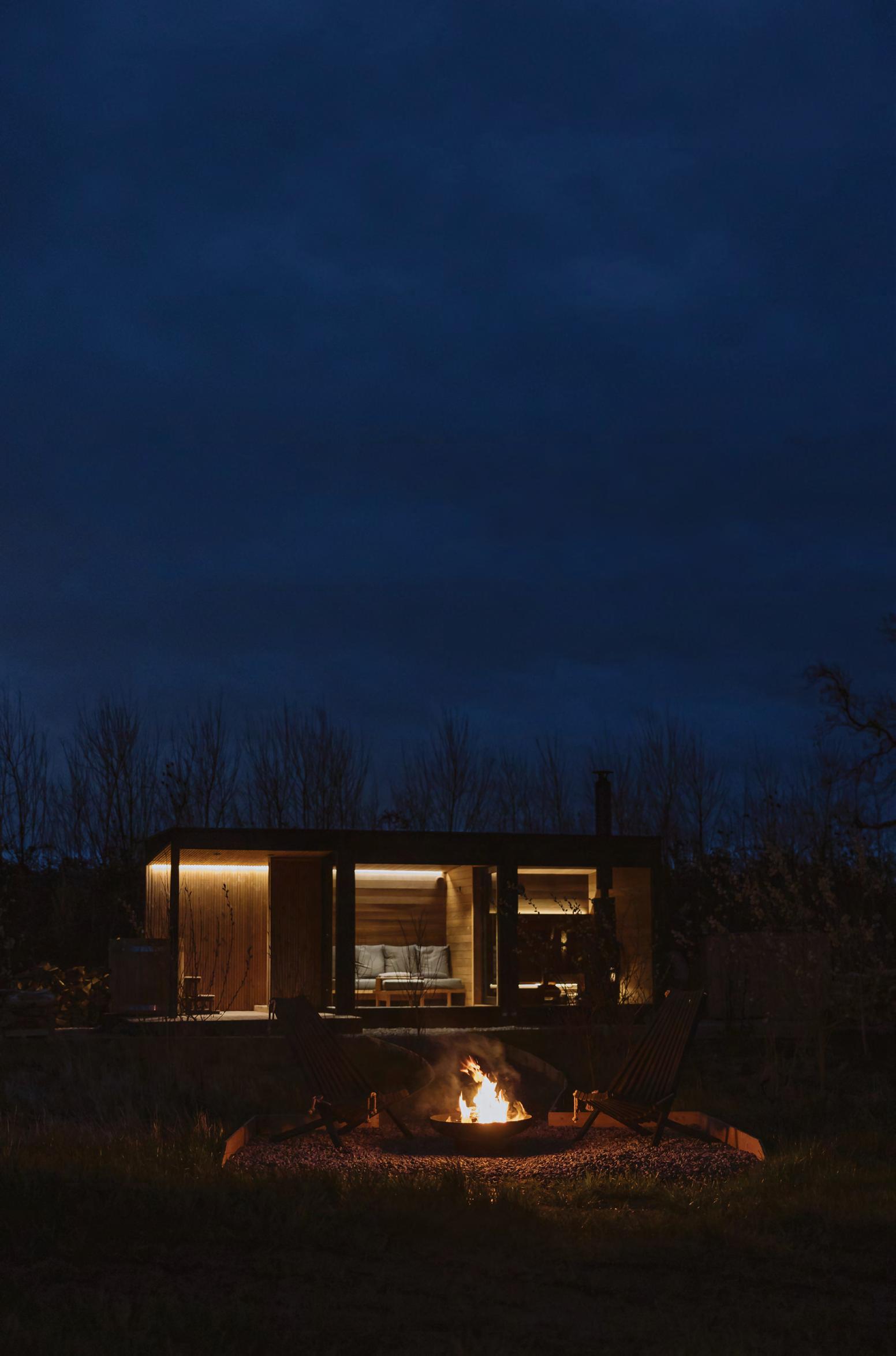
Born from a family’s vision, Kip and Nook has transformed a rural farm in Yorkshire into a stylish glamping retreat that attracts design-savvy guests seeking unique countryside escapes. International Glamping Business’ Editor Annie spoke with the team to find out more about the community-minded Kip and Nook lifestyle.
What was your core business idea when you launched and how has that evolved?
Kip and Nook began in 2020 as a simple yet unique concept: one off-grid cabin in a field at our family-owned Pinkney Carr Farm, with a goal to offer people a peaceful, design-led escape that blended nature with comfort. We didn’t have to search for a location as the land
on our family farm was already ours, and we saw the potential to create something unique. Each year we’ve expanded and added to the site, and today we offer a collection of boutique accommodation options and luxury pitches for motorhomes and campervans. We’ve grown to include a wide range of onsite activities: a padel court, two sauna and ice bath areas, and our own restaurant and bar, The Workshop, which serves up breakfast, lunch, and pizzas. We also host regular events like run clubs and car meets, building a community vibe around the Kip and Nook lifestyle.
That one cabin was the starting point of something much bigger. Now, the business has evolved significantly into a place to stay, play, recharge and connect.
What sets Kip and Nook apart in an increasingly saturated glamping market? How do you maintain that uniqueness?
From day one, our focus has been on design, quality, and experience. While our roots may have started in a field with one off-grid cabin, what we’re building now is something much more refined. We believe we’re on our way to becoming a truly unique boutique hotel made up of cabins, each thoughtfully designed with style and comfort in mind.
Where many glamping sites focus solely on accommodation, Kip and Nook offers an immersive lifestyle; it’s a place where people come to switch off, reconnect, and engage in something more meaningful – everything is carefully curated to give guests an unforgettable experience.
We stay unique by continuing to evolve, year after year. We don’t just add to the site, we refine it, responding to our community and the everchanging ways people want to travel and relax. Events like our run clubs and car meets keep things fresh and bring people together, helping to foster a sense of community that’s at the heart of what we do.
How did your collaboration with Industville on lighting play into your broader branding and wellness strategy?
Our collaboration with Industville has been a perfect fit for the Kip and Nook aesthetic and ethos. We use their lighting across all our properties because their pieces strike the perfect balance between style, warmth and calm, which is exactly the mood we aim to create. Lighting is a big part of our wellness strategy. It helps set the tone for each space: soft, inviting and grounding. Every property at Kip and Nook has its own unique feel and we carefully select Industville pieces that reflect those differences while still keeping a cohesive look across the site. Their designs align beautifully with our brand values: high quality, understated luxury, and attention to detail.
Do you use guest feedback to drive business decisions? Can you share an example where guest input led to a change or improvement?
Absolutely – guest feedback is central to everything we do at Kip and Nook. We pay attention to all comments, big or small, whether it’s a request for extra cutlery or plates in a property, replacing a light bulb, or ensuring maintenance is always top-notch. For example,
we had guests mention they wanted more kitchen essentials in some cabins. We immediately responded by updating our inventory to include additional cutlery, cookware and serving plates. It’s these kinds of details that make a big difference in the overall experience.
We take every piece of feedback seriously because our goal is to make every stay perfect for our guests. Continuous improvement driven by guest input is how we keep growing and refining our offering.
With a semi off-grid model, what operational challenges have you faced – and how have you overcome them?
Our original off-grid cabin from 2020 was a great start, but it did present some challenges in terms of maintenance and power reliability. Being the first cabin, it was harder to keep up with ongoing maintenance and manage the solar system efficiently. Since then, we’ve significantly expanded our team and expertise. When we launched The Den in 2023, it was a high-end luxury off-grid cabin with a state-of-the-art solar and power system, and we haven’t had any issues since.
So, we recently redesigned our original 2020 cabin to match that same high standard, making it even better. Because we design and build all our cabins in-house, we have full control over every detail, including the offgrid solar energy system.
How do you manage staffing, housekeeping, and guest communications across multiple unit types and group sizes?
When we started five years ago, our team was very small and we managed everything with
a hands-on approach. Fast forward to now, and we’ve grown significantly with over 25 dedicated team members.
To keep things running smoothly, we’ve structured our team into specialised departments, each with clear roles and leaders responsible for specific areas like housekeeping, maintenance, and guest communications.
This departmental approach ensures every detail is managed efficiently and consistently, from preparing different types of units to responding promptly to guest needs.
How do you structure pricing and packaging to maximise occupancy and revenue across seasons?
We keep our pricing consistent throughout the year; we don’t change rates seasonally. This pricing model has worked well for us for over five years, providing simplicity and transparency for our guests.
That said, we’ve recently started introducing some special packages, like the ‘Midweek Summer Reset’ and our ‘Wellness Retreat’ offer. These include added extras on-site but are offered at the same rate as the property alone. These packages help boost sales without complicating our pricing structure.
Have you explored additional income streams such as events, wellness workshops, or partnerships with local providers? What’s worked well?
Yes, we’ve actively developed additional income streams through events and partnerships that align with our wellness and community focus. We’ve hosted yoga and pilates sessions in the past, which were really
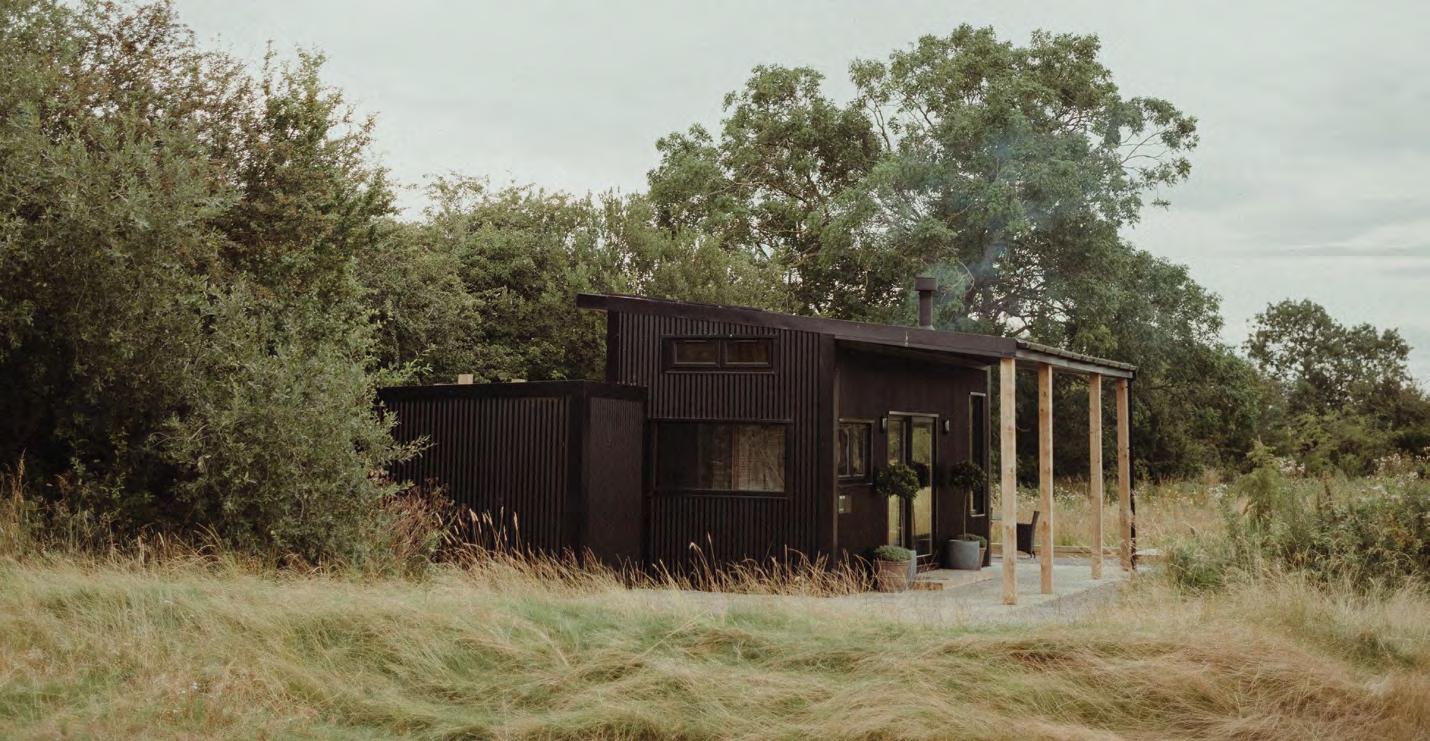
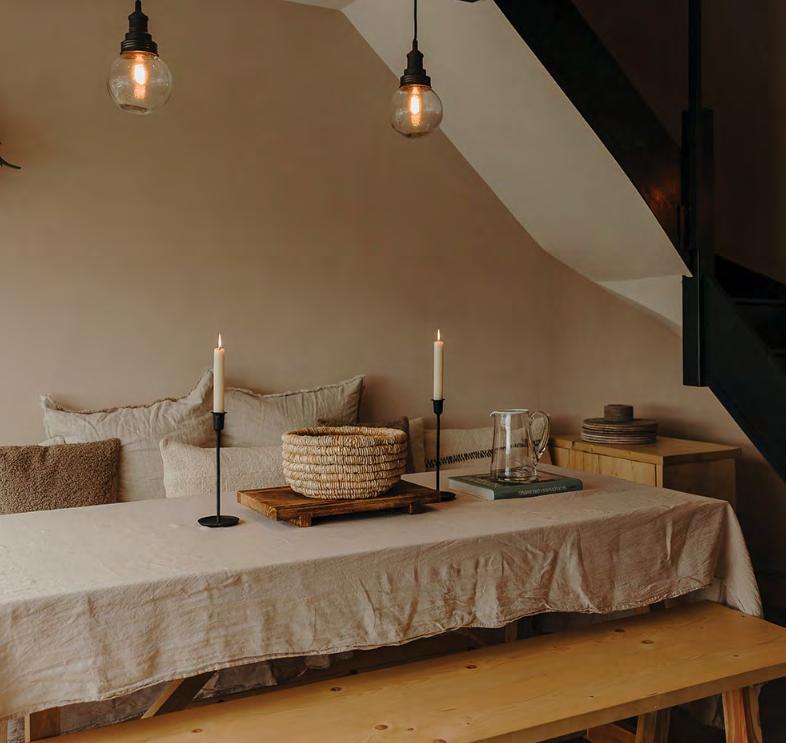
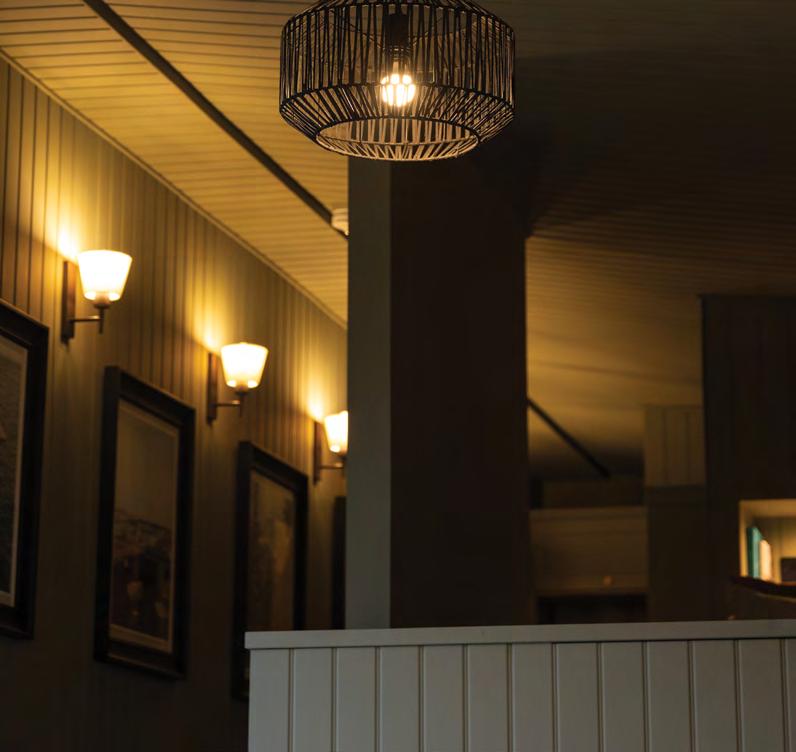
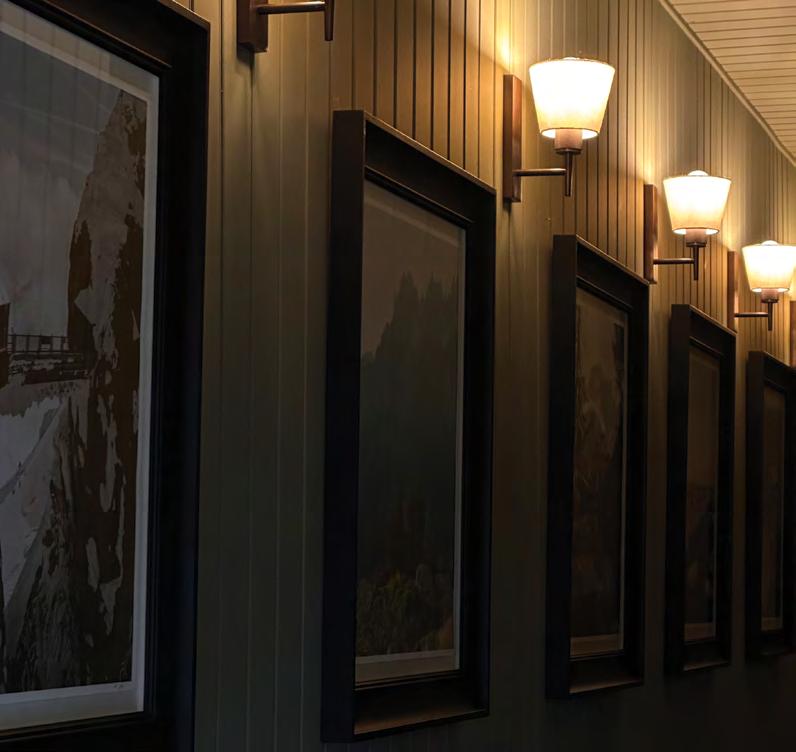
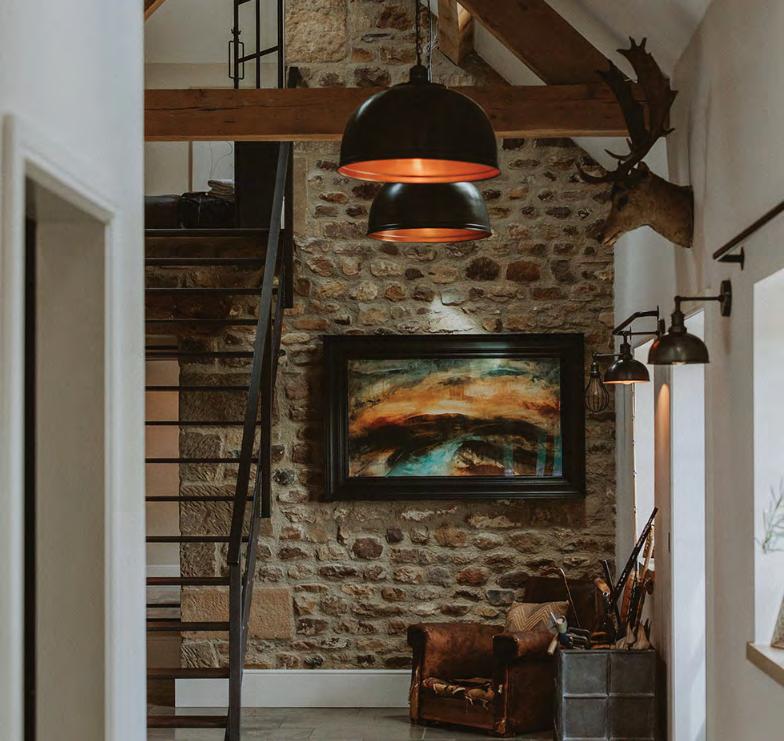
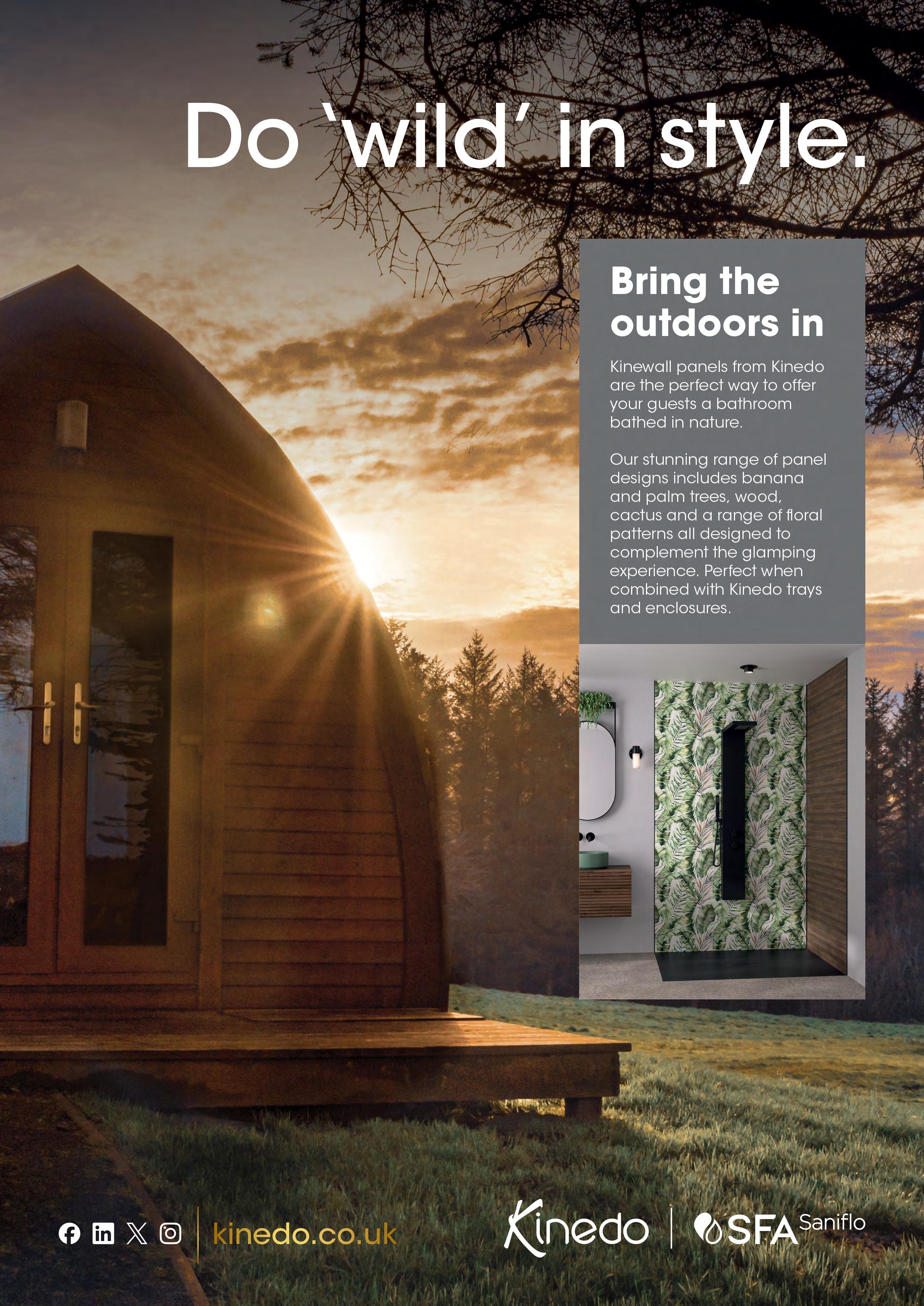
well received. We also rent out our wellness spaces to local providers and individuals who want to run their own workshops or events, creating a flexible venue that supports a wide range of activities.
One of our standout successes is our monthly run club, which has grown massively and now attracts almost 100 members each month. It’s become a vibrant community event that brings people together and keeps them coming back. Collaborating with a variety of brands and offering these experiences has been a great way to diversify revenue while staying true to the Kip and Nook lifestyle.
How do you market Kip & Nook?
Any advice for other operators?
We have an in-house team that manages all our marketing efforts, including Facebook, Instagram, TikTok, marketing emails, and special offers. Content creation is also done internally, which helps us maintain a closeknit approach and ensures everything stays perfectly aligned with our brand vision.
We also collaborate with talented photographers and videographers to produce high-quality visuals that truly reflect the Kip and Nook experience.
Social media and direct bookings have proven to be our most effective channels, allowing us to connect directly with our community and build genuine relationships.
Our advice for other operators: invest in a strong, consistent brand identity and keep control over your content. Authenticity and quality go a long way in standing out and building trust with your audience.

With new developments planned for 2025, what factors are driving your expansion and how are you financing or phasing this growth? Our expansion is driven by the strong demand from our community and our desire to continually enhance the Kip and Nook experience. In terms of financing, everything we build is funded entirely from the profits generated by the business. We reinvest every penny back into Kip and Nook to ensure sustainable growth.
We phase developments carefully to maintain quality and make sure each new addition meets our standards and our guests’ expectations.
It helps that we have a fantastic building team on site who are true perfectionists. Every detail is done right and to the highest standard – and because all our cabins and developments are designed and built in-house, we maintain full control over quality and craftsmanship at every stage.
Looking back, what are some business decisions you’re especially proud of – and any you’d approach differently now?
We’re incredibly proud of what we’ve built at Kip and Nook. While not everything has gone exactly to plan, we wouldn’t change a thing because the lessons we’ve learned along the way have been invaluable in shaping where we are today.
We believe we’re on the right track to achieving our vision for the next few years, with exciting new developments like a health club gym and a new restaurant coming to the site. A coffee shop is also on the horizon as we continue to expand what we offer – not just for guests, but also for the local community.
Our focus remains on creating the best possible destination for everyone, and we’re excited for what’s next.
If you had to give one piece of advice to other glamping professionals, what would it be?
Always remember why you started and keep your vision for where you want to go front and centre. For us, staying true to what works for our brand and maintaining the highest standards has been key to our success.
It’s easy to get distracted by trends or shortterm gains, but focusing on your core values and delivering a consistently exceptional experience will help you build something lasting and meaningful.
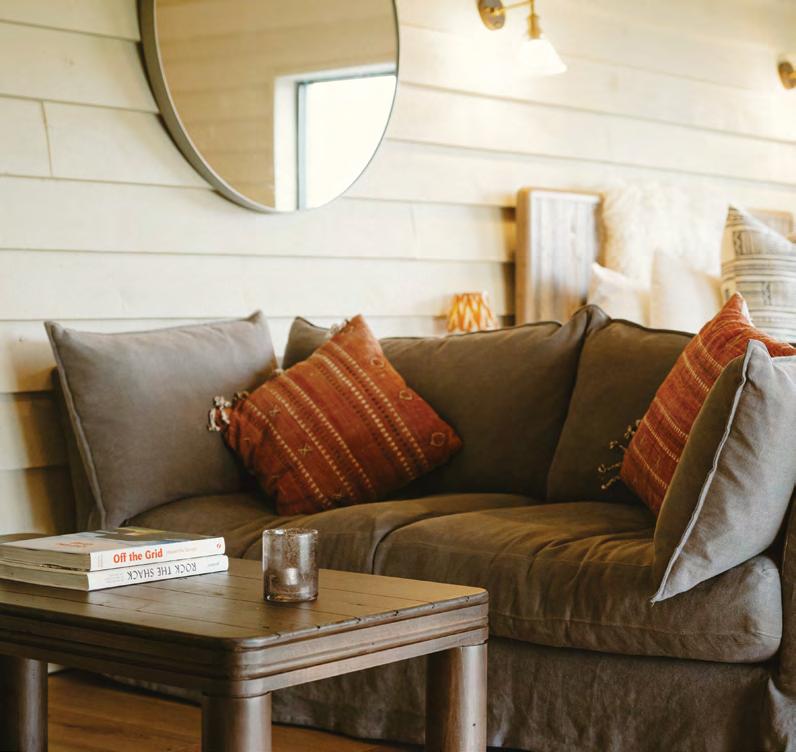
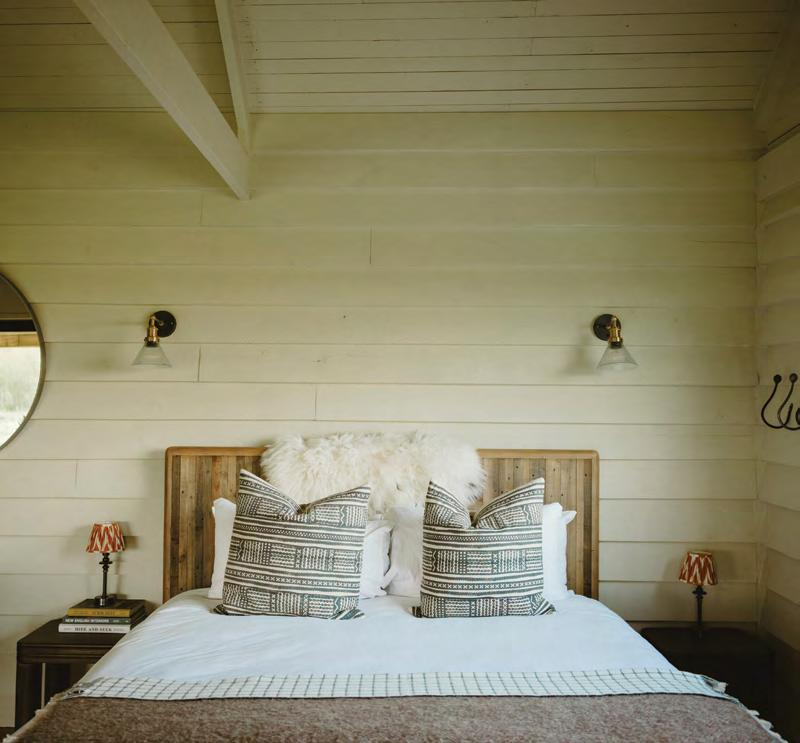

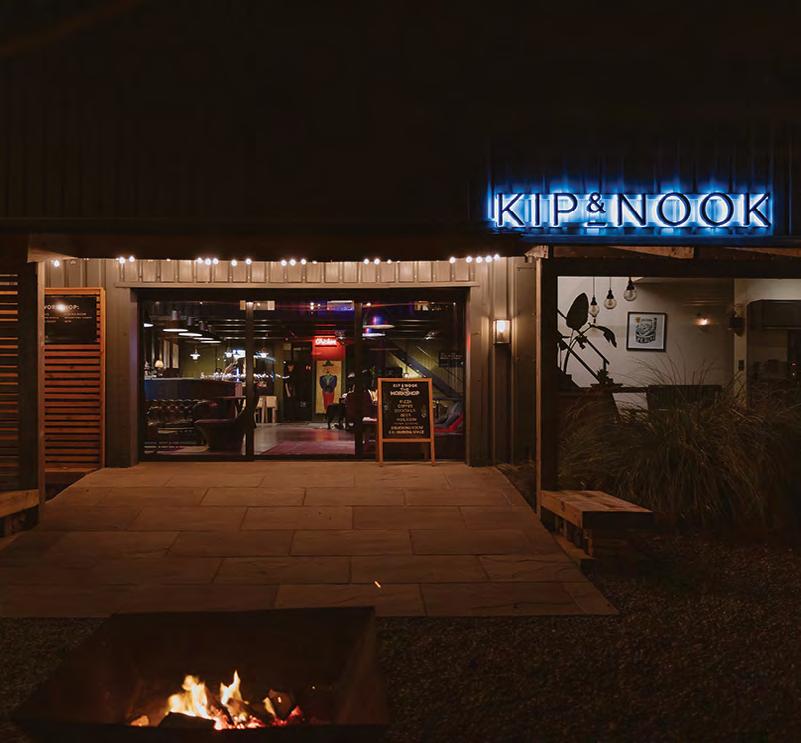

By Vicki Jones, Co-Owner of Tractors & Cream

SOUTH AFRICA’S GLAMPING MOMENT
South Africa is on the brink of a glamping boom. From the wine estates of Franschhoek to the breathtaking views of Mpumalanga, a new wave of outdoor experiences is emerging, offering guests more than just luxury in nature, but a deeper reconnection with land, wellness and intentional living.
Staying at Camp Canoe
In December, my family and I visited Camp Canoe, nestled high above the vineyards of the Boschendal Wine Estate in Franschhoek. Accessible via a winding dirt track, the journey alone sets the tone: this is not an ordinary stay. The site features just seven solid-walled, safari-style tents, each designed
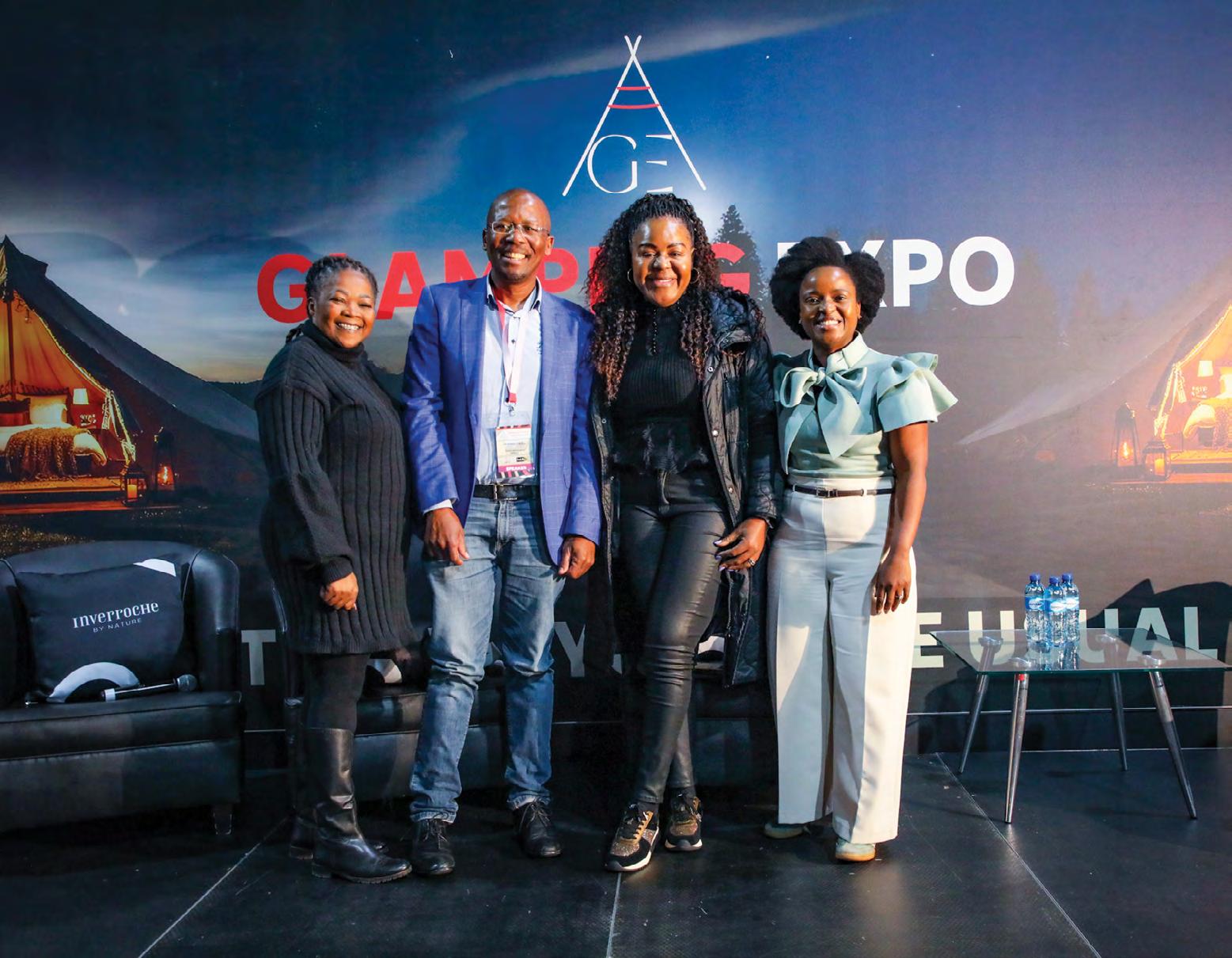
to blend into the mountainous landscape while offering a level of comfort that rivals boutique hotels. With the largest bathroom I’ve ever seen in a tent, an indoor wood burner, full kitchen, wood fired hot tub and a giant hammock perfect for stargazing, it really was the perfect setting. Of all the glamping sites we’ve filmed for our YouTube channel, Camp Canoe quickly became our favourite to date.
But it’s not called Camp Canoe for nothing! The true highlight was the dam. Guests can swim, paddle canoes, or simply sit on the bank as the sun sets behind the peaks. There is an honesty bar inside another beautiful tent and communal fire pit area, set underneath a stunning mountain backdrop. The staff on site sat with our children and helped them light the fire. They provided us with as much wood as we needed and the marshmallows were in abundance! It added a social and almost cinematic finish to each day.
When you tell people you are going glamping in South Africa you are often met with a look of concern. Is it safe? Are you sure you should be staying in a tent in the middle of nowhere? But Camp Canoe is in the middle of a wine estate, with staff on site, and a guard at the entrance. We felt completely secluded, but also really safe and well looked after.
Glamping Expo
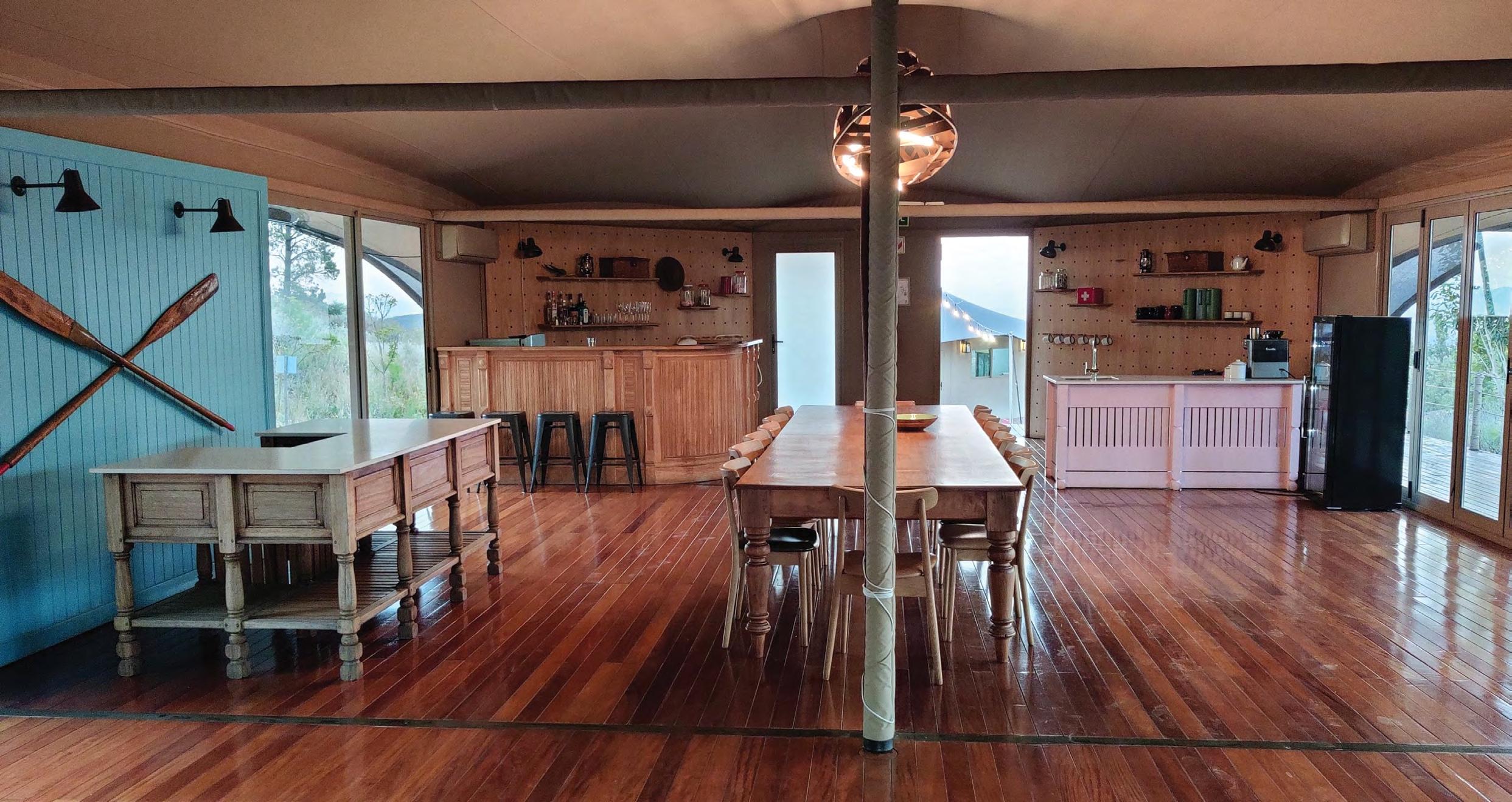
A Movement Gaining Momentum
Camp Canoe is just one example of a growing movement across South Africa. To understand the wider picture, I spoke with Gugu Sithole, founder of Glamping Adventures and the visionary behind South Africa’s first-ever glamping expo which took place on 20th and 21st June this year.
Gugu’s passion is unmistakable. “I want to spark a lifestyle movement,” she tells me, “one that redesigns luxury to prioritise well-being, reconnection with nature, and community.”
Challenges and Opportunities
Despite the explosion of glamping online, Gugu says the sector remains fragmented, with a lack of set standards or a unified network. She believes collective action will help shape the industry’s future.
Gugu’s business journey began with mobile glamping. These were luxury tents fitted with beds, Wi-Fi and meals provided, set up at various sites for group retreats and teambuilding programmes – but demand soon grew for permanent, high-end structures. Gugu and her team work with a network of
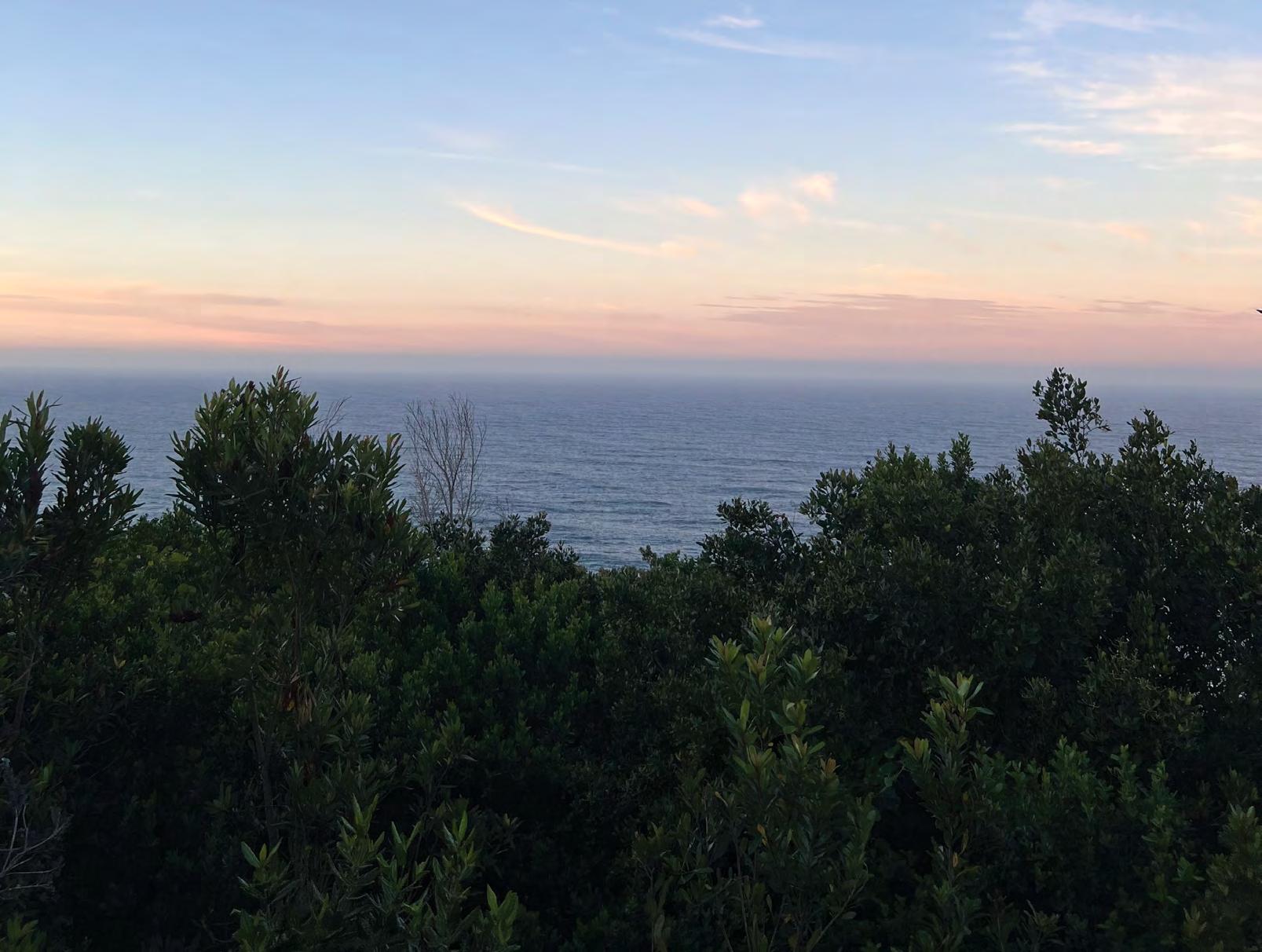
diverse glamping sites across the country, from river-facing luxury tents on nut farms in Mpumalanga, to mountain-view domes that blend eco-conscious design with local cultural heritage. And yet, until recently, most of these experiences were unknown even to domestic travellers.
“The word ‘glamping’ is still new in many parts of South Africa,” Gugu explains. “But interest is growing, especially among millennials, families, and women-led travel groups seeking wellness, slow living, and curated outdoor experiences.”
A New Booking Platform
With no major competitors in the online glamping marketplace space, Gugu is also preparing to launch an online booking platform similar to Booking.com, but focused solely on glamping in South Africa. This platform aims to solve one of the major friction points in the industry: the current reliance on manual bookings and lack of integration with global platforms. With so much natural beauty and untapped potential, the stage is set for South Africa to become a global glamping destination.
Unique Structures Set Sites Apart
I asked Gugu for her top glamping site to visit when we are next in South Africa. Without hesitation, she recommended Misty Mountain Reserve, tucked between the Western and Eastern Cape. Known for its futuristic glass domes and even a glass pyramid, Misty Mountain offers luxury stays with breathtaking views – some with beds that slide outside at the touch of a button for unforgettable stargazing under the African sky.

What I love about Misty Mountain is that they’ve used structures that I’ve never seen before – which we all know helps to set a glamping site apart from its competition. We expect to see safari tents in Africa, but domes are equally as popular. Where the UK have started to lean towards cabin style, more permanent structures, South Africa is firmly fixed in traditional tented structures under canvas… but then they do have the weather for it!
The Perfect Moment
The timing couldn’t be better. Travellers are craving unique holidays rooted in nature. Combine this with South Africa’s rich biodiversity, dramatic landscapes and warm hospitality, and you have the perfect foundation for a thriving glamping industry. We underestimate how beautiful South Africa is, with stunning mountain backdrops, big skies and game reserves, it is the perfect place to go glamping.
For those of us in the UK, where glamping has become a well-established industry, the opportunity to share knowledge and ideas with our South African peers is truly exciting. I spoke to Gugu about our new Glamping Industries Trade Association in the UK and she is keen to do similar in South Africa and to learn from us and other trade associations across the globe.
What’s emerging isn’t just a trend, it’s a transformation. South Africa’s glamping movement is here and it’s only just beginning.

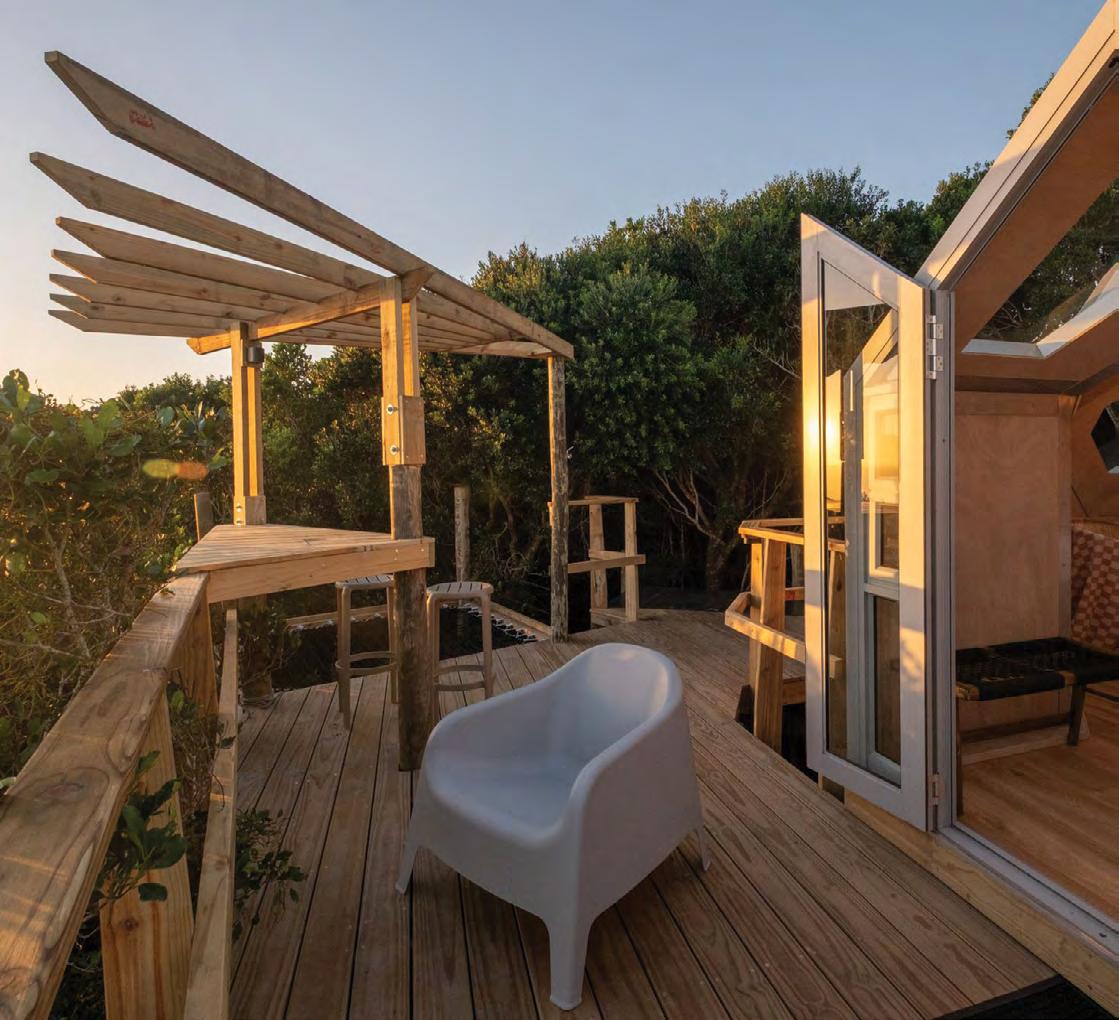
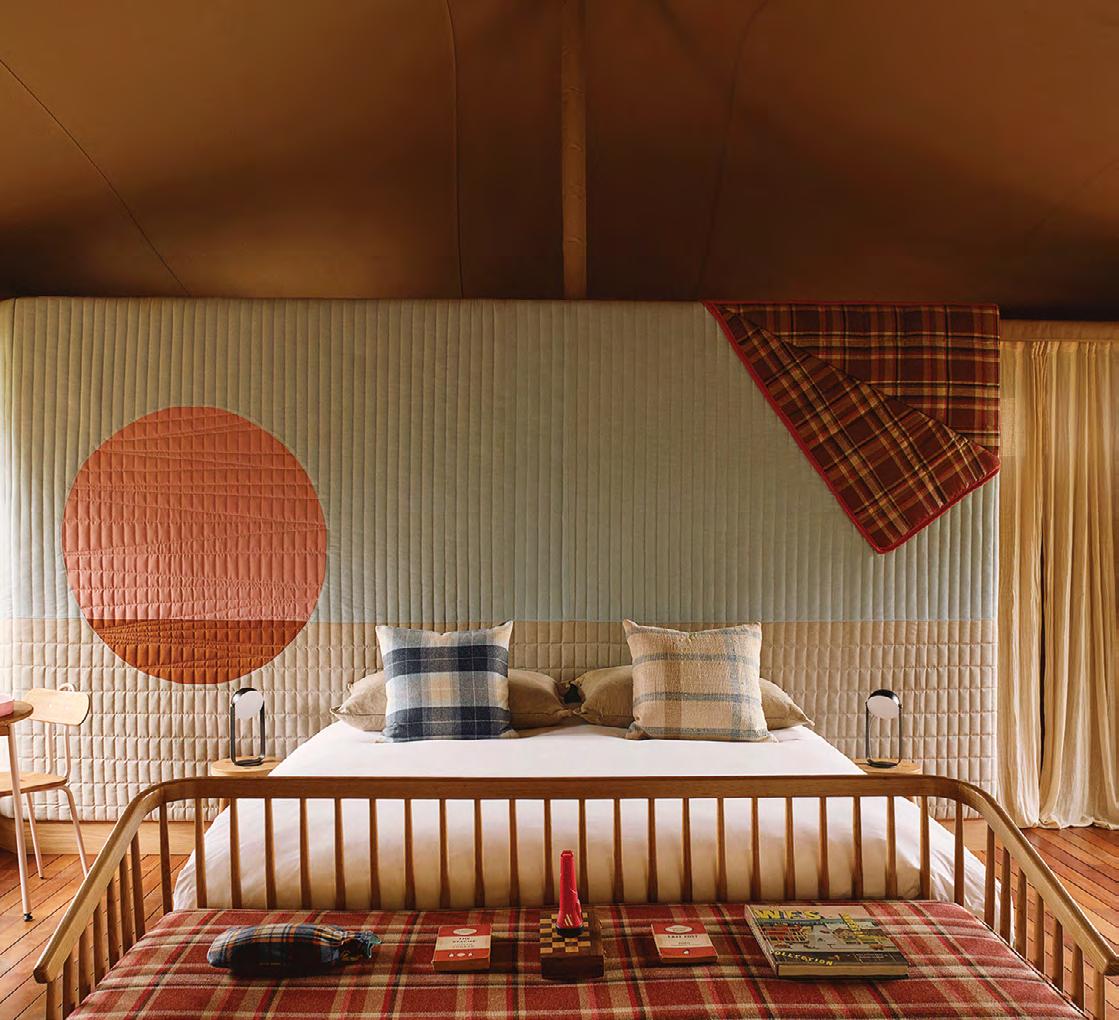
Vicki and family at Camp Canoe
WHY WILD WORKS
Boosting ROI Through Biodiverse Glamping
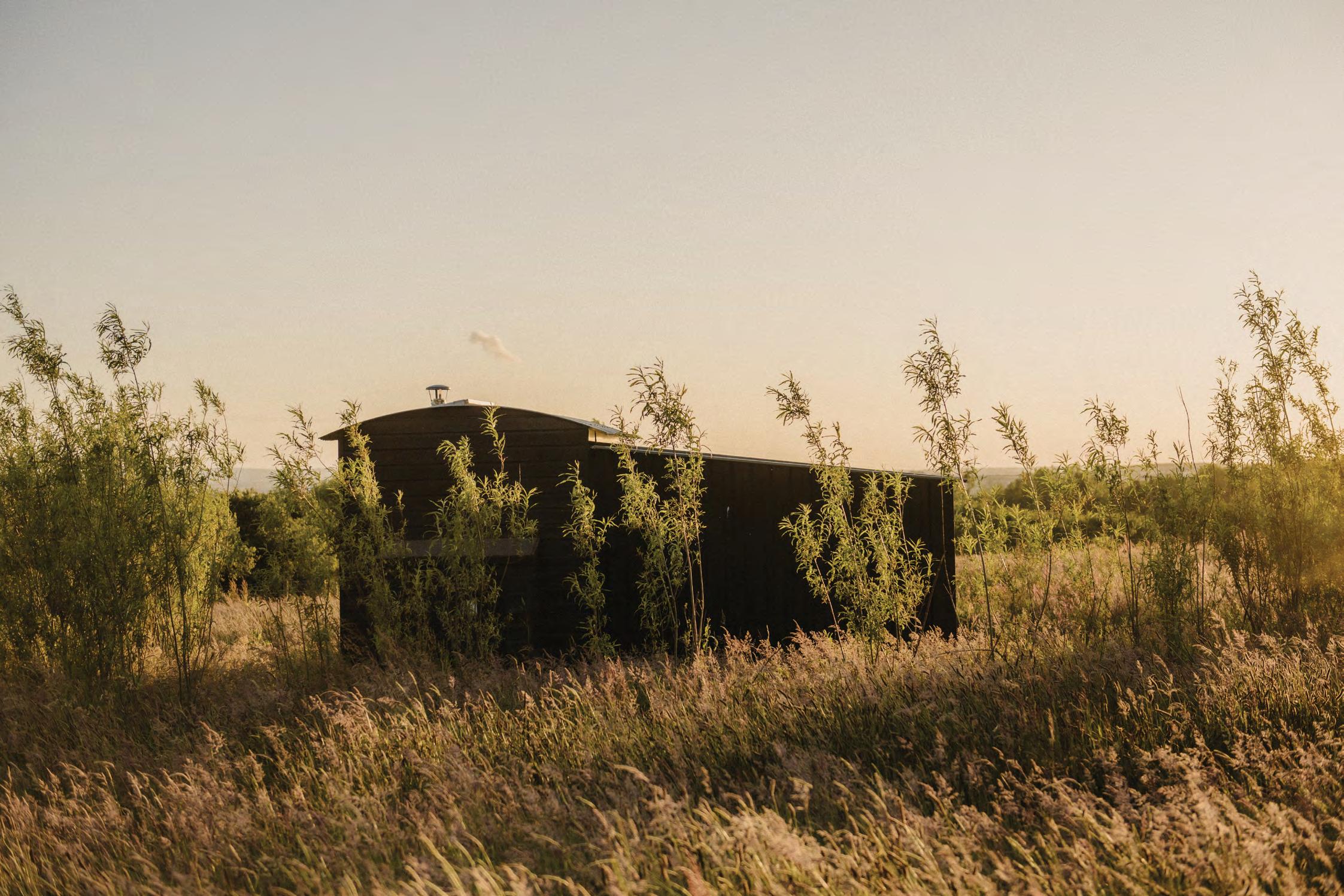
Creating a biodiverse, naturerich glamping site can bring higher returns on investment whilst also delivering on guest experience and meeting Biodiversity Net Gain requirements. It’s a win-win situation.
Policy is Changing the Landscape
The Government has taken many proactive steps towards the protection and enhancement of our natural landscapes in recent years. Nutrient neutrality credits and Biodiversity Net Gain are now enshrined in planning law,
and the Sustainable Farming Incentive was expanded to include increased payments and cover for actions around woodlands, orchards and coastal habitats, with greater flexibility and encouragement for farms that provide educational tours.
Biodiversity Net Gain (BNG) became mandatory for all developments in 2024, with the intention of ensuring that all development leaves the natural environment in a measurably better state than before. Fortunately, working with nature is
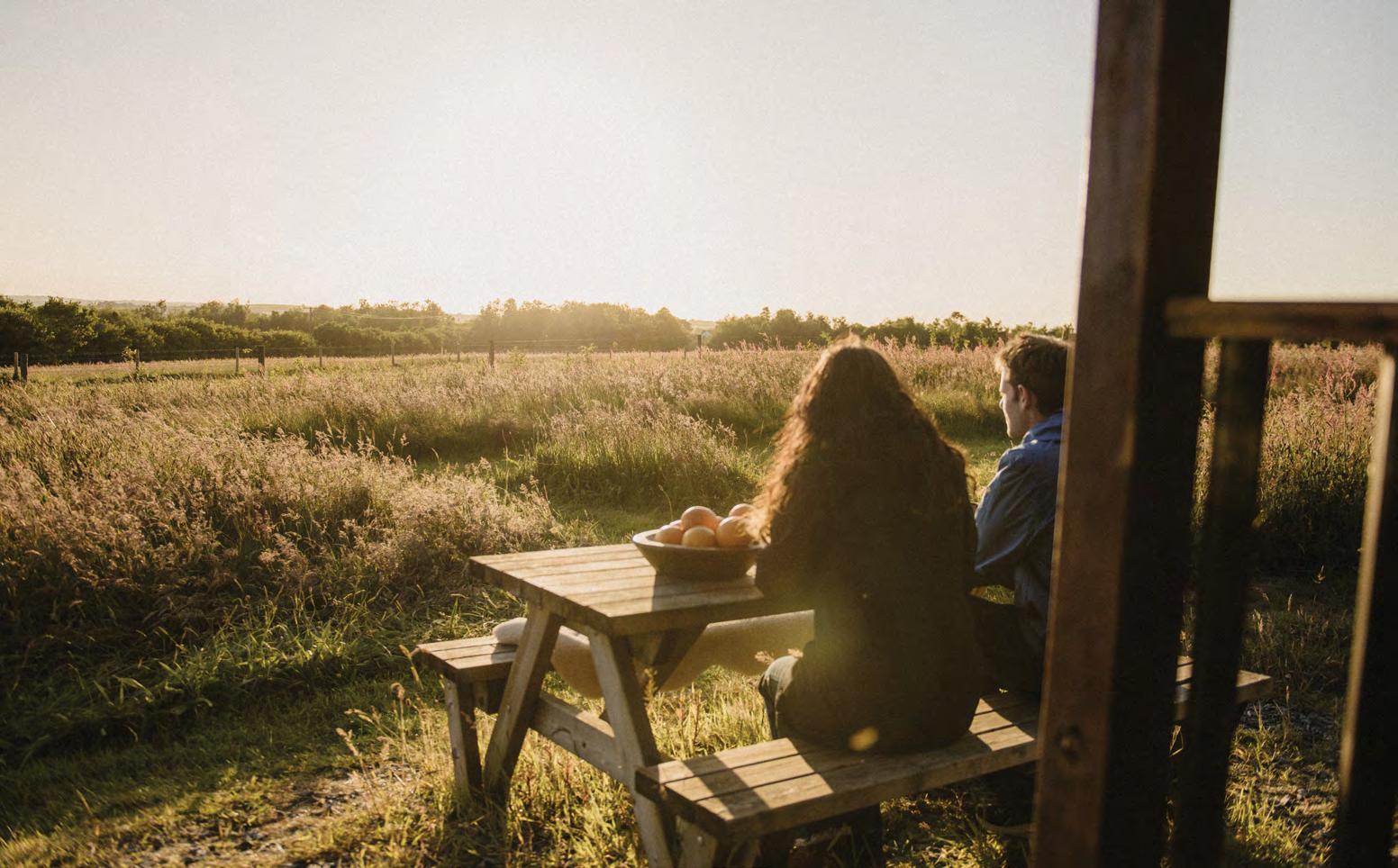
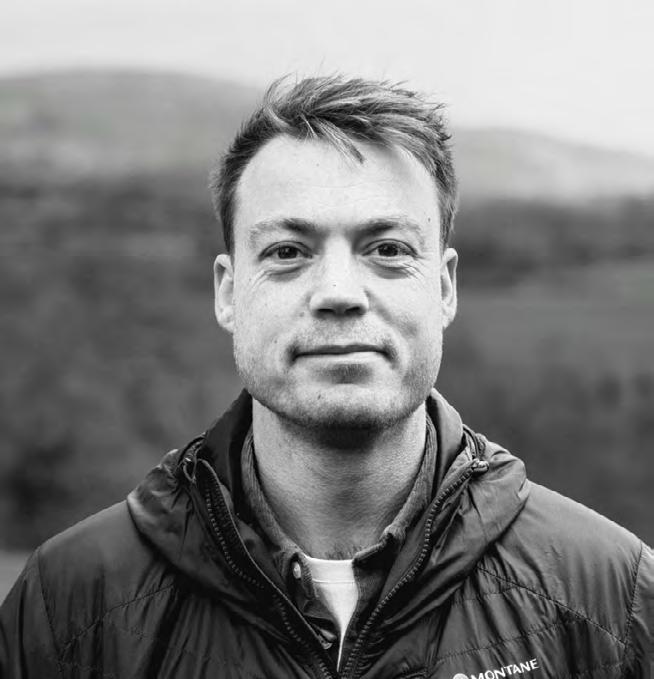
By Ed Busby, Co-Founder of Crown & Canopy
immeasurably better than working against it, and wilder sites are emerging as a trend in the glamping world.
Nature is the New Luxury
The travel industry is evolving, driven by a wave of conscious consumers concerned with sustainability, overtourism and wellness amidst rising living costs and a mental health crisis. These travellers now prioritise simplicity, environmental responsibility and restorative, relaxing experiences – qualities that are central to glamping. These qualities are also best delivered through a site that is rich in nature and considerate of the landscape. A truly biodiverse and wildlife-rich site tends to be a mix of habitats – a mosaic of sorts. These habitat mosaics also provide visual screening, mitigate landscape visual impact and create sites that are teeming with life – the
ideal setting for an immersive and experiential glamping retreat.
Designing with Biodiversity from the Ground Up
Crown & Canopy builds habitat enhancement into every project we work on, and over the years we have found that over 80% of owners who contact us are actively intent on improving biodiversity and the health of their land. While we have always approached site design with nature in mind, we now work even more closely with ecologists to ensure at least a 10% net gain is delivered on each project to meet Biodiversity Net Gain requirements and to create sites that truly deliver on nature-based guest experience. “Making the right choice for nature is also the right choice for business.”
Tackling Nutrient Neutrality
Nutrient neutrality is a mandatory requirement in some areas of the country, which ensures that new developments don’t worsen water pollution in designated protected areas. It requires developers to offset any increase in nutrient pollution (like nitrates and phosphates) caused by the development, so that there is no net increase in the nutrient load on sensitive habitats.
We address nutrient neutrality by designing in ecological waste systems or by replacing outdated septic systems with ecological alternatives such as Package Treatment Plants. In some cases, land can be changed from intensive commercial to more natural land management and, as a last resort, nutrient credits can be bought to offset the development.

Whilst this may sound simple, the reality is that credits are in short supply across the country and, when they can be purchased, they are often very expensive. We approach sites with this in mind – creating the most environmentally sound approach, resulting in the lowest offset requirement.
Rural Demand on the Rise
Consumers are beginning to demand alternatives to traditional accommodation in overstretched destinations and the environmental degradation and community impact that ensues. Our sister company and leading UK glamping agency Canopy & Stars is recording a clear move towards the more rural and wilder landscapes of the north and Scotland.
Demand is outstripping supply in the north, with requests for summer weekend bookings far exceeding the capacity of places that exist to fulfil them – and Yorkshire making its first appearance in the top three regions searched on our site. This could well be further evidence of the impact of wellness concerns on the industry, with the more rural areas of the north offering the sort of remote, open spaces that many are craving.
Rewilding as a Business Model
Crown & Canopy has worked with various estates and larger landholdings where rewilding projects have integrated an outdoor tourism accommodation element. This is a natural partnership – a symbiotic relationship between income generation and landscapescale recovery. Revenue generated by the tourism component supports the landscape recovery, whilst the rewilding landscape in turn supports a rich and authentic experience for guests and results in healthy occupancy rates and income.
Sites such as the Wilding Airfield in the Canopy & Stars collection are testament to how a biodiverse landscape can deliver for both business and nature. This abandoned airfield has been ‘rewilded’ into what is now a 90-acre nature reserve, with the Two Pines treehouse and Birch View cabin nestled amongst the trees. Occupancy for both these spaces is running at near capacity, effectively demonstrating the impact that beautiful spaces in wild landscapes can have.
Rewilding Coombeshead is another site in the Canopy & Stars collection where species reintroduction and a regenerating landscape are creating space for nature and a thriving

business. Rewild Things are treehouses set amongst the rewilded landscape of Elmore Court in Gloucestershire. The Rewild Things treehouses have performed consistently well since joining the Canopy & Stars collection and are one of their top-performing sites.
Building Biodiversity from Day One
Building biodiversity into site design from the outset brings multiple benefits:
n Meet BNG requirements of 10% net gain
n Mitigate landscape visual impact
n Create beautiful, wildlife-abundant landscapes
n Attract guests and encourage repeat bookings
n Potential to address nutrient neutrality where necessary
n Develop a site which lends itself to tranquil, nature-based retreats
n Good return on investment through high occupancy rates
Experience shows that when owners truly commit to creating a biodiverse landscape and integrate structures into this vision, they consistently report highly performing spaces. Healthy, biodiverse landscapes are resilient, beautiful and calming places to be. They contribute to ecosystem services and address policy and legislative requirements, so making the right choice for nature is also the right choice for business.
ASK THE EXPERT
Designing a Shepherd’s Hut That Feels Like a Five-Star Escape
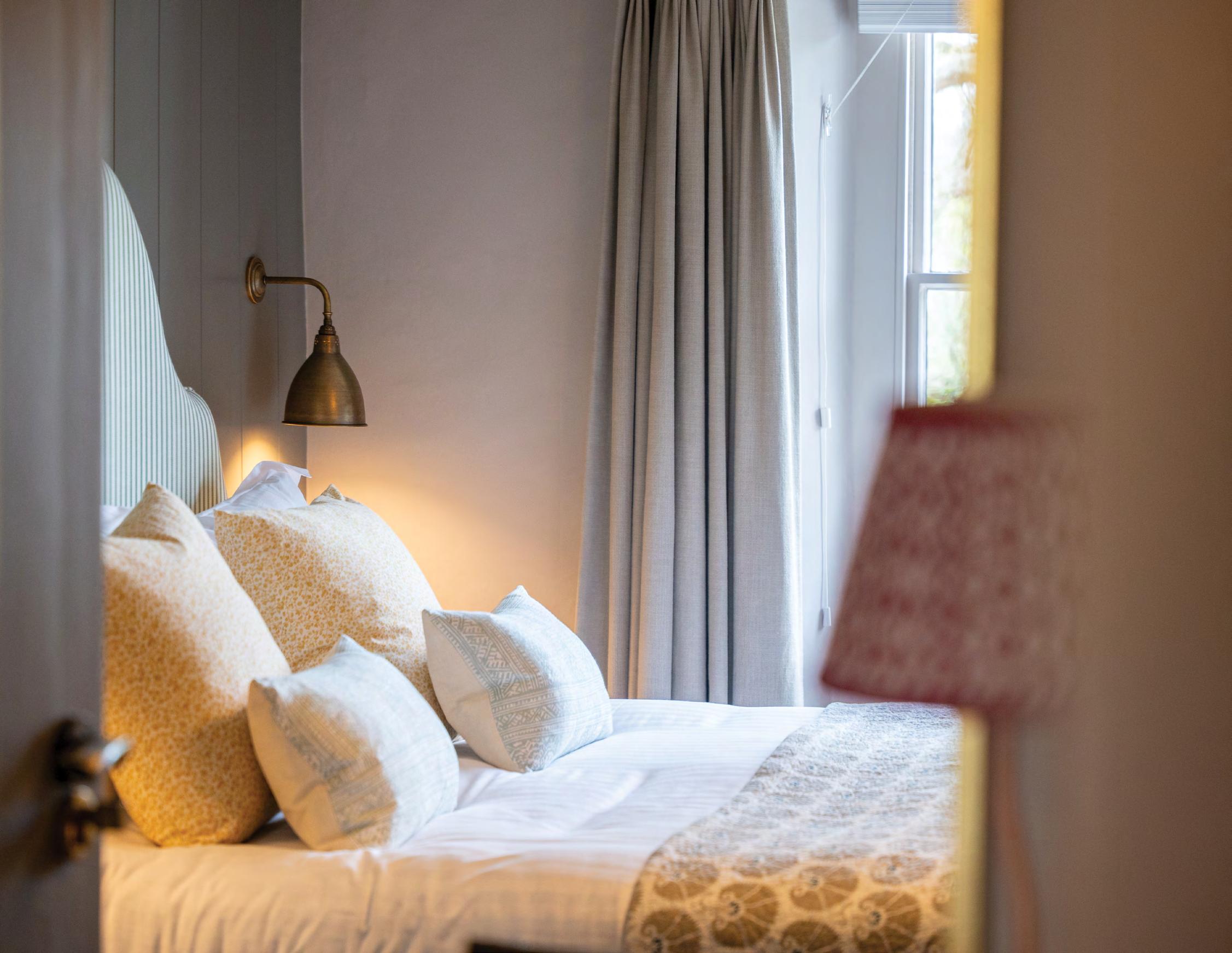
By Charlotte Dawson, Chestnut Interiors
Step through the little door of a well-designed shepherd hut, and something quiet and magical should unfold. There’s a sense of stillness, warmth, and welcome: the kind that makes guests instinctively slow down, take a deep breath, and unwind into a restful stay.
This is the art of memorable design. In an increasingly polished glamping market, where guests have slept in treehouses, domes, and cabins with outdoor baths, a shepherd hut must be more than charming – it must be thoughtfully crafted to feel like a retreat worth seeking out. It must offer more than a wellfunctioning small space; it should bring an experience guests saviour and crave when they leave.
The Bones
Start with the bones; walls clad in painted panelling or lime washed timber to create an immediate sense of character and quality. A deep heritage green or chalky blue can cocoon the space, helping it feel grounded and restful. Taking colour cues from the local landscape –think coastal greys, soft ferns, sunbaked stone –will inspire a palette that feels both rooted and
extends the accommodation beyond the door. Joinery plays a quiet but powerful role in elevating a hut. Bespoke built-ins, like a window seat with storage beneath or a cleverly tucked-away mini kitchen, make the most of every inch and give the sense that the space was designed, not just filled.
However, it’s the layers that bring the extra appreciation and sensory stay. Textiles should be tactile: linen, wool, velvet – each inviting touch. Bedding that’s crisp and cloud-like, cushions with texture and weight, curtains that softly pool rather than hang stiff. Lighting, too, should feel considered: wall lights with warm glow, reading lamps by the bed, soft lights grazing a tongue-and-groove ceiling. Avoid anything too clinical or bright – guests should feel wrapped in calm ambiance.
Creating
Moments
There’s always the temptation to pack a hut with features, but restraint is part of the art. Instead of cramming in a table, a pair of chairs, a bench, and a wardrobe, consider what will actually enhance the experience. One beautiful armchair beside a small table might say ‘curl up with a book’ far better than four cramped pieces.
Designing unforgettable spaces means creating moments. The headboard upholstered in a printed fabric with earthy tones. The hand-thrown mugs left by the kettle. A scent that lingers (a signature blend of cedar and bergamot, perhaps) that instantly conjures the hut even once they’ve left.
Guests remember how a space made them feel. They’ll talk about the rainfall shower under a skylight, or the way the curtains filtered the morning light like a watercolour wash. These are the memories that lead to return visits and glowing reviews.
A shepherd’s hut is small, yes – but when designed with care and intention, it becomes a world of its own.
About Charlotte Dawson
Charlotte is an interior designer based in Cornwall, specialising in atmospheric, guestfirst design for boutique accommodation and hospitality spaces. From living with a disability, her work is led by comfort, natural materials, and a passion to create spaces that guests fall in love with.
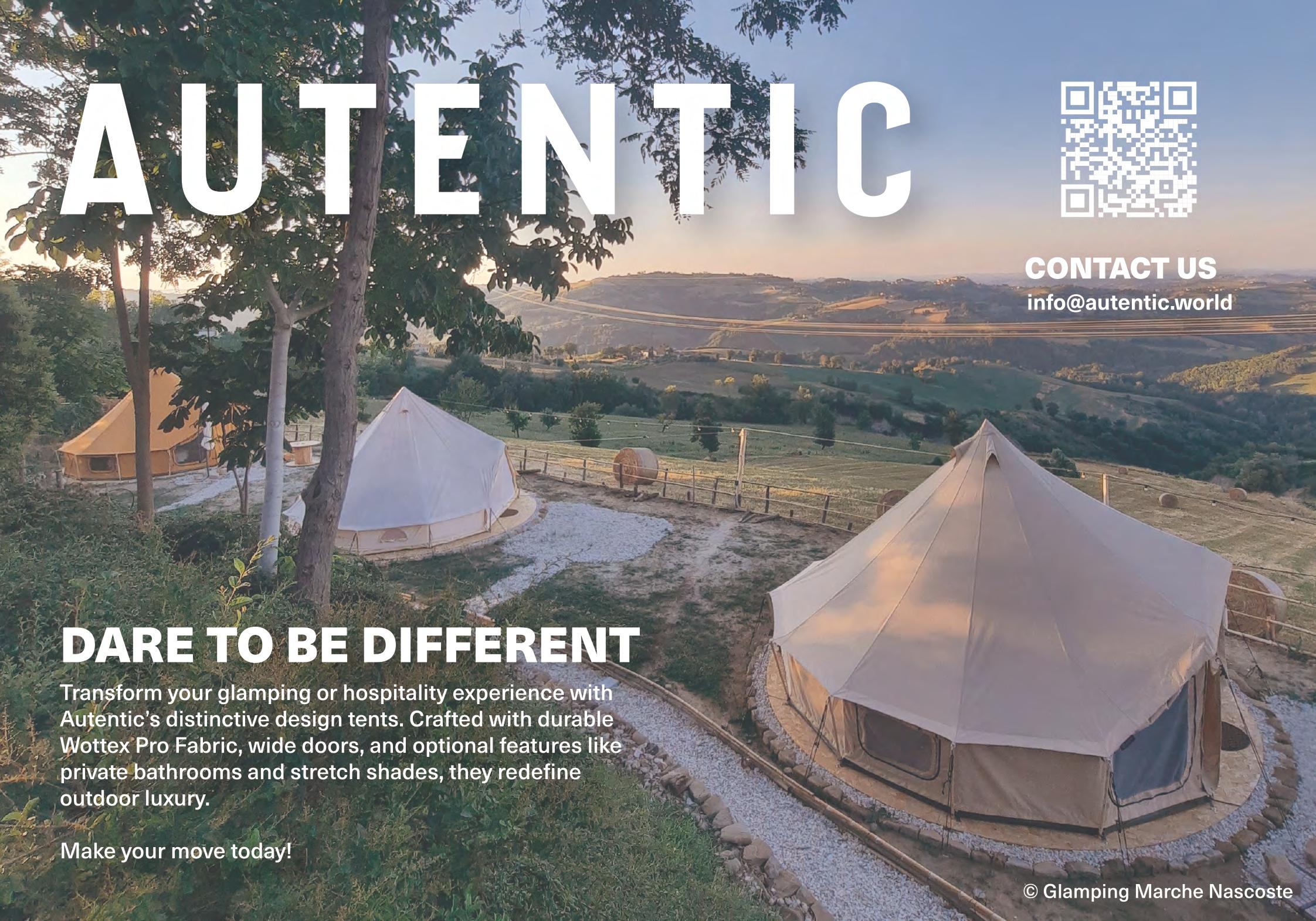
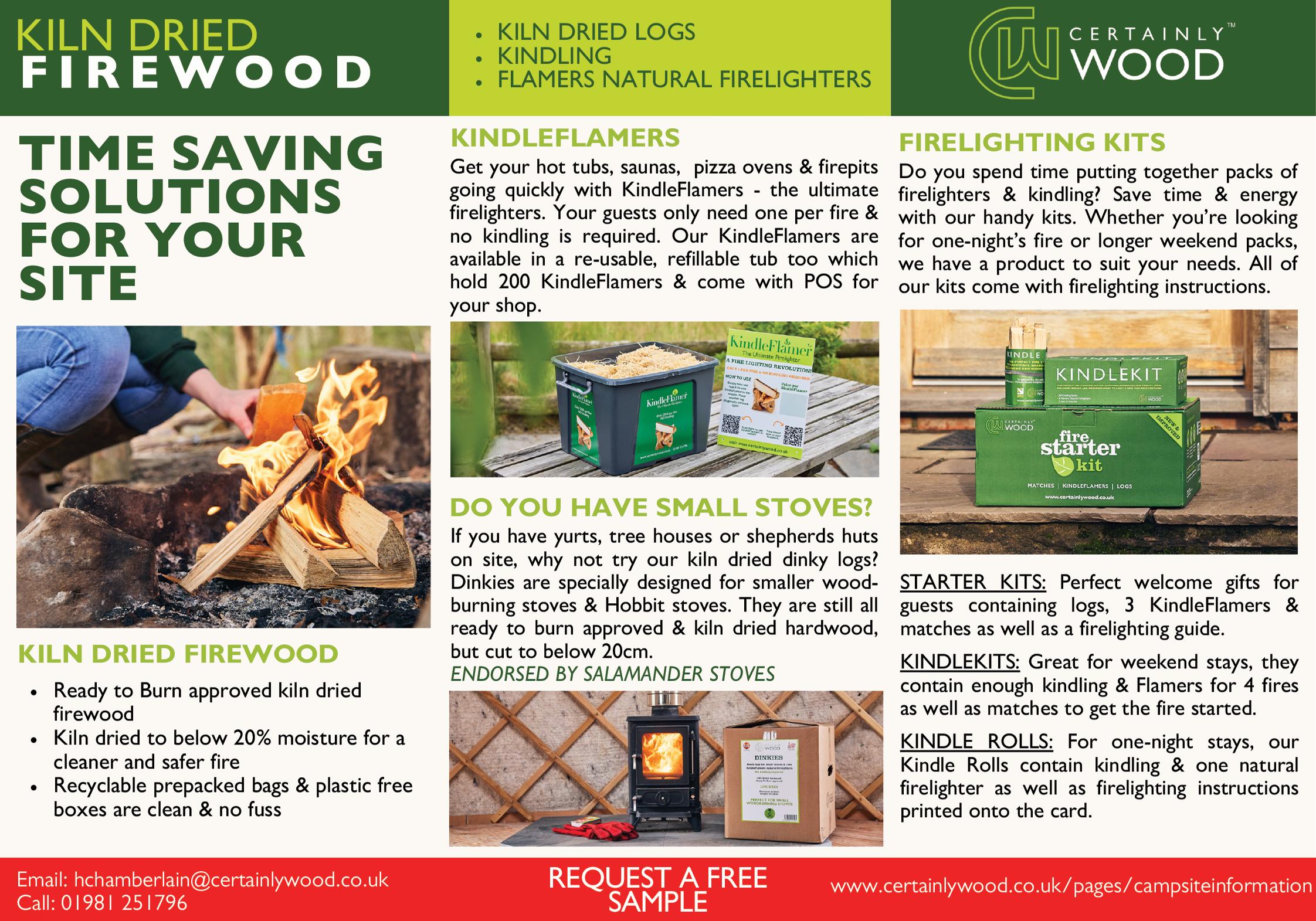

DIY GUIDE TO DESIGNING GLAMPING SPACES
Blending comfort, nature, and personality, this fast-paced guide will help get you started with practical ideas, broken down into style directions, mood goals, and quick wins.
But, before picking out furniture or colour palettes, ask yourself how you want your guests to feel – every design choice flows from this. No matter your style, consistency is key. Choose 3-4 main materials, a unified colour scheme, and repeat textures across the space for a polished look. You can even create a physical moodboard with swatches and samples, or a digital version using platforms like Pinterest.
And don’t forget, your photos are often the first impression guests get. High-quality, well-lit images showcasing your space’s unique style can make all the difference in bookings.
Professional or well-planned amateur photos help guests envision their stay, which builds expectation and enhances brand appeal.
Rustic
Vibe: Mountain cabin meets boho hideaway.
Materials: Reclaimed wood, raw timber beams, cast iron, wool, leather, canvas
Color Palette: Forest green, burnt sienna, deep reds, mustard, warm browns
Textures: Chunky knits, flannel, rough-cut wood, braided rugs, animal hides
Lighting: Lantern-style sconces, Edison bulbs, fairy lights on twine, candlelight
Scent Profile: Pine, cedarwood, fireplace smoke, spiced cinnamon
Key Accessories: Vintage trunks, antler coat racks, enamel mugs, wool blankets, sheepskins
Flooring: Worn wood planks or rugs layered over natural ground
Guest Mood: Comforted, grounded, safe; like curling up in a cabin on a rainy day.
Modern
Vibe: Sophisticated retreat where nature meets design.
Materials: Polished concrete, matte black steel, light birch, glass, brushed brass
Color Palette:
Soft whites, charcoal, sage green, beige, pale ashwood
Textures: Smooth linens, fine cotton, matte ceramics, clean-edged upholstery
Lighting: Track lighting, LED strips, geometric pendant lights, integrated solar
Scent Profile: Eucalyptus, white tea, crisp air
Key Accessories: Wall-mounted storage, minimalist art, essential oil diffuser, low benches
Flooring: Clean rugs over raised platforms or bamboo slats
Guest Mood: Calm, uncluttered, reflective; space to breathe and reset.
Coastal
Vibe: Laid-back barefoot escape by the sea or a lake.
Materials: Whitewashed wood, woven rattan, linen, rope, driftwood
Color Palette: Ocean blues, soft whites, sandy beige, seafoam green
Textures: Light gauze curtains, soft throws, jute rugs, beach pebbles
Lighting: Natural daylight, wicker pendant lights, glass hurricane lamps
Scent Profile: Sea salt, coconut, lemon verbena
Key Accessories: Glass jars, woven baskets, shell accents, hanging hammocks
Flooring: Pale wood or beachy rugs on sand or decking
Guest Mood: Breezy, refreshed, calm; like waking to waves and sunbeams.
Jungle Luxe
Vibe: Bold, sensory, immersive; a nature-rich indulgence.
Materials: Bamboo, teak, stone, linen, tropical hardwoods
Color Palette: Emerald green, ochre, mustard, dark teak, jungle black
Textures: Woven palm mats, silky fabrics, organic cotton, carved wood
Lighting: Hanging lanterns, filtered natural light, string lights in foliage
Scent Profile: Rainforest after rain, lemongrass, sandalwood
Key Accessories: Canopy beds, oversized plants (monstera, palms), tribal or botanical prints
Flooring: Stone slabs, jungle deck, waterproof matting
Guest Mood: Energised, enchanted, alive; like exploring a luxury treehouse in the tropics.


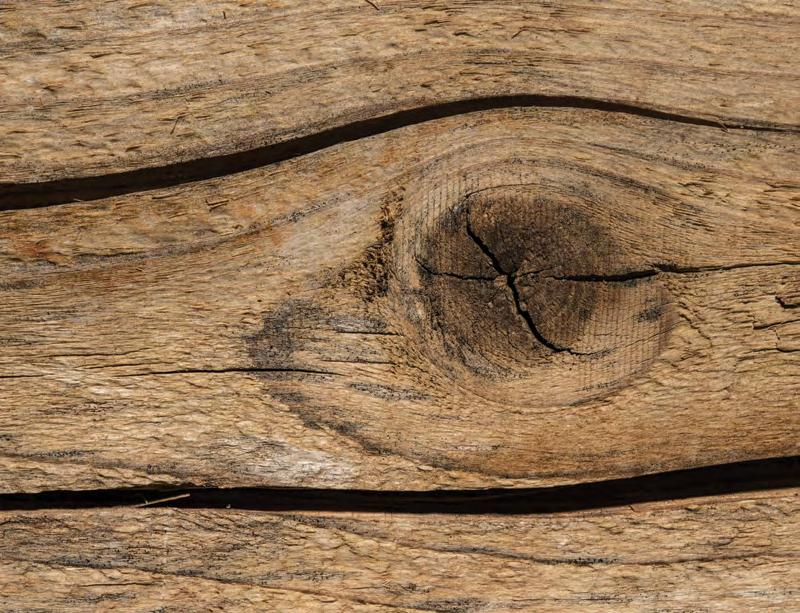



By Nick Purslow, Co-Founder of Posh Outdoors

THE GREAT HUSTLE Turning a Vision into Bookings
The last time Posh Outdoors was featured in International Glamping Business, we’d done nothing of interest. It was May 2024 and we had just begun the capital raise that would fund our first location. At that point, we had no glamping units, no guests, no anything – but we had an idea, and we were bullish about it.
As a refresher, Posh Outdoors forms revenue share partnerships with landowners. We send them modular, year-round lodging structures (like mirror cabins), they run things on the ground, and we split the revenue.
The beauty of this model is that it scales fast. Get things right, and we could have dozens of locations in just a few years. But first, we
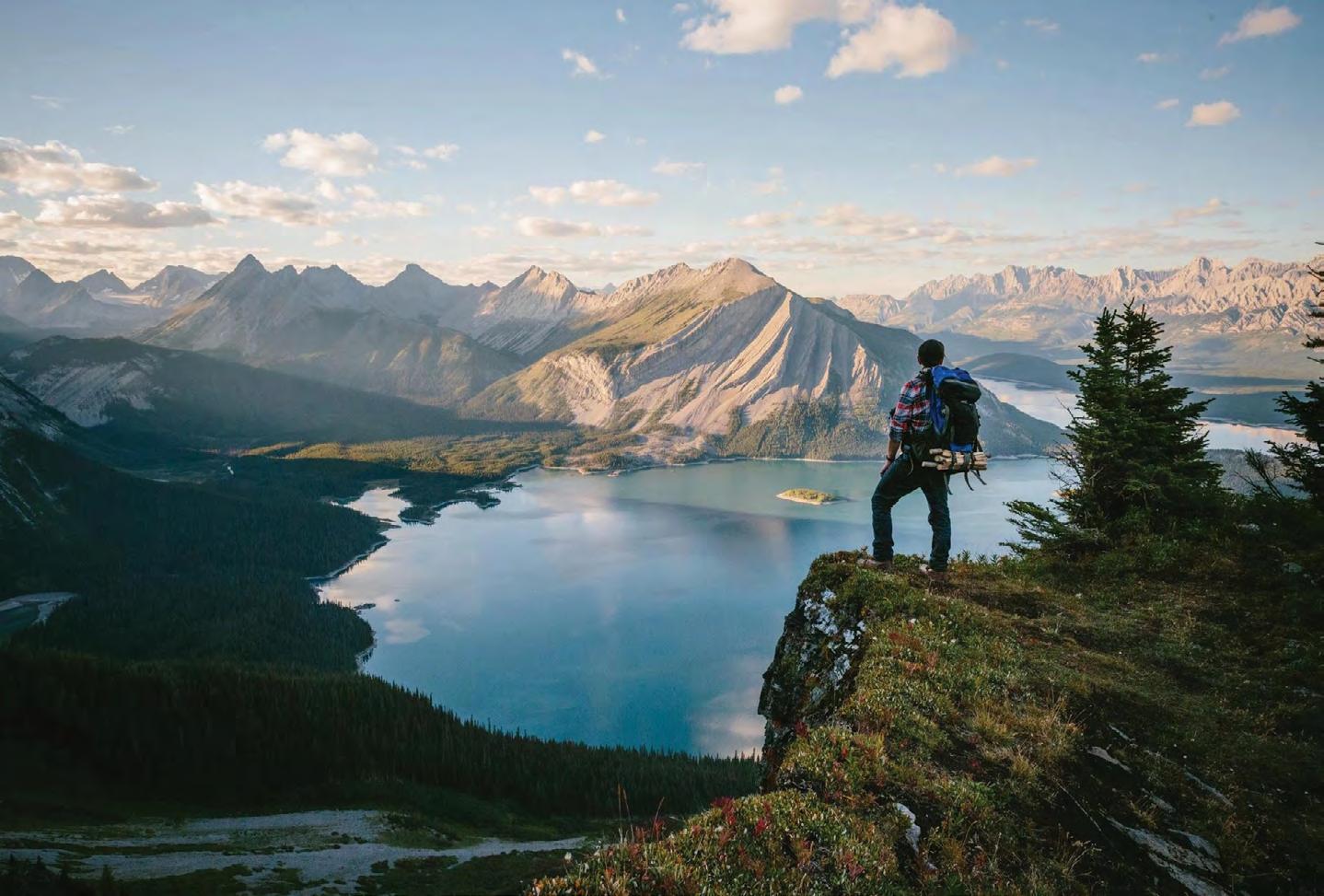
needed to get Location #1 off the ground. And that was no small feat. In fact, it was the hardest thing I’ve ever done.
Funding Skyridge Glamping
We struck gold with our first location, Skyridge Glamping: an existing 10-unit glamping resort in Kananaskis, a hidden gem in the Canadian Rockies, less than an hour from Banff National Park. It’s surrounded by all the hiking trails, ski slopes, and adventure you could dream of.
We’d agreed to supply Skyridge with 5 “SkyGlass” mirror cabins in a 20-year deal that would see us take a chunk of their accommodation revenue. To fund these cabins, we decided to raise money through equity crowdfunding, meaning anyone could invest for as little as $100.
For our crowdfunding campaign, we were investors offering a piece of the Posh Outdoors mothership, rather than the specific Skyridge deal. So we had to sell them on the potential of Posh Outdoors (i.e. it’s ability to scale to dozens of locations). But the initial investor money would directly fund Skyridge, and it naturally formed a big part of our pitch.
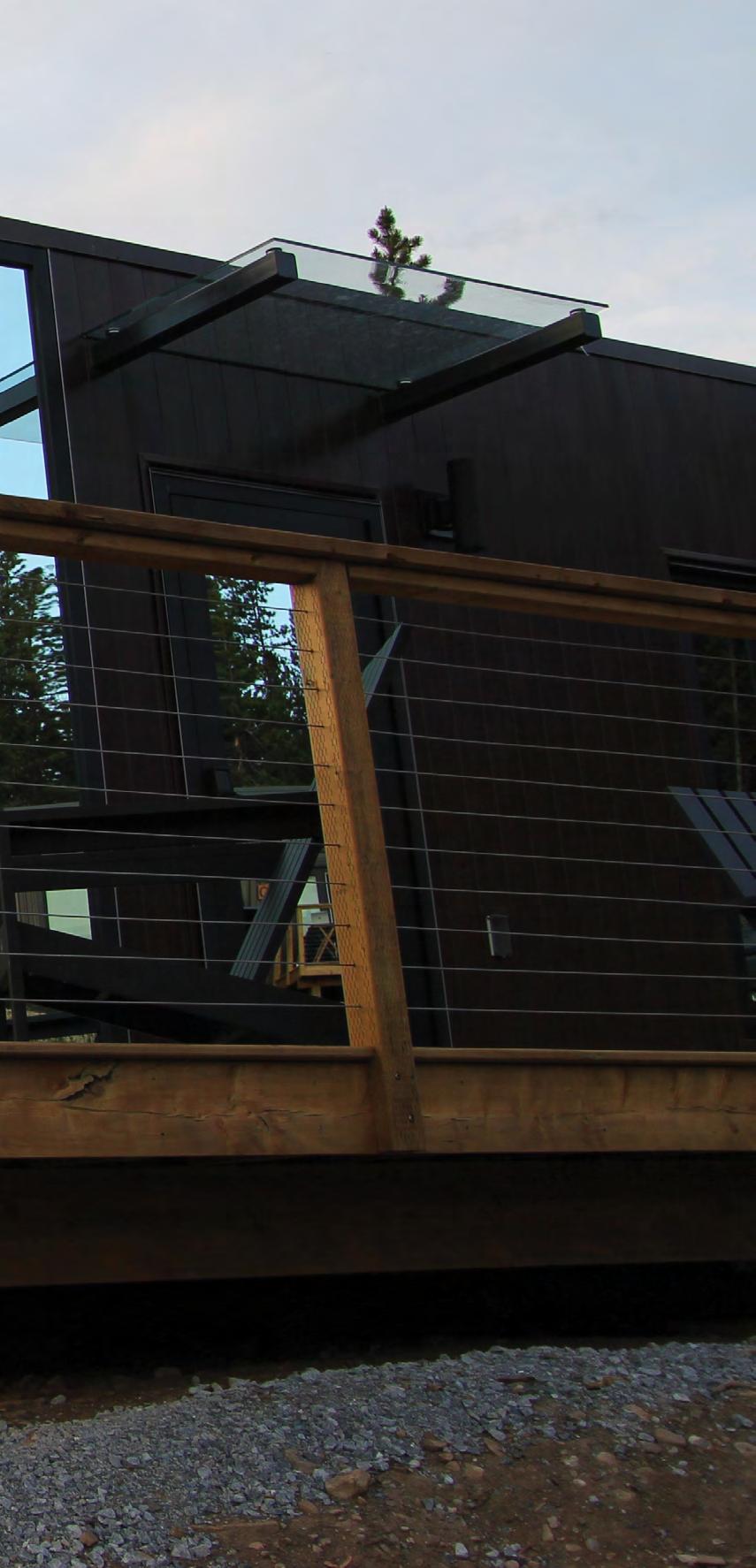
Given the potential of the Posh business, and how outrageously beautiful the Skyridge property was, we thought raising the $750,000 we needed would be a walk in the park… How wrong we were.
Beginning in April 2024 with around $60k from my co-founder Lee’s friends, we attacked the cap raise with everything we had. We emailed and called everyone we could possibly think of. Our mailing lists, our business networks, friends, family – anyone. We worked non-stop to get things moving, but the money wouldn’t come.
Every day, we’d wake up determined to raise some cash. Every night, we’d end up hunched over our laptops, head in hands, having failed to bring in a single cent. But Team Posh doesn’t quit. We kept going, and going, and going. We believed in our offer, and we weren’t going to give up without a fight.
On the morning of May 9th 2024, we landed our first big investor. Later that day, we hooked another. We suddenly had $166,588 in the pot – Posh Outdoors was back in business. That small flurry of investment gave us momentum. In late July, we hit $275k. By
August we’d passed $400k and had placed an order for our 5 SkyGlass mirror cabins.
By the time we closed the community round on April 30 2025, we’d raised $748k after a mammoth 13-month effort. We’ve since closed an additional $250k private placement and are on track to raise another $250k.
The lesson? Work relentlessly, knowing that you’ll have setbacks. When those setbacks come, remember that they were inevitable, and push through. Progression is never linear. Raising the money felt great, but it was only a small part of the job. Once Skyridge was built, we had to launch the damn thing.
Launching
Skyridge Glamping
We wanted our 5 units at Skyridge to get as many up-front bookings as possible. Not only would it bring money through the door, but it would be a statement. Start well, and Posh would have truly arrived on the glamping scene.
We decided to take a unique approach to the launch. We’d run Facebook ads for 2-3 months, asking people to place a $35 CAD (c. $25 USD) deposit. These deposit holders would be known as “Skyridge VIPs”, and they’d get first access to the booking calendar and a discount on their stay.
The aim was to build a list of as many VIPs as we could, and open the booking calendar exclusively to them at 9am on May 13th – cue a flood of bookings. It was a brave move. It meant holding off on taking bookings for several months. Getting ready for the big launch required a ton of prep. Thankfully, it worked beautifully.
By the time May 13th rolled around, we had around 2,000 Skyridge VIPs ready to make their booking. Those first couple of hours when the booking calendar opened were pure chaos. Our email inboxes were bombarded, the phone was ringing off the hook, and our DMs were on fire. But we worked through it and within 24 hours we’d generated $295,000 USD of booking receipts. It was exactly the kind of statement we wanted to make.
Six weeks on, our booking receipts stand at more than $325,000. Our June occupancy is at 85%, with an average daily rate of $466 USD. Even if we don’t make a single booking for the rest of the year, our 2025 occupancy will exceed 50%. So far, so good. But there’s still work to do.
What’s Next?
Right now, our time is split between tweaking things at Skyridge and planning our next locations. At the Skyridge level, we’re figuring out a long-term marketing plan, working with the operator to improve the guest experience, and implementing systems that will make it run like a well-oiled machine. Beyond that, we’re working on Locations #2 and #3. We have an exciting pipeline of beautiful properties lined up across the US and Canada, and I’m excited to share the journey with you.
If you’d like to follow along, you can subscribe to my Glamping Insider newsletter, where I share the secret strategies of the best operators in the business, along with all the latest Posh Outdoors news.
If you have a property, or are interested in investing, get in touch with Nick at nick@ posh-outdoors.com

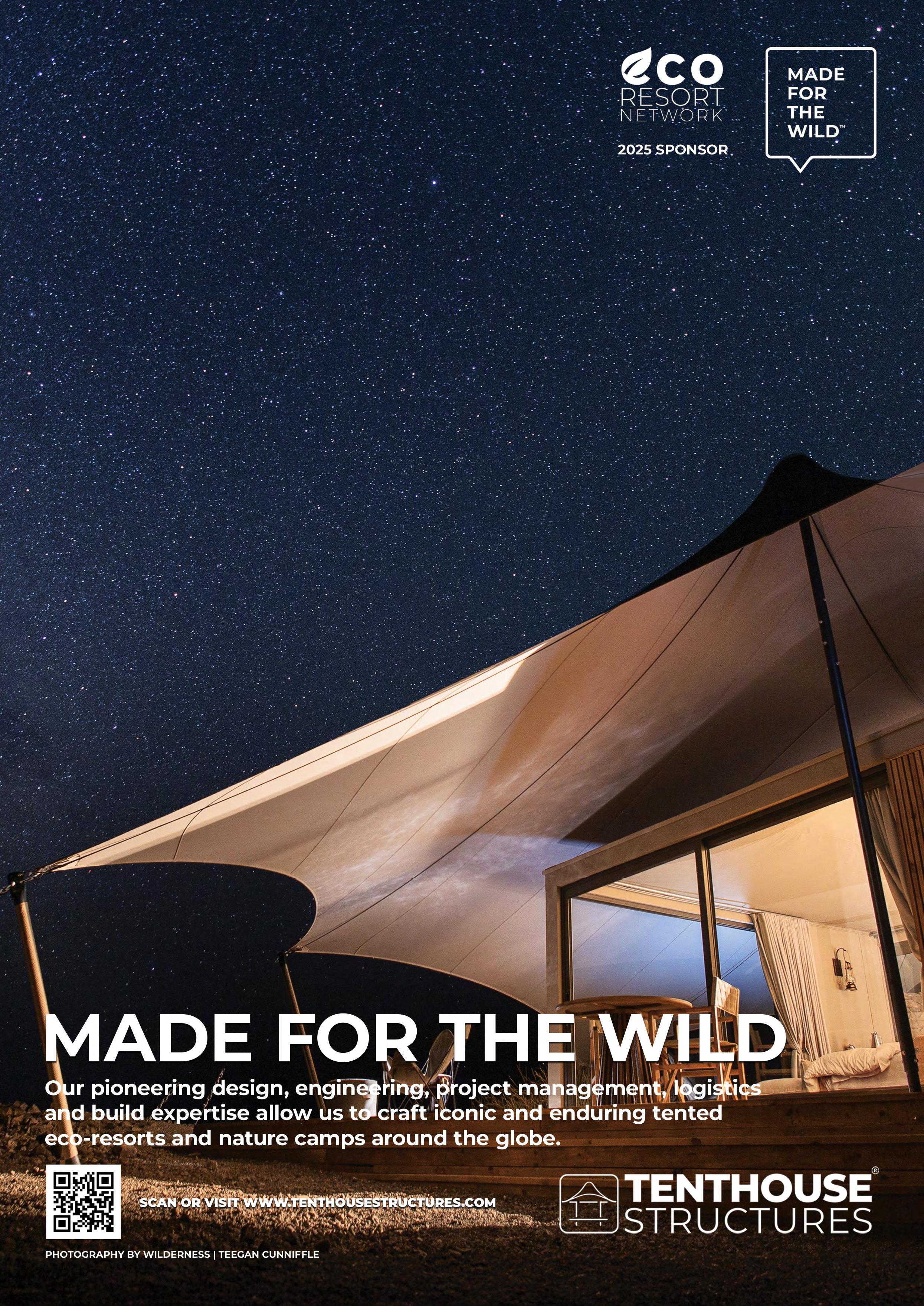
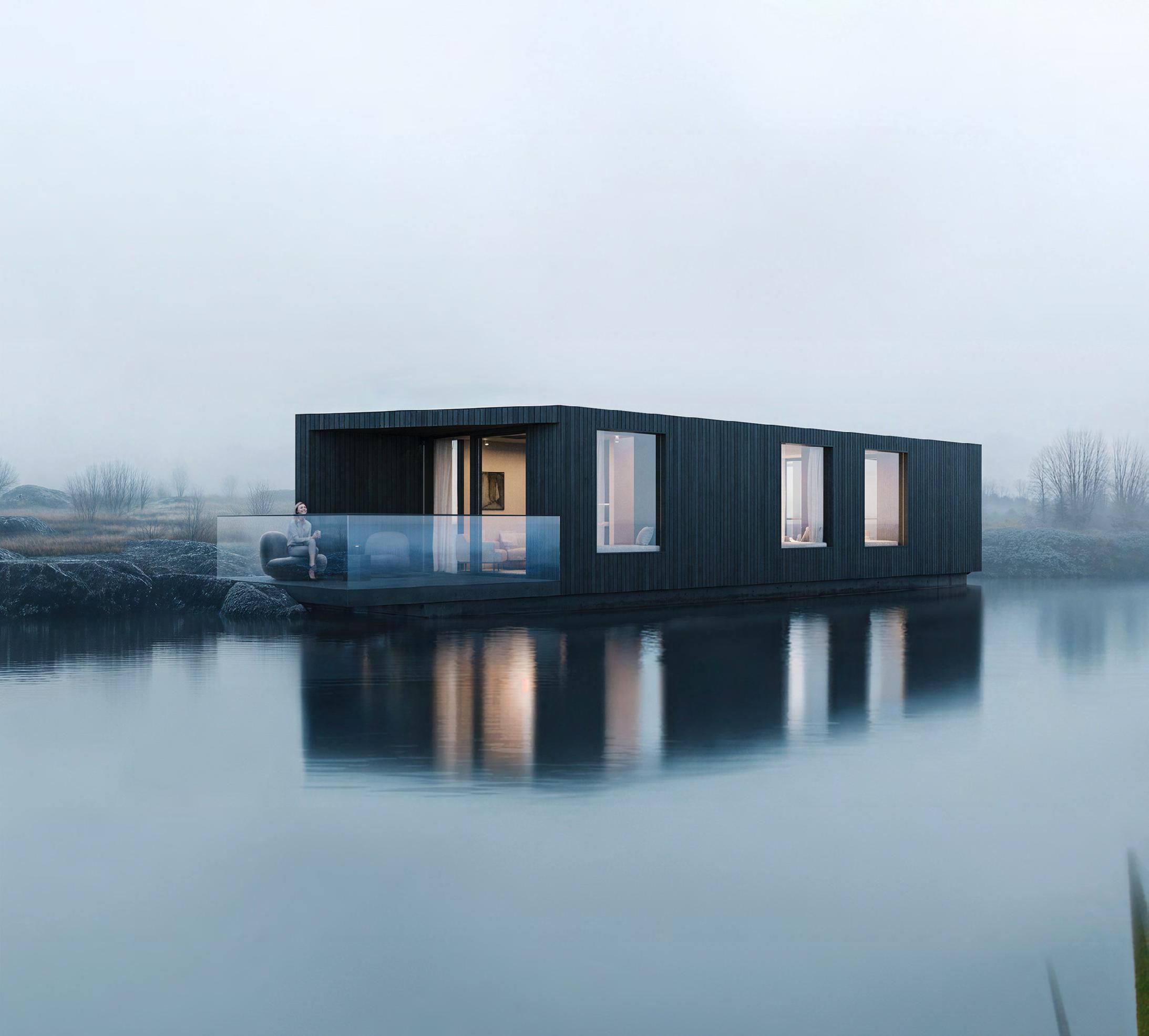
Koto’s Design-Driven Approach HOUSEBOAT HOSPITALITY
Koto’s new houseboats offer a fresh take on glamping, combining Nordic-inspired minimalism with a deep connection to nature. Designed to bring guests closer to the calm and rhythm of life on the water, they represent a distinctive opportunity for operators looking to elevate their accommodation offering. International Glamping Business spoke with the team at Koto to learn more about its inspiration, design thinking, and commercial potential.
Where did the inspiration come from for creating cabin-style living on the water?
Our design philosophy has always been rooted in place, and few environments offer a more immersive connection to nature than water. The houseboats were inspired by the calm simplicity of Nordic cabins, the quiet rhythm of lake life, and a desire to create
architecture that floats both physically and emotionally. We saw an opportunity to offer guests a sense of retreat and refuge, with the soft lapping of water becoming part of the architecture itself.
What kind of guest experience are you aiming to create with these homes?
These floating homes are designed to slow people down. Every detail, from the natural
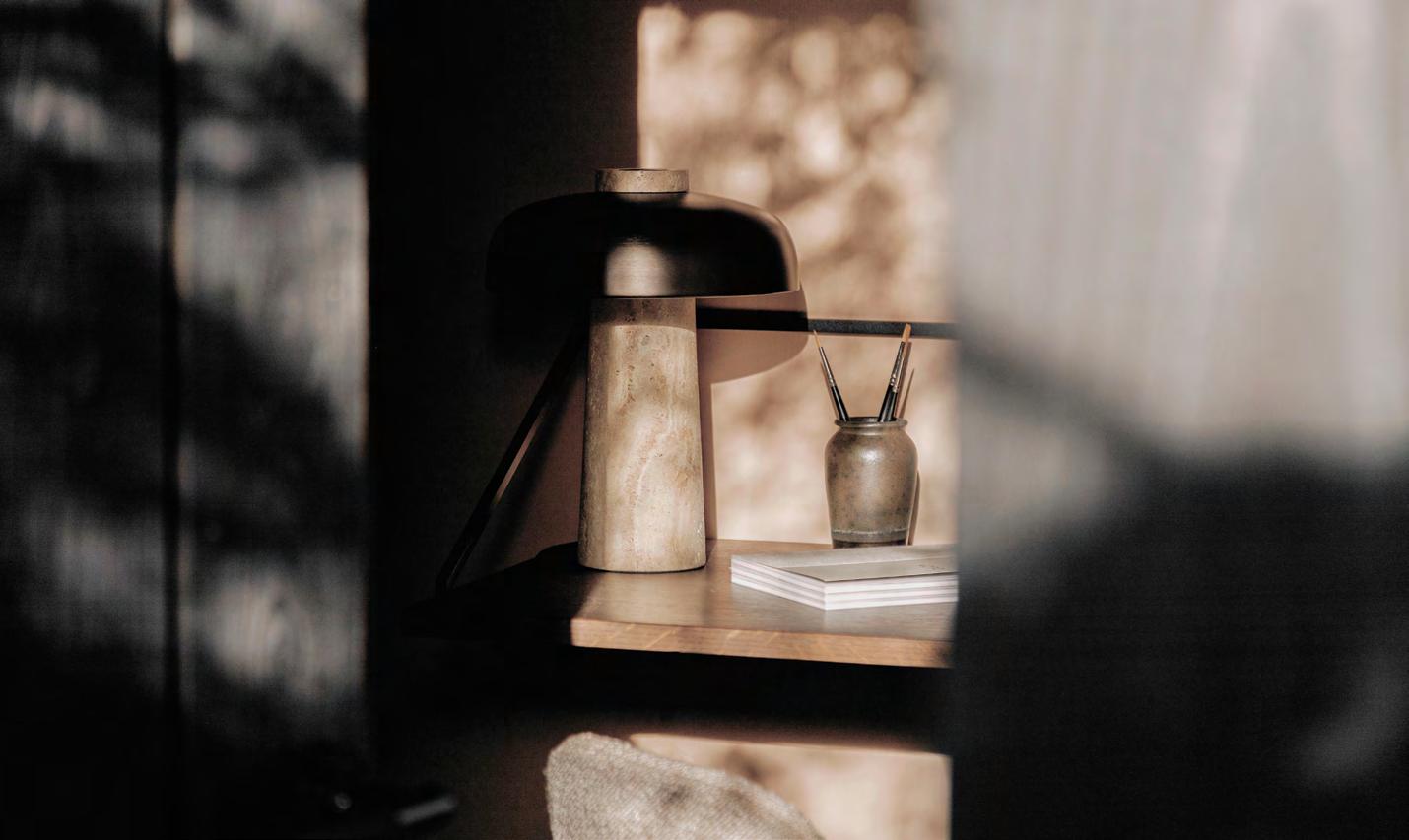
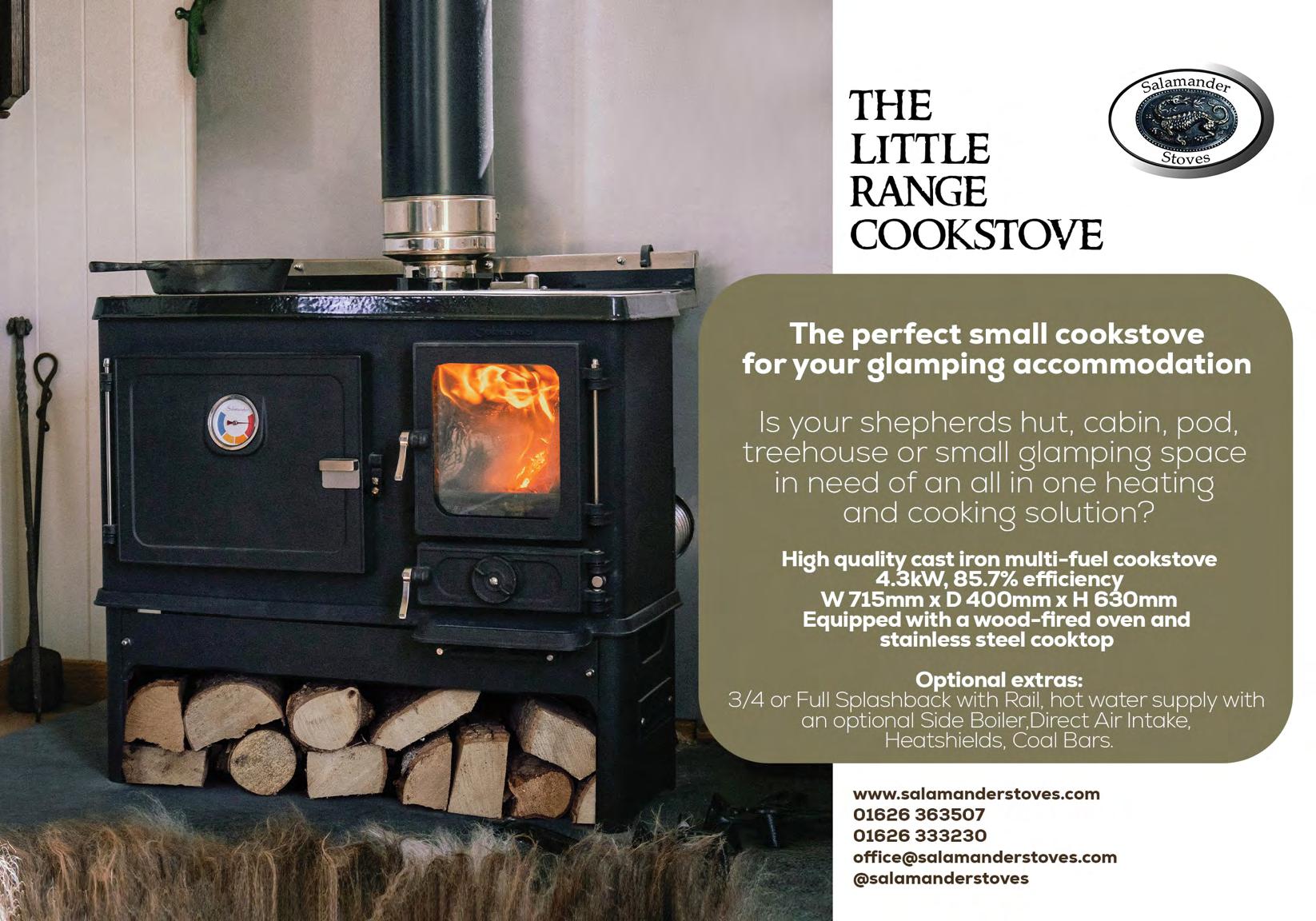

timber finishes to the sightline across the water, is about creating stillness. The guest experience is minimal but warm, deeply connected to nature and restorative. Whether you’re waking up to morning mist or watching dusk settle over the water, there’s a sense of presence that’s hard to find elsewhere.
Are there customisation options for operators looking to tailor the cabins to their specific location or brand?
Absolutely. We understand that each landscape and operator has a unique character. We offer a range of off-the-shelf models with curated colour palettes and material finishes, designed for adaptability. For operators seeking something more tailored, we also offer a bespoke design service, allowing for custom layouts, detailing, and finishes that respond directly to local context, guest expectations and brand identity.
What does the return on investment (ROI) look like for operators interested in adding these units to their sites?
Water-based accommodation has high aspirational value. It is often the most desirable units on site, commanding premium nightly rates. Their uniqueness drives interest, bookings, and PR visibility. The build quality ensures long-term durability, and offsite fabrication keeps installation time (and disruption) minimal. For operators seeking a differentiated, high-performing asset, they represent an intelligent long-term investment.
How do operating costs compare to more traditional land-based glamping accommodations?
Operating costs are competitive, and in some cases, more efficient. The energy strategy for the houseboats includes optional solar integration and high insulation performance, reducing long-term utility costs. Because the structures are designed as high-spec cabins with tight tolerances and durable materials, maintenance is streamlined. There are logistical considerations around water access, but overall, they deliver strong lifecycle value for operators.
Are you planning to roll these out to more glamping sites in the near future?
Yes, we’re currently in discussions with several premium locations both in the UK and internationally. The appetite for meaningful, nature-connected stays continues to grow, and we see the houseboats as a distinctive, scalable solution for designled operators. Our next step is to bring this concept to more beautiful places, working closely with partners who share our ethos of exceptional design, simplicity and sustainability.
What unique challenges come with designing for water rather than land, and how did you solve them?
Designing for water presents both unique challenges and exciting possibilities. Key considerations included buoyancy, anchoring, movement, and environmental resilience. To address these, we collaborated with one of the UK’s leading houseboat builders, ensuring that the design is not only stable, secure, and compliant but also integrates technical performance with the architectural aesthetic we are known for.
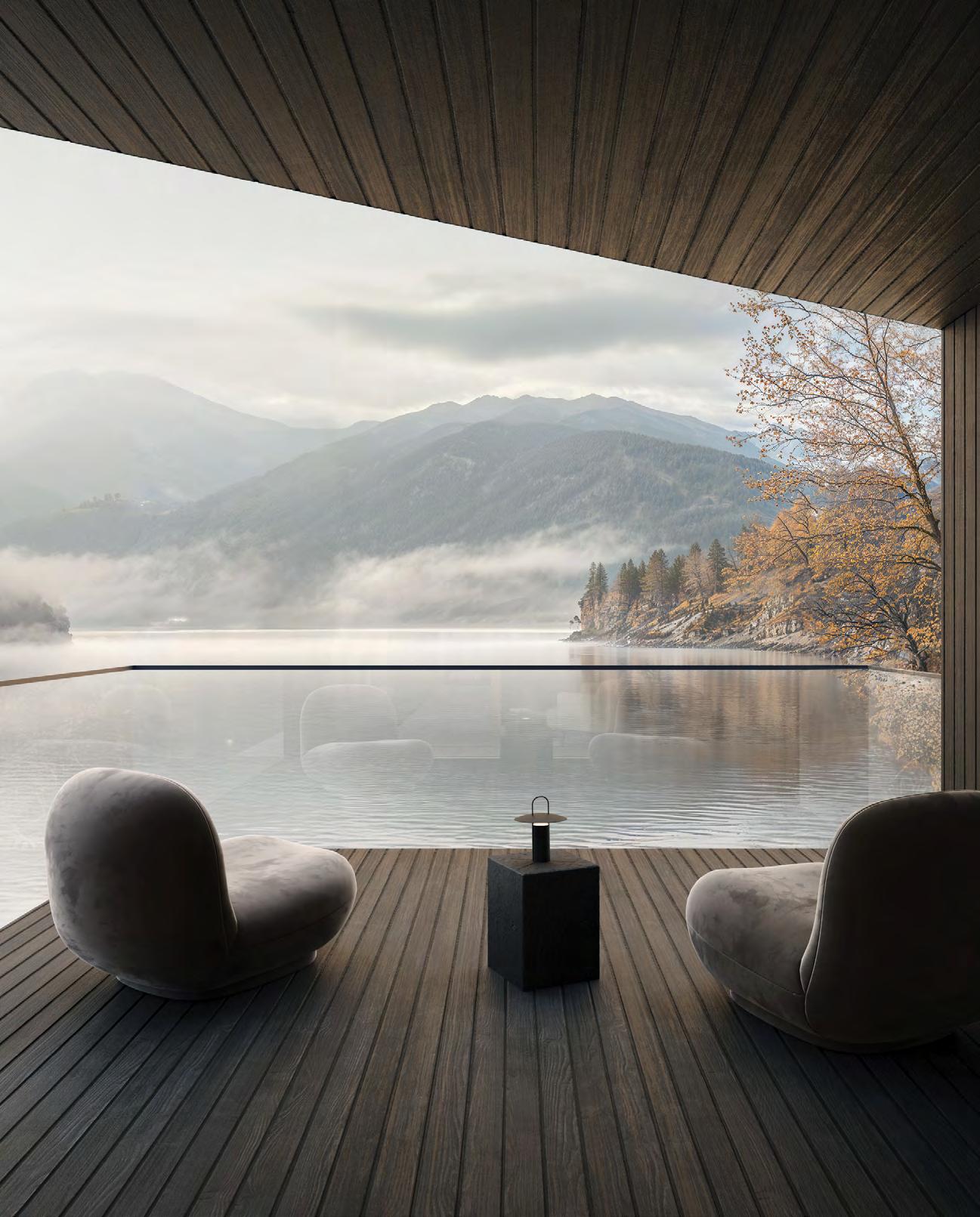


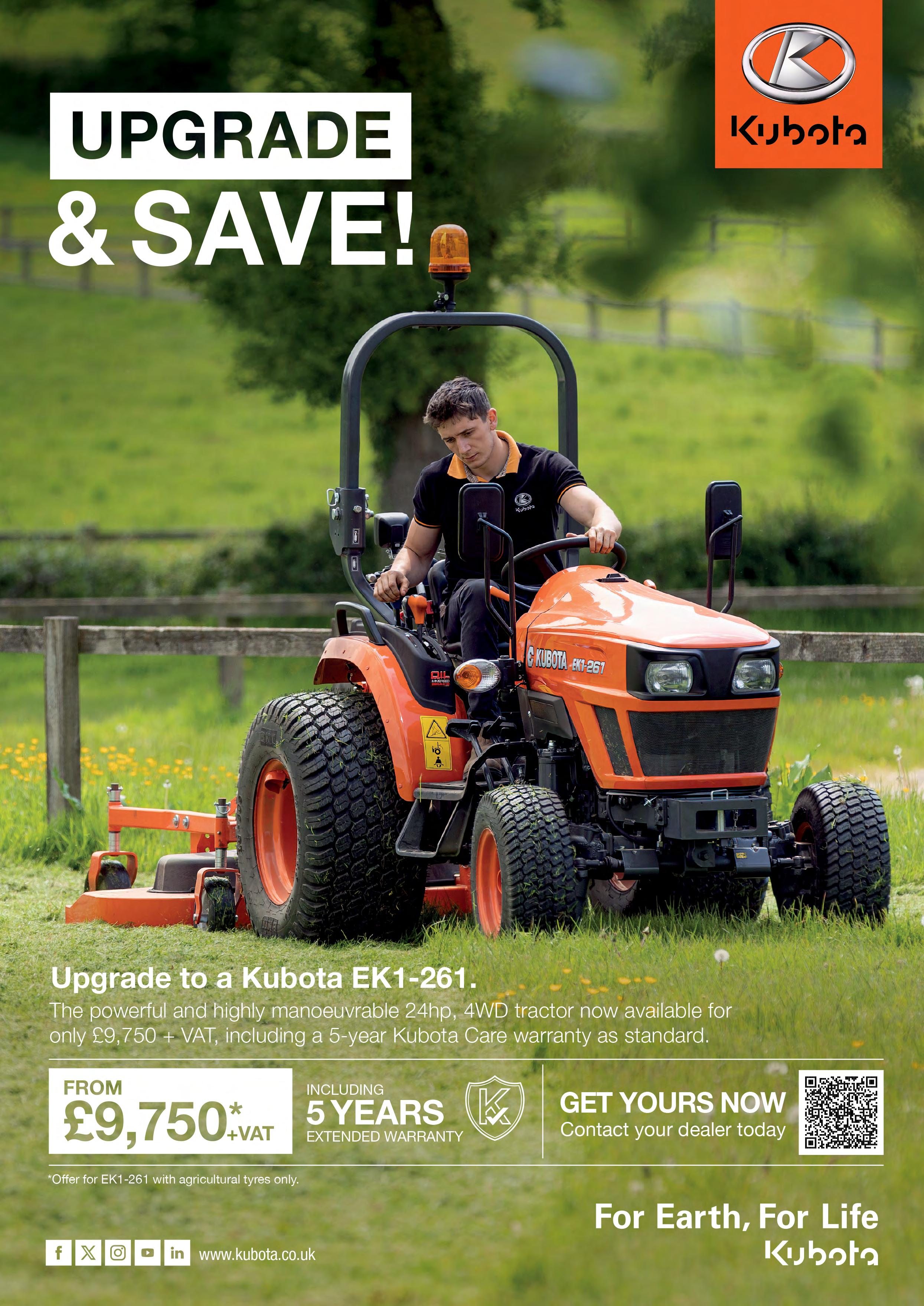
CASE STUDY
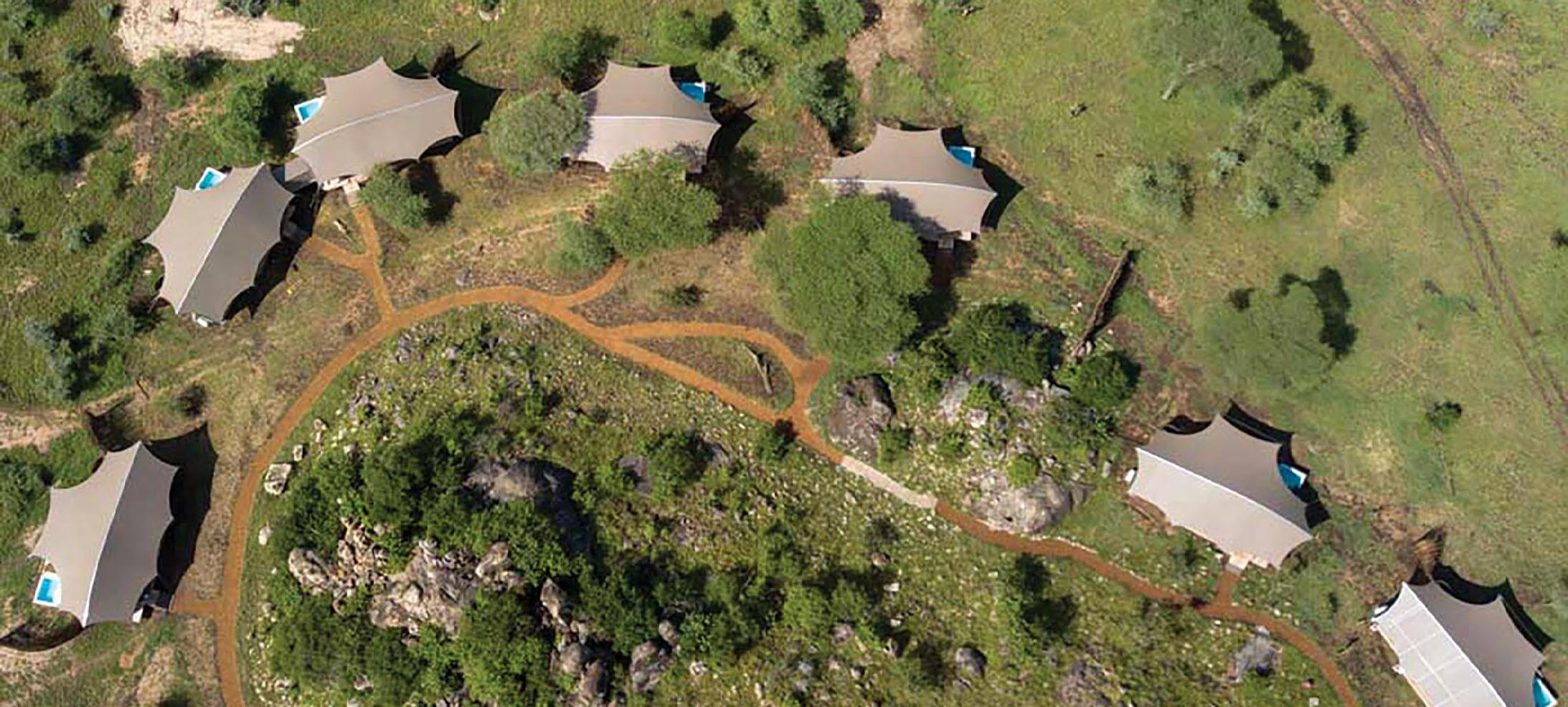
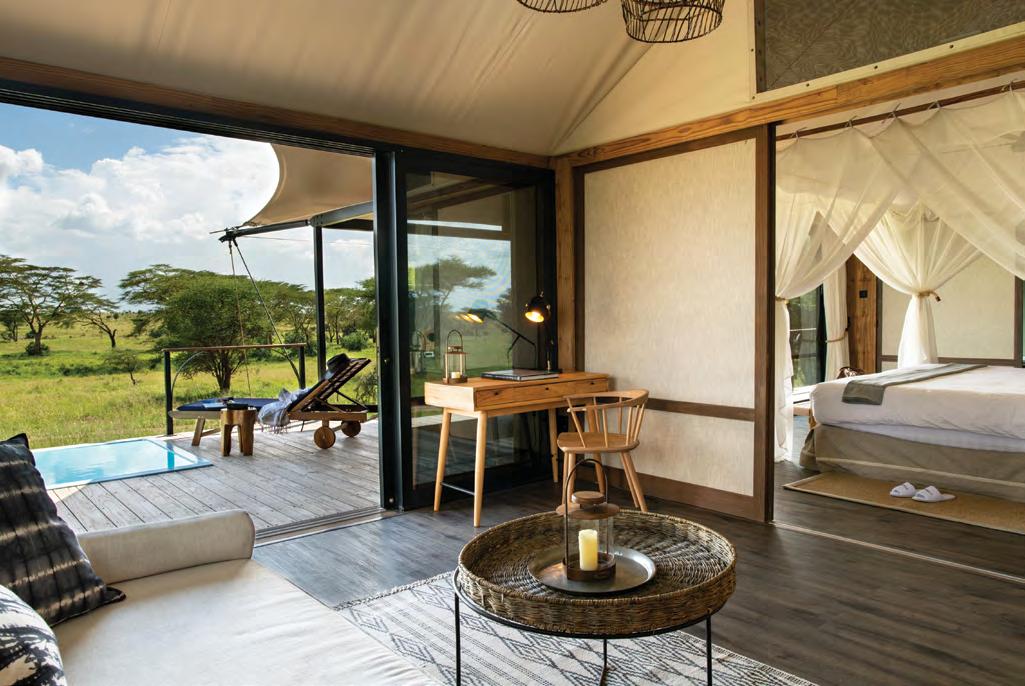
DESIGNED FOR IMMERSION, BUILT TO PROTECT, MADE FOR THE WILD TENTHOUSE STRUCTURES
Located in the heart of Tanzania’s Central Serengeti, Lemala Nanyukie is the result of a close, collaborative process between Tenthouse Structures and our partners in luxury eco- resort hospitality. This luxury camp comprises fifteen guest suites, including a family unit, and six main area structures, delivered as a fully integrated turnkey solution covering design, engineering, supply, and installation.
Rooted in the principles of lightweight, low-impact architecture, the camp layout responds directly to the natural topography. Suites are arranged organically around two granite “kopjies”, each carefully positioned to preserve privacy and maximise views, creating an uninterrupted dialogue between guest and landscape. Here, the experience of nature is ever-present, from watching giraffe on the deck to listening to lions at dusk.
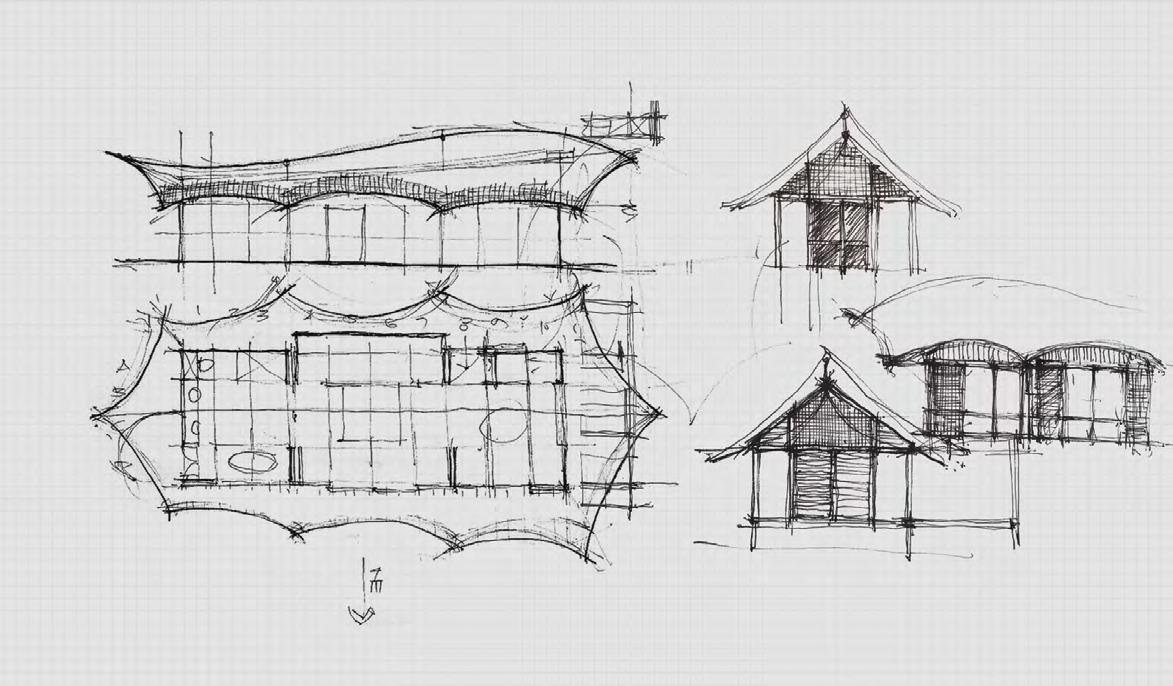
Each guest suite features a signature rolled ridge membrane roof and high-performance canvas envelope, engineered for comfort in the demanding African climate. Interiors are open, airy, and designed to flow effortlessly into the outdoors. A generous bedroom and lounge space opens onto a private deck, shaded seating area, outdoor shower, and a corner plunge pool. Blurring the line between comfort and wildness.
The six main structures carry the same architectural language: elegant, leafinspired tensile roofs with sculptural outriggers that sit lightly on the land. These spaces, the reception, lounge, dining areas, bar, and swimming pool feature double-volume interiors and are arranged to make the most of the Serengeti’s expansive vistas and golden sunsets, all while preserving the integrity of the surrounding environment.
A standout feature is the spa, discreetly nestled atop one of the granite outcrops. This elevated sanctuary offers a sense of complete retreat, where guests can reconnect with themselves while immersed in panoramic views of the plains.
Interior detailing embraces a contemporary safari aesthetic with natural textures, bespoke timber furniture, layered textiles, and soft lighting create a warm, grounded atmosphere. With a restrained palette and understated elegance, the interiors serve as a quiet backdrop to the vibrant, everchanging Serengeti.
From structural layout to interior fit-out, Lemala Nanyukie reflects Tenthouse Structures’ commitment to building refined, resilient, and regenerative spaces, a clear expression of our design philosophy: to tread lightly, design responsively, and create spaces where people and place connect meaningfully – #madeforthewild.
TENT FEATURE AUTENTIC CASE STUDY
HOW ONE TENT BOOSTED BOOKINGS AND REVENUE IN SPAIN

Located in the Alicante region of Spain, Oliveretes Glamping offers guests an immersive stay surrounded by Mediterranean nature, citrus groves and olive trees. The owners made a strategic decision to upgrade part of their accommodation setup by replacing their standard white bell tent with an Autentic Jack Bell Tent in moss green.
The motivation behind the switch was clear: to enhance guest comfort, improve the visual identity of the site, and increase revenue potential. The Jack Bell Tent offered several distinct advantages compared to the basic model it replaced, including the following:
for improved furnishing layouts and a more comfortable stay.
Wide front door opening: Enhanced natural light and ventilation, while creating a welcoming entrance that elevated the tent’s overall feel and a panoramic view from the inside of the tent.
Premium fabric and finish: The Jack Bell uses a heavy-duty polycotton canvas that performs better in both hot and humid conditions. It is more weather-resistant and durable than standard tent fabrics.
Functional detailing: Features like internal hanging points, zipped access for power cables, and a rollup groundsheet increased the tent’s usability for glamping operators and guests alike.
Visual impact: The moss green colourway blended harmoniously into the natural landscape and offered a distinctive, high-end aesthetic.
Following the installation, Oliveretes saw immediate business results. The upgraded tent allowed them to reposition it as a premium accommodation option, and they were able to increase the nightly rate by up to €100 compared to the previous setup. Feedback from guests highlighted both the comfort and design of the new unit.
From a business standpoint, the investment in Autentic’s Jack Bell Tent proved to be a practical and profitable choice. It not only improved the guest experience but also enhanced the site’s brand identity and long-term revenue potential.
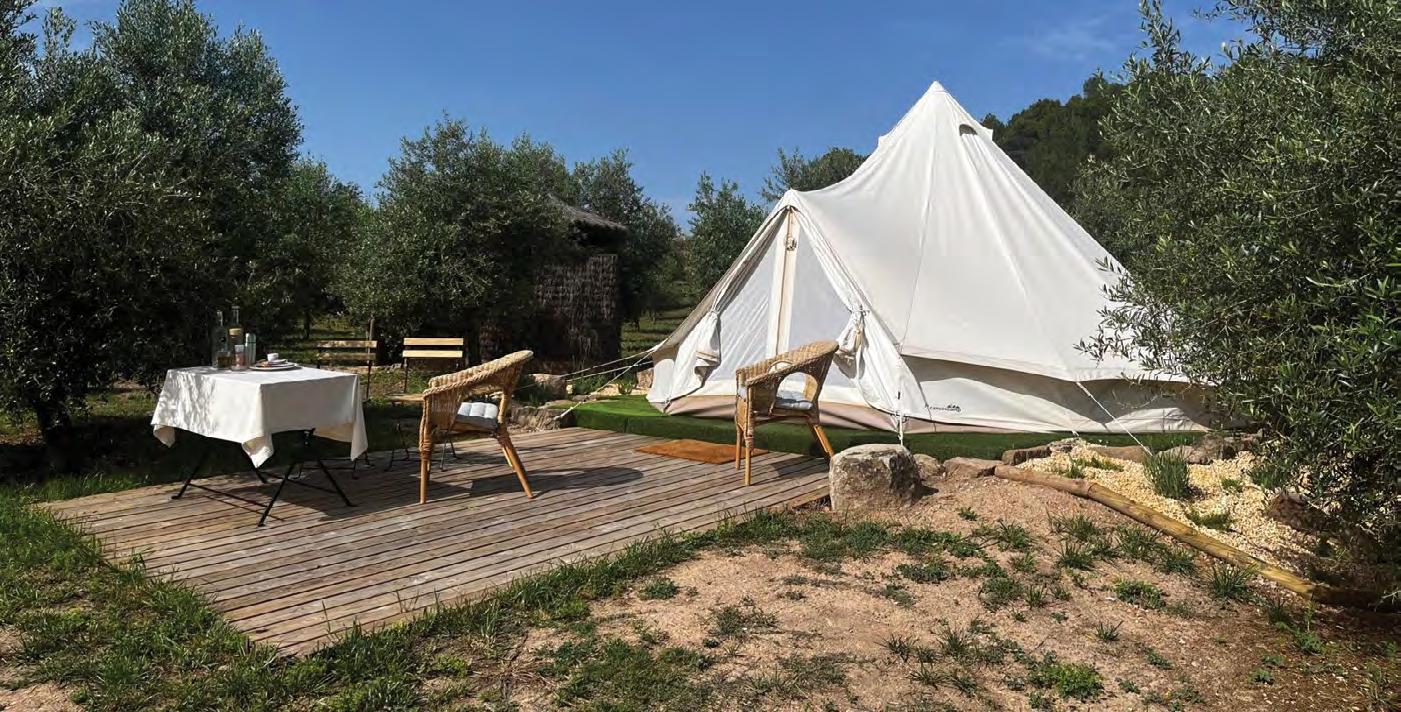
Vertical side walls (90 cm): These provided more usable interior space, allowing
CASE STUDY
THE EVOLUTION OF AMAYA TENTED CAMP BUSHTEC

In the heart of South Africa’s Timbavati Private Nature Reserve, Amaya is a newly developed, semi-permanent tented camp that exemplifies the art of transforming a site with sensitivity, precision, and vision. Also home to “Too Wild,” a wildlife filmmaking training facility, the location has now been reimagined into a luxury hospitality offering — one that remains intimately connected to nature, while delivering modern comfort and operational efficiency
Rather than impose a completely new footprint, the development retained and respected the layout of the original rondawel-style structures. This conscious
decision reduced environmental disturbance and ensured that Amaya’s integration into the surrounding landscape would be seamless and sustainable from the start.
Bushtec was commissioned to design, manufacture, and install the complete tented solution. The final result features nine guest accommodation units, a central gathering space, a yoga deck, and a swimming pool — all unified by a consistent design language that blends aesthetic restraint with thoughtful function. Working in tandem with Dynamic African Projects, who delivered the kitchen, staff accommodation, and storage facilities, the team created a fully operational camp that performs behind the scenes as elegantly as it presents itself to guests.
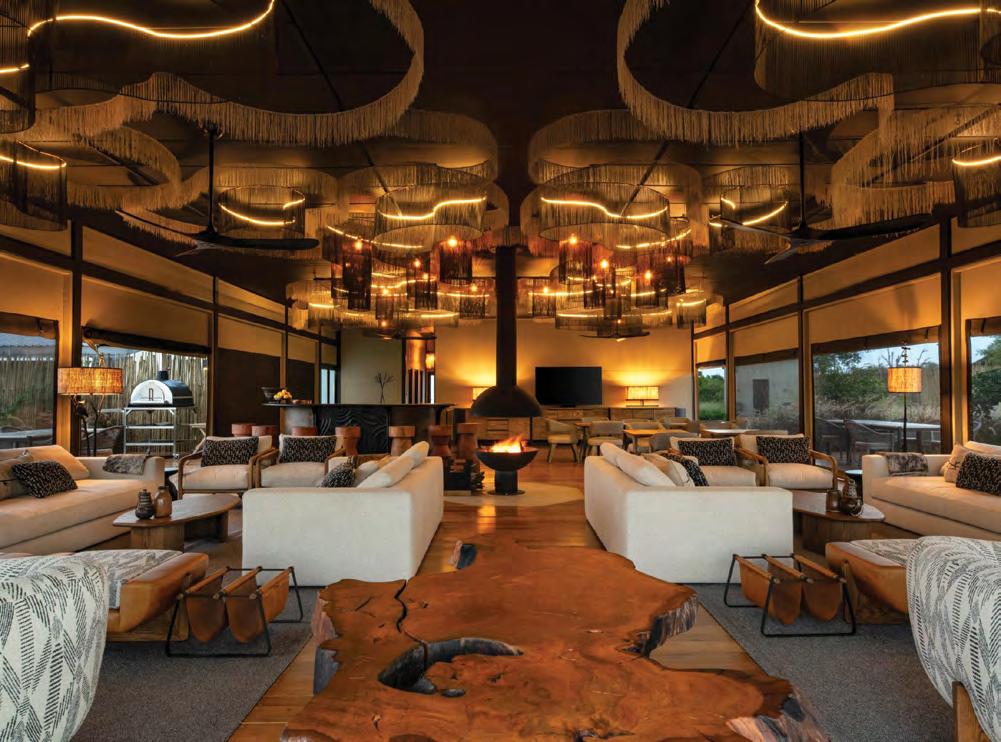
Each guest unit is constructed from a robust steel frame cladded in canvas, with a tented roof that reflects the tones of the bushveld. Interiors are spacious and versatile, designed with both comfort and flexibility in mind. In addition to a
generous bedroom, each unit includes a secondary room that can serve as an office or be converted into a second sleeping area, catering to varied guest profiles, from families to remote-working travellers.
At the heart of the camp, the main area continues this architectural language with a steel-framed, canvas-cladded structure and a steel roof engineered to support solar panels. This off-grid energy solution ensures Amaya’s energy independence and reinforces the camp’s long-term commitment to sustainable operations in a remote and ecologically sensitive environment.
Behind the scenes, modular back-of-house structures support all daily operations, from linen management to food preparation, efficiently placed to preserve the guest experience while ensuring seamless functionality.
Amaya’s transformation is a compelling example of what can be achieved through purposeful design, strategic reuse, and a strong collaborative process. From a specialised training camp to a modern, sustainable safari retreat, this project embodies a new generation of tented lodges – rooted in place, responsive to environment, and refined in execution.
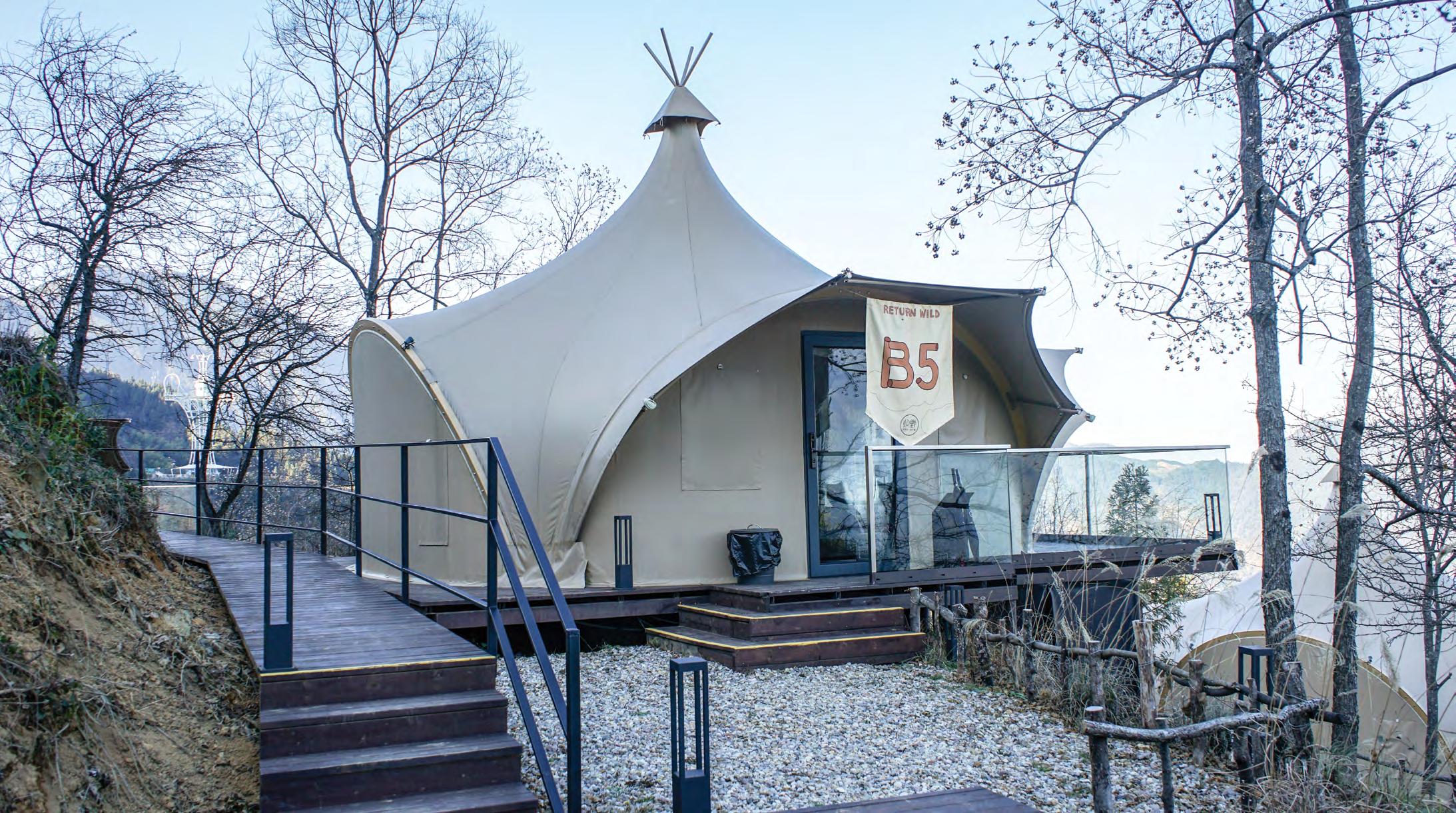
THE SYMBIOSIS OF WILDNESS AND LUXURY
As the early morning sunlight penetrates the mist, and dusk permeates the wilderness, the aesthetics of camping are quietly changing. Traditional tents are fading out, and a tent that combines the original Indian style with modern technology is reshaping the relationship between man and nature.
Design
Balance between wildness and order
The streamlined vault of the Liri Indian tent is derived from the wisdom of aboriginal architecture. The rough lines are reconstructed by geometric order, and the rough texture and precise arc form a delicate balance, which not only retains the original wildness, but also highlights the precision of modern craftsmanship.
Material
Fusion of function and aesthetics
The traditional wild style is matched with modern PVC tensile membrane fabric, giving the tent the ability to resist the forces of nature: windproof, flame retardant, heat-insulating, UV-proof, while retaining the flexibility of the fabric. The T6-grade aluminium profile frame is stable and light, and the customised
spraying allows the tent to blend into the camp environment, just like a naturally grown building.
Space
Unbounded reorganisation of city and nature
The no-column design breaks the boundary between the outdoors and the city. Wool carpets, leather sofas, fireplaces and wine cabinets – these urban elements are reorganised into spatial art in the tent. In the transparent curtain wall restaurant, the sun casts spots of light and raindrops
Concept
Life philosophy in balance
The LIRI Indian Tent is not only an innovation in camping methods, but also an expression of a life attitude: pursuing natural wildness without giving up quality; inheriting culture while incorporating innovation. This symbiosis of wildness and luxury reminds us to find a way to live in harmony with nature and the past and present in a fast-paced life.

play music, making dining a sensory experience beyond taste.

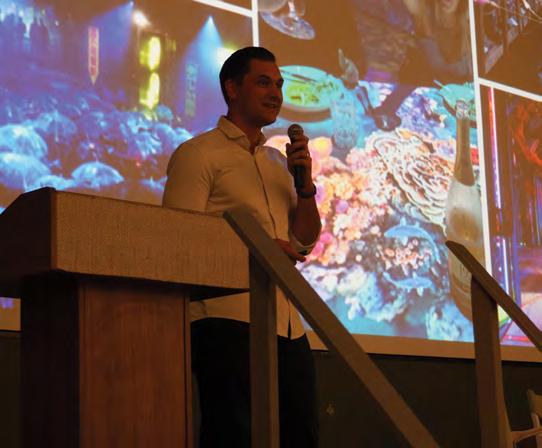

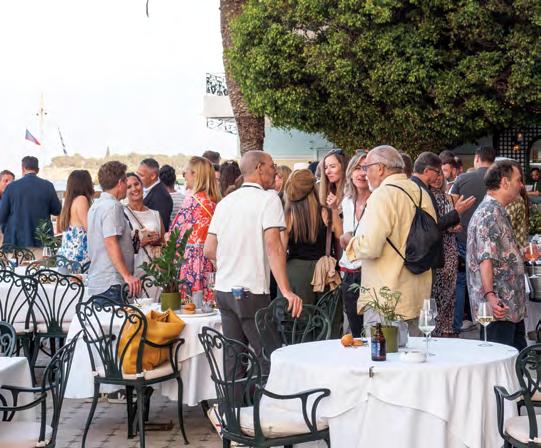
Remembering Eco Resort Network 2025 THANK YOU, SPETSES
The Eco Resort Network returned to Greece this spring for its fourth annual in-person gathering, hosted by Steph Curtis-Raleigh, publisher of International Glamping Business. Set against the elegant backdrop of the historic Poseidonion Grand Hotel on the island of Spetses, the boutique event brought together around 80 global leaders in eco resorts, glamping, and sustainable hospitality.
Over the course of three inspiring days, attendees immersed themselves in a thoughtfully designed programme blending a conference, social events and authentic Greek hospitality – all curated to spark meaningful connections and future collaborations.
Event Highlights
The event officially kicked off on 25 May with a relaxed and engaging “Paint & Sip” – an icebreaking afternoon of art, wine, and laughter. Followed by an official Welcome Reception, where guests mingled on the Poseidonion’s terrace over sunset cocktails, setting the tone for the days ahead.
The next two days featured a full schedule. Standout moments included:
n Keynotes and workshops delving into regenerative design, global sustainability trends, AI-driven storytelling and resilient resort development.
n A boat-trip to a traditional Greek restaurant, offering “networking in motion”.
n A final night party, ABBA-themed and full of energy, capping the event with music, dancing, and unforgettable memories.
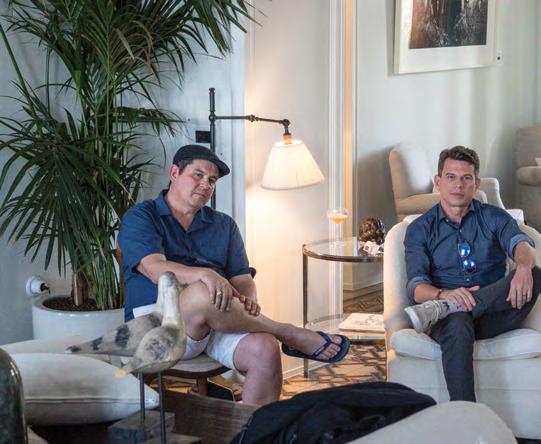
The intimate scale of the gathering was repeatedly cited as a key strength. As one delegate aptly summarised, “No industry event we are aware of compares to this… quality lectures, seamless entertainment, and life-long memories.”
Notable Sessions
A hallmark of the 2025 edition was the range of speakers and topics, with sessions spanning from cutting-edge tech to time-tested sustainability strategy.
n Whitney Scott (Walden) opened the conference with a powerful analysis on current trends, and how data can be used to positively impact your hospitality business.
n Daniel Hettwer (Hidden Worlds Entertainment) delved into “impacttainment” – a session on how entertainmentbased storytelling can shift public perception on environmental issues, leading to real-world action.
n Brendan O’Molony (Tenthouse Structures) led a fireside-style conversation, with all invited to share honest reflections on the challenges and triumphs of working in eco-hospitality – and where it’s headed in the future.
Connections & Community
Beyond the sessions, what truly defined the 2025 Eco Resort Network was community – a recurring theme echoed by nearly every participant.
“Eco Resort Network is setting standards. It has been a truly delightful gathering of outstanding people. No industry event we are aware of compares to this.”
- Glamping Advisors
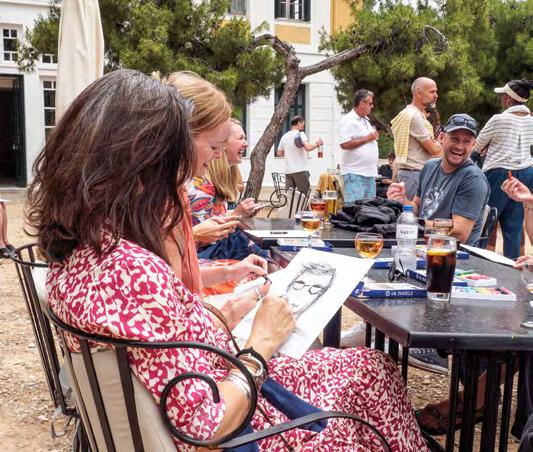
“This is bringing community to another level. Conversations, perspectives and connections went far beyond.”
- Lynn Grijp, Autentic
“Above all, this is about community – learning from brilliant minds, reconnecting with industry friends, and meeting new people who share our passion for a more responsible hospitality.”
- Chris Nader, ENVI Lodges
“A perfect balance of learning and leisure. From the knowledge-packed sessions to the ABBA party, everything felt thoughtfully curated to help us connect on every level.”
- Robyn Woodhead, White Desert
“The boat trip dinner was a highlight –combining networking with authentic local culture and stunning scenery. Moments like that create real bonds.”
- Chris Nader, ENVI Lodges
“What stands out is the genuine community feel. Everyone came ready to share insights openly, no sales pitches, just real talk about building sustainable resorts.”
- Gene Eidelman, Azure Printed Homes
Final Take
The Eco Resort Network 2025 gathering reaffirmed the value of small-scale, highimpact events within the sustainable hospitality space. As one participant observed, great ideas may begin in the conference room, but lasting impact grows through the conversations, shared meals, and communal moments that follow. www.ecoresort.network
